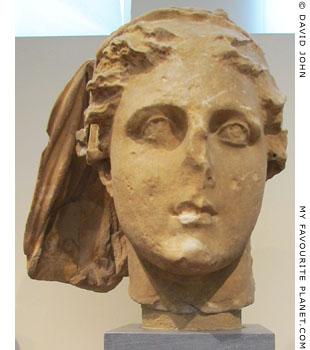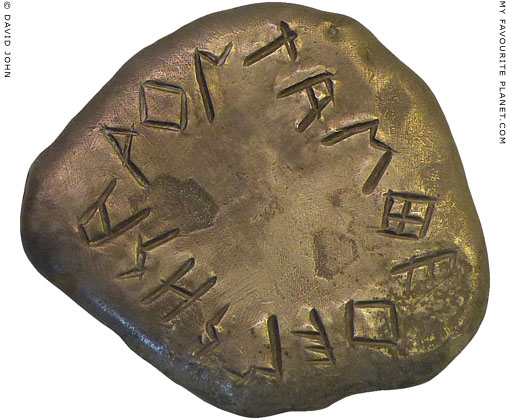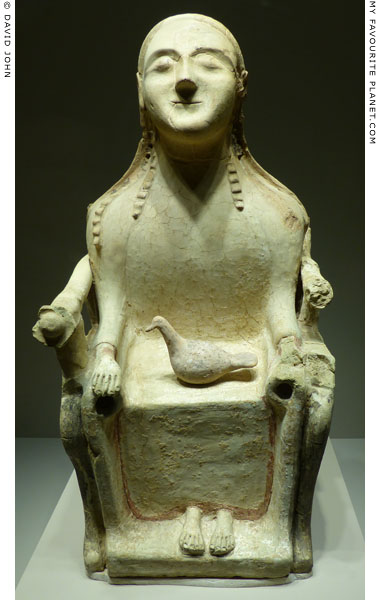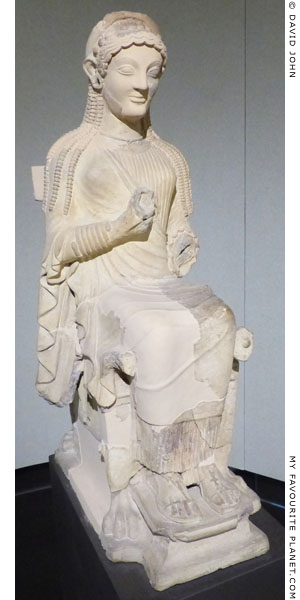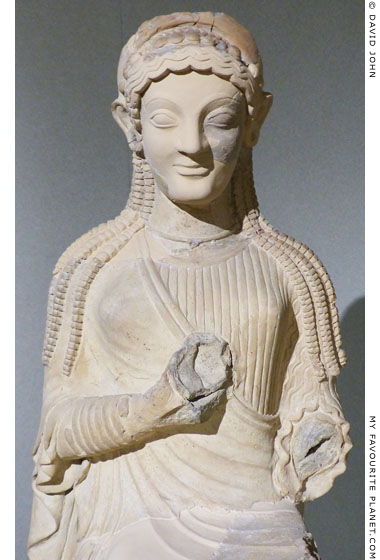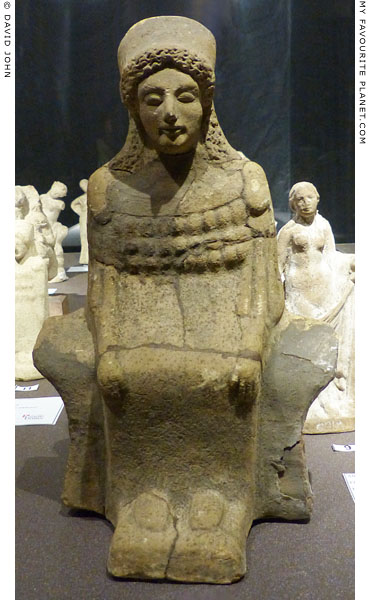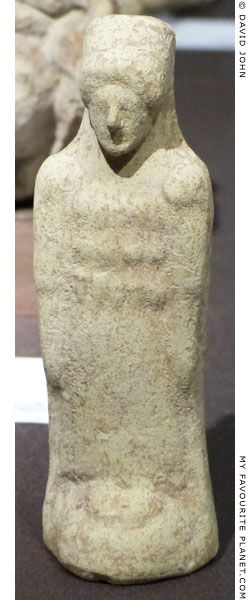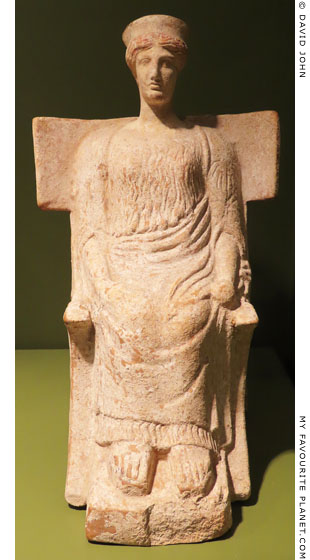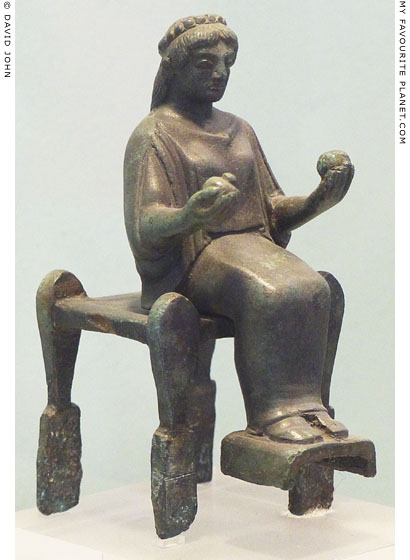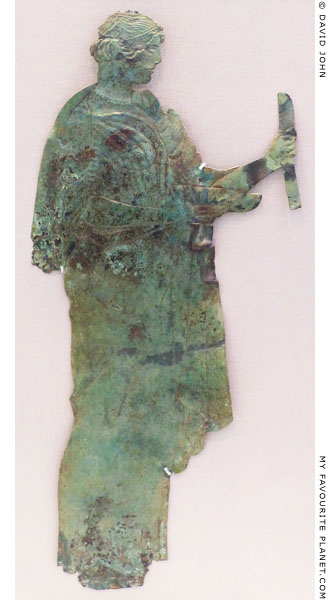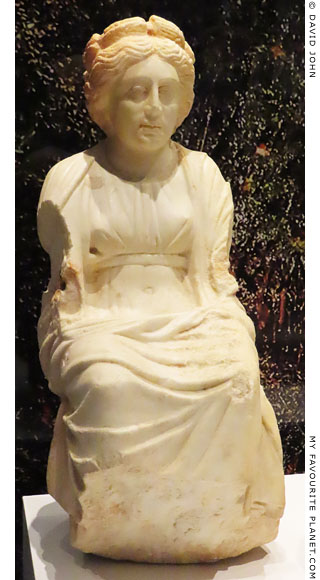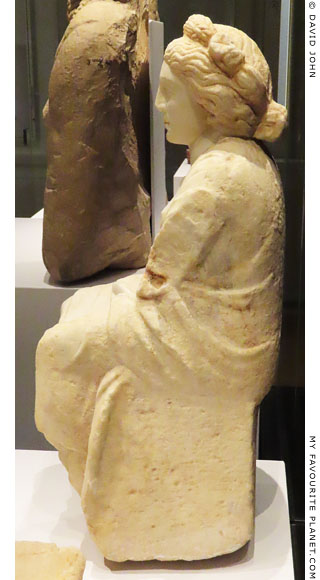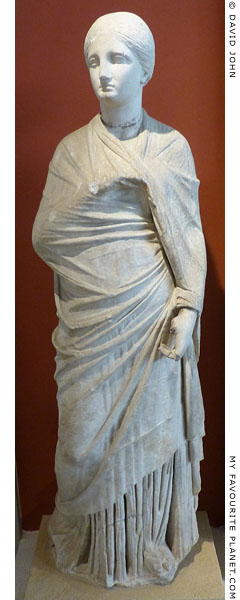| |
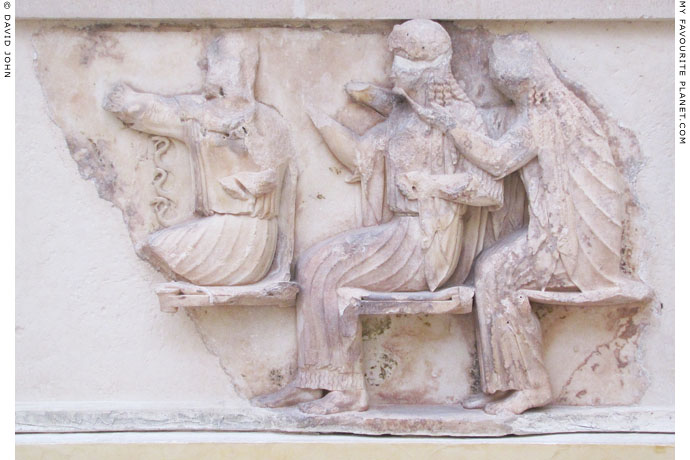
A fragment of a relief with a depiction of three goddesses, identified as Athena,
Hera and Demeter, from the east side of the frieze of the Siphnian Treasury, Delphi.
The treasury was built for the people of the Aegean island Siphnos
around 525 BC (before 524 BC). Parian marble.
Delphi Archaeological Museum, Greece.
|
The entablature of the Ionic treasury was decorated with a frieze on all four sides, each with a long relief depicting a mythological theme. The pedimental relief at the rear of the building, the east side, parts of which have survived, depicts Zeus intervening in the struggle between Apollo and Herakles when the latter attempted to steal the oracular tripod from Apollo's temple at Delphi.
The theme of the frieze relief below the east pediment is the Trojan War (see Homer), divided into two scenes. The scene on the left (south) side is an assembly of the Olympian gods. Those who sided with the Trojans (Ares, Aphrodite, Artemis and Apollo) are seated to the left, and the supporters of the Achaeans (Greeks) on the right (Athena, Hera and Demeter). The supreme god Zeus is enthroned in the centre, and a now missing part of the scene is thought to have shown the figure of Thetis, the mother of the Greek hero Achilles, pleading with Zeus for her son's safety (see Homer part 2).
The scene on the right (north) side of the relief shows a battle around the body of a fallen warrior between Trojans, fighting from the left and Achaeans (Greeks) on the right. On the far right, the elderly Nestor urges the Achaeans on.
The identifications are those on the museum labels. The names of the characters in the relief were originally painted next to the figures, but most are now partly or wholly illegible. A number of scholars have attempted to reconstruct the inscriptions and identify the figures, leading to much conjecture and debate. According to other interpretations of a faint and fragmentary inscription, the figure usually identified as Demeter may be Thetis or Themis.
See images of the entire east pediment and frieze relief in Homer part 2.
See also a relief of Demeter and Persephone from the north side of the frieze below.
The unknown sculptor of the frieze reliefs on the north and east sides of the Siphnian Treasury has been named "Master B", while the artist who made the south and west reliefs is known as "Master A". See the Aristion of Paros page for further details. |
|
| |
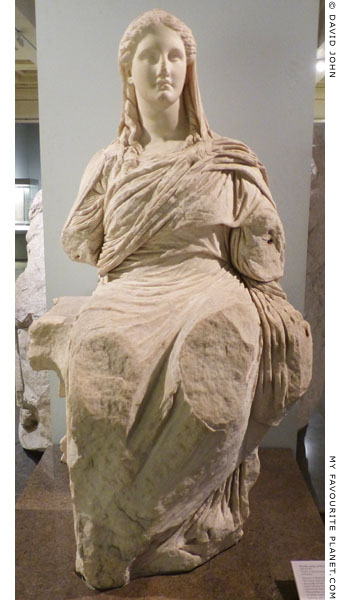 |
|
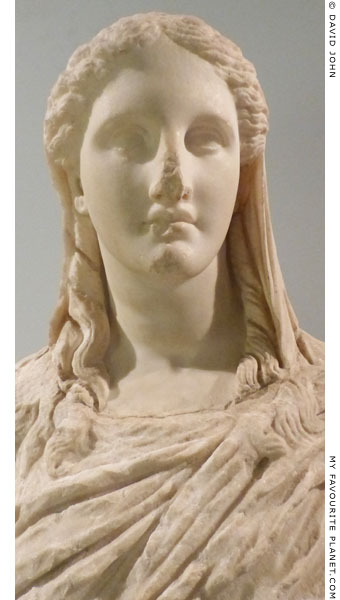 |
Life-size marble statue of enthroned Demeter, known as "Demeter of Knidos". 350-330 BC.
Excavated in 1858 by the British archaeologist Charles Thomas Newton,
in the sanctuary of Demeter at Triopion (Τριόπιον), Knidos, Caria
(Yazıköy, Muğla Province, Turkey). [1] Height 152 cm.
British Museum. Inv. No. GR 1859.11-26.26 (Sculpture 1300).
|
|
The top and back of the head as well as the torso and legs of the figure are covered by a himation (cloak). In classical art, a person or deity depicted with the the top of the head covered in this way is usually referred to as "veiled".
The head was sculpted separately from the body using finer marble. Her face appears elongated, with a long nose and cheeks, as well as a high forehead and hairline. The folds of the garments are exceptionally deep around her breast and left shoulder. The lower arms and hands are missing, but she probably held a libation bowl or torch. The goddess is depicted as the epitome of Greek womanhood, serene, mature, motherly and modestly veiled. It is thought that a statue of her daughter Persephone may have stood next to her. |
|
| |
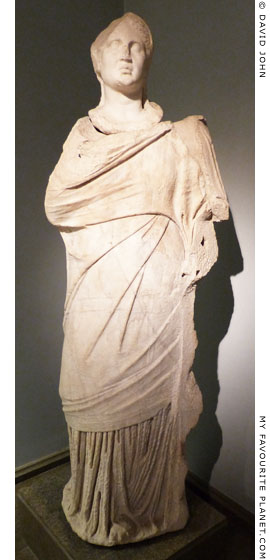
Marble statue, perhaps
a priestess of Demeter.
2nd century BC. Excavated in 1858
by Charles Thomas Newton in the
sanctuary of Demeter, Knidos.
[see note 1]
A mature woman wearing a himation
over a chiton. The head was sculpted separately and inserted into the body.
British Museum.
Inv. No. GR 1859.11-26.25
(Sculpture 1301). |
|
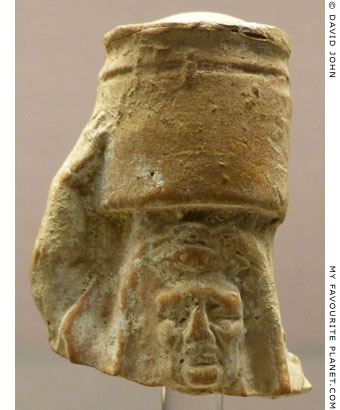
Terracotta head of an old woman, perhaps
Demeter, made at Knidos around 300 BC.
Excavated in 1858 by Charles Thomas Newton,
in the sanctuary of Demeter, Knidos, Caria.
[see note 1]
While Demeter was searching for Persephone
she took on the form of an old woman called
Doso (Δώσω, Giver) and was offered hospitality
in Eleusis by King Keleos and Queen Metaneira.
The object she carries on her head may be the
sacred kiste (cista mystica), which contained
the sacred objects of the Mysteries.
British Museum. Inv. No. GR 1859.12-26.174.
See also a statuette of Persephone
from Knidos below. |
|
| |
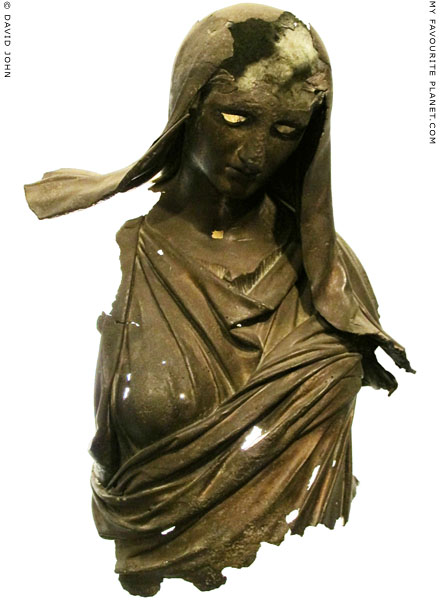
Part of a bronze statue of a veiled female, thought to
depict Demeter. Found in 1953 by sponge fishermen in
the sea near Bodrum (ancient Halicarnassus), Turkey. [2]
Hellenistic period, 4th century BC. Height 81 cm.
Izmir Archaeological Museum. Inv. No. 3544. |
| |
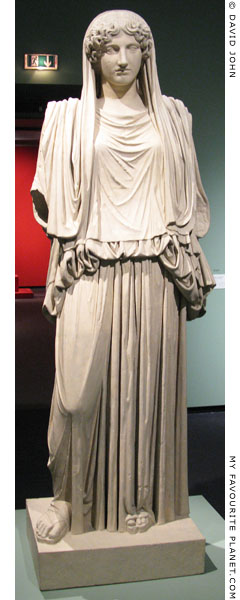 |
|
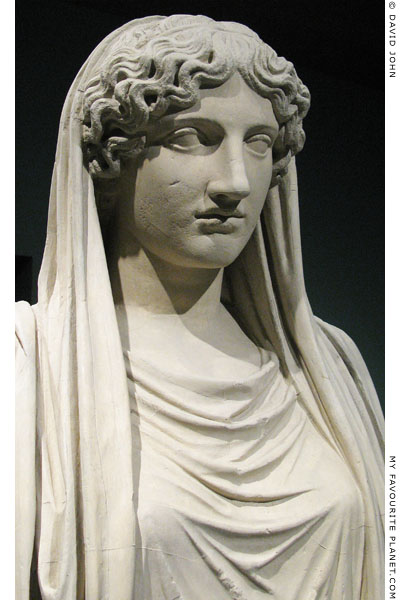 |
Plaster cast of a "Demeter Cherchel" type statue. Height without base 233 cm.
Antikensammlung, Berlin State Museums (SMB).
|
|
The marble original in the Altes Museum, Berlin (see photo below) is thought to be a Roman period copy, made around 150 AD, of a lost work of circa 450 BC. It is one of a number of similar, over-lifesized statues of the type named after the two examples discovered in Cherchel (Caesarea Mauretaniae), now in the Archaeological Museum of Cherchell, Algeria.
The cast does not include the modern lower arms and attributes which were added to the statue during restorations in the 18th and 19th centuries. The original was recorded by Ulisse Aldrovandi in the mid 16th century (Delle statue antiche ..., in Le antichita de la citta di Roma, 1556, 1558, 1562) as standing in the garden of the Palazzo Soderini, Rome. It was purchased in Rome by the art dealer Giovanni Ludovico Bianconi in 1766 for King Friedrich II of Prussia (Frederick the Great, 1712-1786) who placed it outside the Neue Palais, Sanssouci, Potsdam (see photo below). |
|
| |
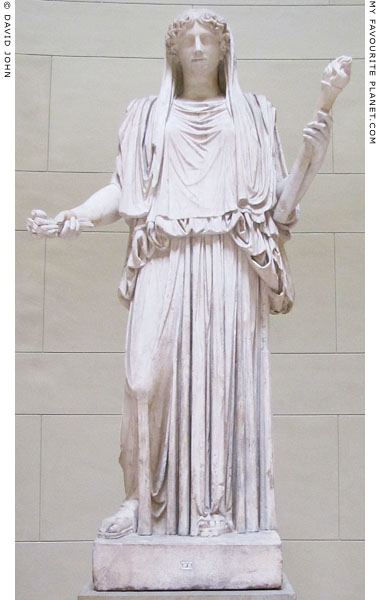
The "Demeter Cherchel", with the restored arms and hands, in the
dimly-lit rotunda of the Altes Museum, Berlin. The veiled figure holds
a torch in the left hand and poppies and ears of grain in the right.
White, fine crystalline marble with grey discolouring.
Height with base 361 cm, without base 233 cm, width 120 cm,
depth 74 cm. Height of face (hairline to chin) 20 cm.
Altes Museum, Berlin. Inv. No. Sk 83. |
| |
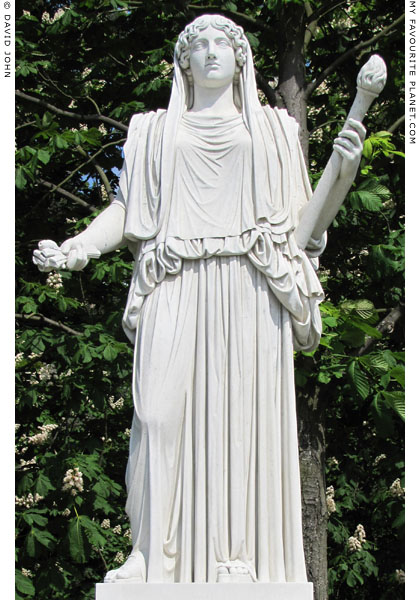
A copy of the restored Berlin "Demeter Cherchel" in Sanssouci.
Made 1848-1859 by Alessandro and Francesco Sanguinetti [3].
Exhibited in the Half Rondel, in the gardens of
the Neues Palais, Sanssouci, Potsdam, Germany. |
| |
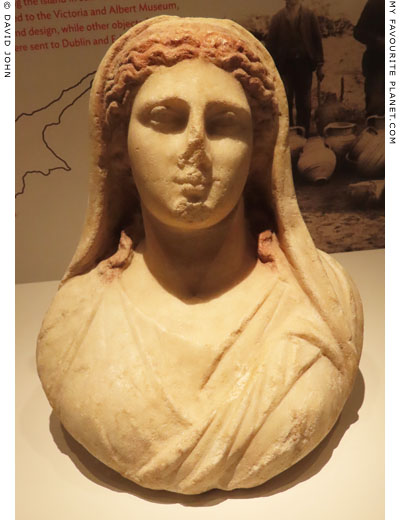
A marble bust of a veiled female from Limassol, Cyprus.
The subject is described by the museum labelling merely as "a woman",
without further explanation. It is not clear whether it is thought to be a
portrait of a mortal or representation of a goddess, perhaps Demeter.
Classical or early Hellenistic period, 475-312 BC. Found on Agkiras Street, Limassol.
Limassol Archaeological Museum.
Exhibited in the exhibition Cyprus - Eiland in beweging (Cyprus - a dynamic island),
Rijksmuseum van Oudheden, Leiden, Netherlands, 11 October 2019 - 15 March 2020.
See more about the worship of Demeter and Persephone on Cyprus below. |
| |
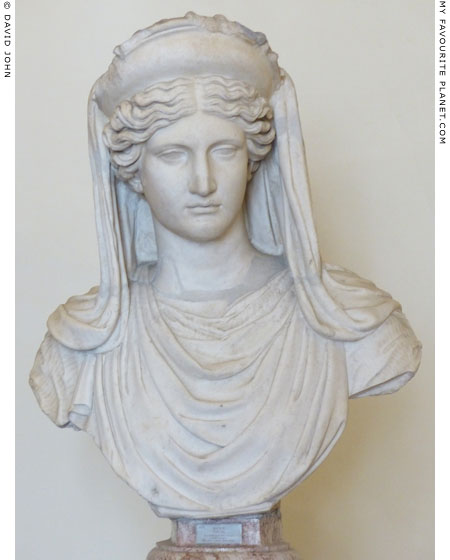
Marble bust of Demeter wearing a veil and high diadem.
Provenance unknown. Coarse-grained marble. A 2nd century AD Roman copy
after Greek prototypes of the 5th - 4th century BC. It may be an idealized
portrait of a member of the Roman imperial family. The diadem was originally
decorated with small pearls, now lost. The tip of the nose has been restored.
Palazzo Altemps, National Museum of Rome, Italy. Inv. No. 8596.
Boncompagni Ludovisi Collection, from the Cesi Collection. |
| |
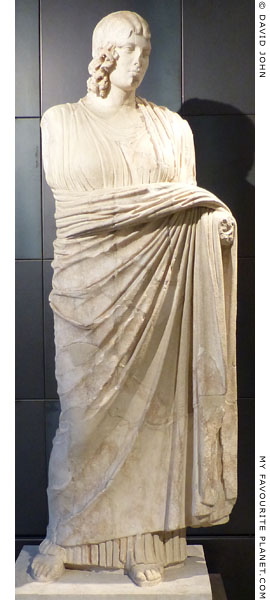 |
|
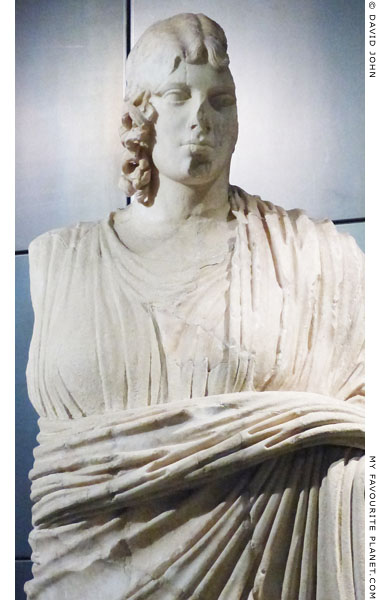 |
Colossal marble statue of Demeter.
Pentelic marble. Roman period copy after a Greek original of the 5th century BC.
From the Horti Maecenatiani (Gardens of Maecenas), Rome. Found in 1876 in the
area of the Auditorium. The statue probably stood in a devotional site in the gardens.
Several ancient artefacts have been discovered at this location, including a number
associated with the worship of Dionysus (see the Dionysus page).
Palazzo dei Conservatori, Capitoline Museums, Rome. Inv. No. 905. |
|
| |
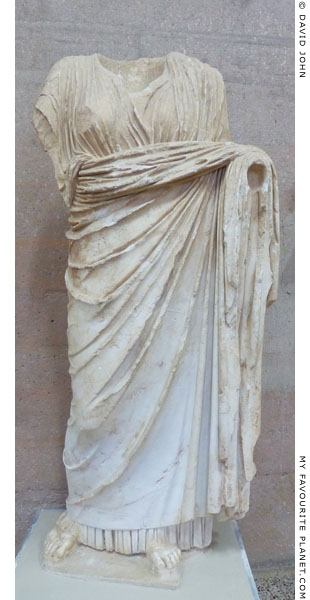
Over lifesize marble statue of Demeter.
Early Roman period. From the Peribolos
of Apollo in the Forum of Ancient Corinth.
Corinth Archaeological Museum.
Inv. No. S 67. |
|
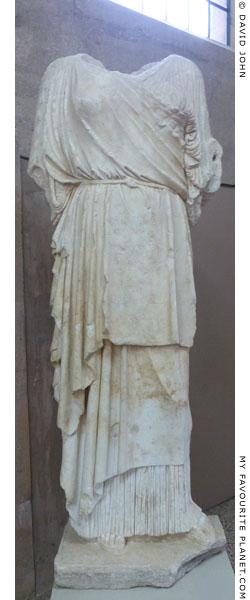
Over lifesize marble statue
of Demeter or Persephone.
Roman copy of a 5th century BC original.
From the Peribolos of Apollo, Corinth.
Corinth Archaeological Museum.
Inv. No. S 68. |
| |
| See also the sanctuary of Demeter and Kore at Corinth in Part 1. |
|
| |
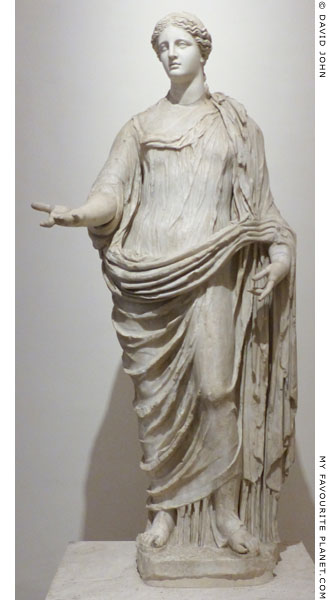 |
|
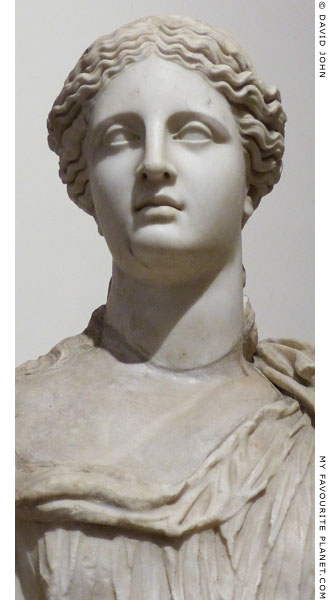 |
Marble statue of Demeter.
Coarse-grained marble. Roman Imperial period.
The figure wears an elegant, tightly clinging garment, slipping at the right
shoulder, typical of statues of Aphrodite and also of portraits of women of
imperial rank. It was restored with arms and a head resembling portraits of
Faustina the Younger (see below), and later the head was replaced with the
present one. The modern identification of the figure as Demeter is based on
the gesture of the outstretched right hand, indicating a product of the earth.
Palazzo Altemps, National Museum of Rome. Inv. No. 8546. Ludovisi Collection. |
|
| |
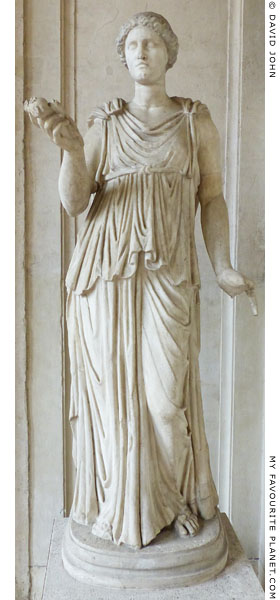 |
|
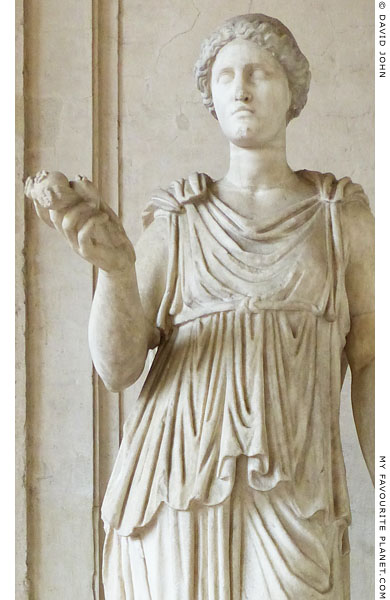 |
Marble statue of Demeter holding poppies and ears of corn in her raised right hand.
Courtyard of Palazzo Altemps, National Museum of Rome. Not labelled, Inv. No. 49 (?). |
|
| |
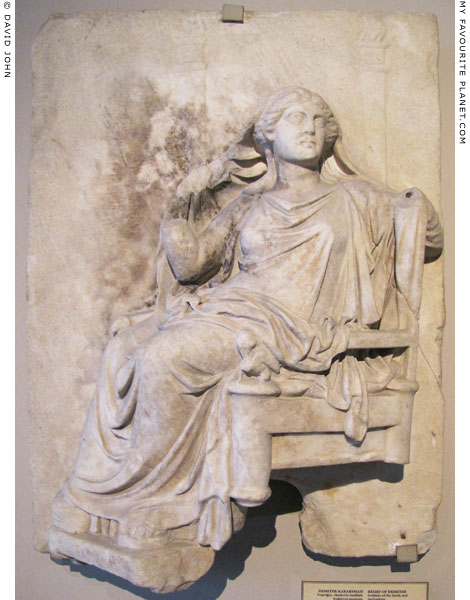
Marble relief of Demeter, veiled and enthroned.
From Kozçeşme village (Biga/Çanakkale), northwestern
Anatolia, Turkey. Late Classical period, 4th century BC.
The enthroned figure turns her head and torso to her left. With her
right hand she pulls at the edge of her himation (cloak), part of
which covers the top of her head. Her left arm rests on the back
of the throne. Behind her stand two long torches in lower relief.
Istanbul Archaeological Museum. Inv. No. 4942 T. |
| |
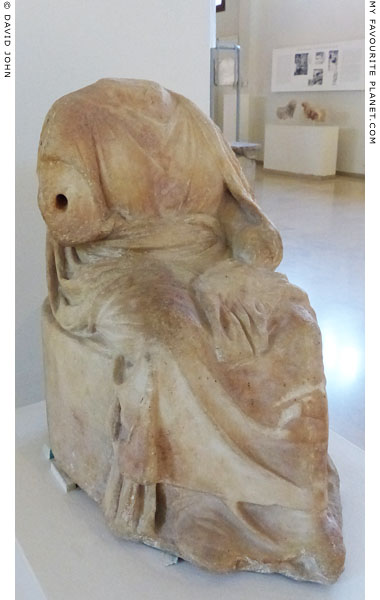
Headless marble statuette of Demeter sitting
on the sacred kiste (cista mystica), the chest
in which the sacred cult objects were kept.
From the Sanctuary of Isis, Dion.
Late 4th century BC.
Dion Archaeological Museum. |
|
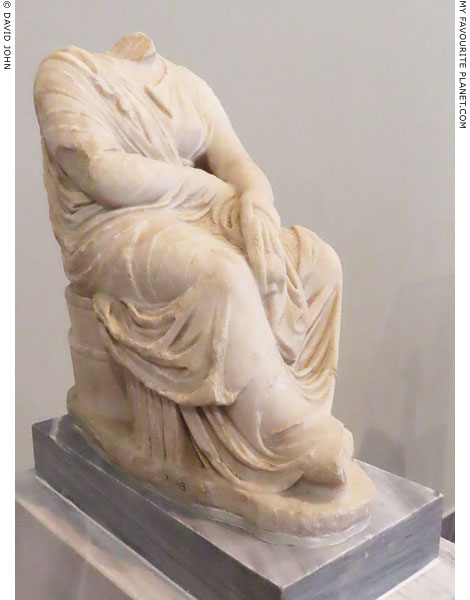
Headless marble statuette of Demeter sitting on the sacred
kiste. Found in the Ancient Agora, Athens. Probably from the
City Eleusinion (see part 1). The gooddess is wrapped in a
himation (cloak) over a chiton (tunic). In her left hand, which
rests on her lap, she holds a poppy and ears of corn.
Roman period copy of an original of the first
half of the 4th century BC. Pentelic marble.
National Archaeological Museum, Athens. Inv. No. 3989. |
|
| |
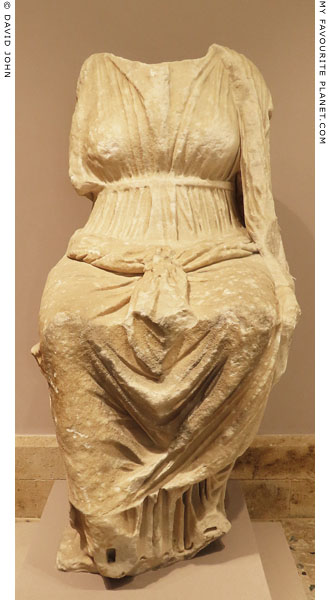
Headless, larger than lifesize marble statue
of Demeter or Kybele enthroned.
Early 1st century BC. Found in Kephalos.
Kos Archaeological Museum. |
|
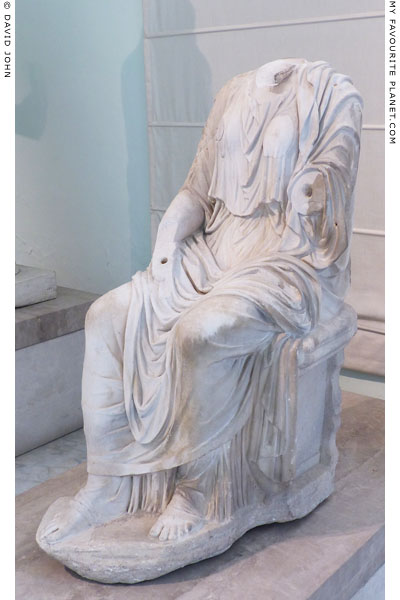
The so-called Ceres, a marble statue of an
enthroned goddess. End of the 1st century AD.
National Archaeological Museum, Naples.
Inv. No. 6263. Farnese Collection. |
|
| |
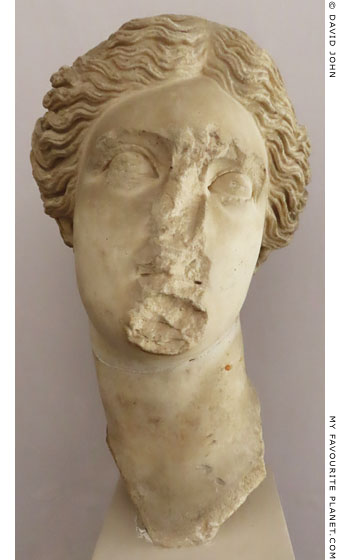
Colossal marble head from a statue of Demeter.
Antonine era (138-161 AD) copy of a 2nd century BC Hellenistic original.
Kos Archaeological Museum. Formerly in the house of Mayor Nikolaides. |
| |
|
A marble statuette of seated Demeter.
Found in the "Villa of Theseus", Nea Paphos, southwestern Cyprus. 100-300 AD.
Paphos Archaeological Museum, Cyprus.
Exhibited in the exhibition Cyprus - Eiland in beweging (Cyprus - a dynamic island),
Rijksmuseum van Oudheden, Leiden, Netherlands, 11 October 2019 - 15 March 2020.
|
The head was found by Polish archaeologists in Room 18 of the large Roman period palace or villa known as the "Villa of Theseus" in Nea Paphos (Πάφος), during excavations there in 1966-1967. It was matched with the rest of the statuette which had been found in the area before the excavations. The function of Room 18 and adjoining rooms is unknown, but they may have been used for cult practices.
Named after a floor mosaic with a depiction of Theseus in the Cretan Labyrinth, the villa has become well-known for its mosaics. However, a large number of statues of deities and mythical heroes were also discovered in various rooms. Two other statuettes, perhaps depicting Demeter and Persephone, were also discovered in Room 18 (see below).
This small figure depicts a female, apparently in middle age, wearing a crown, probably of corn, a long chiton (tunic) girdled just below the breast, and a himation (cloak) over her shoulders and back. Her wavy hair is parted in the middle and tied in a bun at the back. The arms, lower legs and feet are now missing. Presumably she originally held one or more objects, perhaps as attributes of the goddess. The statuette may have originally been placed in a niche (although no remains of alcoves have yet been discovered in the room) and designed to be viewed from the front. Her seat is merely a block with no carved details, but may represent the sacred kiste (cista mystica).
See: Panayiotis Panayides, Villa of Theseus, Nea Paphos: Reconsidering its sculptural collection. In: Richard Maguire and Jane Chick (editors), Approaching Cyprus, Proceedings of the Post-Graduate Conference of Cypriot Archaeology (PoCA), University of East Anglia, 1st - 3rd November 2013, chapter 14, pages 228-243, particularly pages 231-234. Cambridge Scholars Publishing 2016. At academia.edu.
The article includes a plan of the Villa of Theseus showing findspots of individual sculptures (with photos) and a bibliography. It provides a good introduction to Hellenistic and Roman period statues from Cyprus and a starting point for discovering further information about a subject rarely dealt with in depth. Unfortunately, there is very little detailed literature on the subject online.
There appears also to be very little current information about the cult of Demeter and Persephone on Cyprus, and few mentions in ancient literature. Grain-harvesting on Cyprus was known as damatrizein (δαματρίζειν).
In Metamorphoses the Roman poet Publius Ovidius Naso (43 BC - 17/18 AD) described the festival of first fruits (the Thesmophoria) in Cyprus as a poetic backdrop to his retelling of the mythical tale of the incestuous liaison between Cinyras, king of Paphos (Cyprus), and his daughter Myrrha, during which Adonis was conceived. In Ovid's version, the story is recited by Orpheus, who relates that the "sinful act" occurred while Cinyras' wife Cenchreis was attending the festival, during which women participants abstained from sex:
"The married women were celebrating that annual festival of Ceres, when, with their bodies veiled in white robes, they offer the first fruits of the harvest, wreathes of corn, and, for nine nights, treat sexual union, and the touch of a man, as forbidden. Cenchreis, the king’s wife was among the crowd, frequenting the sacred rites."
Ovid, Metamorphoses, Book 10, lines 431-502. Translated by Anthony S. Kline, 2000. At the Ovid Collection, University of Virginia. |
|
| |

A marble statuette base excavated at Kourion, Cyprus inscribed with an ex-voto dedication
to Demeter and Persephone in Greek and Cypro-syllabic script. The findspot, north of the
acropolis, known as "Site C" or "Temple Site", may have been a rural sanctuary of Demeter.
Around 350-300BC. Found in April 1895 during the British Museum Turner Bequest
excavations at Kourion (Κούριον; Latin, Curium; modern Episkopi, Επισκοπή)
on the south coast of Cyprus. Height 7 cm, length, 28 cm, depth 16.5 cm.
British Museum. Inv. No. 1896,0201.215. Inscription 968.a. Acquired in 1896.
Photo © the Trustees of the British Museum. |
| |
The Greek inscription:
Δήμητρι καὶ Κόρηι εὐχὴν
Ἑλλόοικος Ποτείσιος ἀνέθηκε
Transliteration of the text in Cypro-syllabic script, on a single line with dots between the words:
ta-ma-ti-ri · ka-se · ko-ra-i · e-lo-wo-i-ko-se ·
po-te-si-o-se · a-ne-te-ke · i-tu-ka-i
To Demeter and Kore, Helloikos the son of Poteisis dedicated this as a vow.
Inscription I.Kourion 26 (also ICS² 182)
at The Packard Humanities Institute.
See:
research.britishmuseum.org/...
(British Museum Collection Online)
F. H. Marshall, The collection of ancient Greek inscriptions in the British Museum, Part IV, section II: Supplementary and miscellaneous inscriptions, No. DCCCCLXVIIIA (968 a), page 130. Clarendon Press, Oxford, 1916.
The dating of the inscription to the second half of the 4th century BC is based on the style of the Greek lettering.
During the same excavation fragments of marble statues and a large number of terracotta figurines of male and female votaries, horse-riders and charioteers were also discovered at the site. The finds date from the 4th century BC to the end of the Hellenistic period. Coins found also dated to these periods but include Imperial and Late Roman types.
A fragment of a smaller than lifesize marble head (see photo, right) was believed by the excavators to be part of a statue which stood on the base, but was recorded as a representation of "Aphrodite (Knidian type)". Somehow it ended up being registered by the museum with marble heads from Ephesus in 1972, but in 2009 it was identified as the head from Kourion by Dr Peter Higgs, who believed it to be a Hellenistic portrait, probably of the 2nd century BC.
If Dr Higgs' belief is correct, and if the excavators were right in claiming the head belonged to the base, it raises a number of questions concerning the identity of goddess or person depicted, the date of the inscription and the survival of the Cypro-syllabic writing system into the Hellenistic period.
See: research.britishmuseum.org/... |
|

The marble head found with
the statue base at Kourion.
2nd century BC (?).
Height 18.8 cm.
British Museum.
Inv. No. 1972,0118.1.
Photo © the Trustees
of the British Museum. |
|
| |
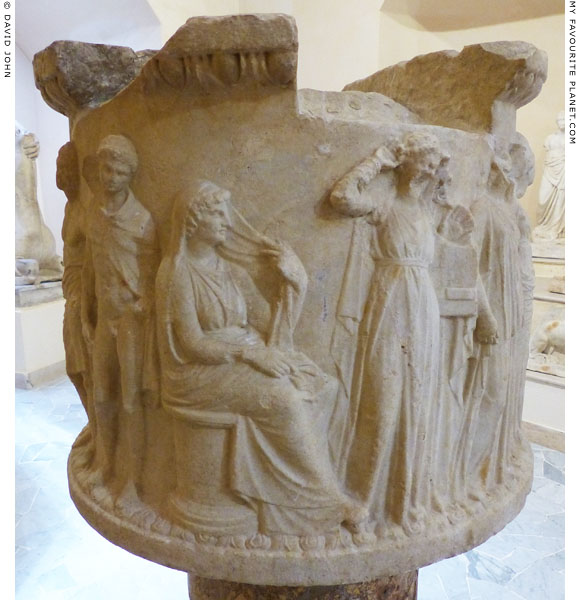
A relief of Demeter sitting on the sacred kiste on the side of a cylindrical
marble altar depicting the Dodekatheon, the twelve Olympian gods
(see the note on the twelve gods on the Dionysus page).
1st century BC - 1st century AD. Discovered in May 1940 during excavations
by Guido Calza (1888-1946) at the temple of Attis in the sanctuary of the
Magna Mater (Campo della Magna Mater, Regio IV, Insula I), Ostia,
near Rome. Pentelic marble. Height 44 cm, diameter 50 cm.
Ostia Archaeological Museum. Inv. No. 120.
|
One of the fragments, previously kept in the Palazzo Massimo alle Terme of the National Museum of Rome, had probably been discovered in 1867, during excavations at the sanctuary of the Magna Mater by Carlo Lodovico Visconti (1818-1894).
The altar is thought to be a Neo-Attic work, made in Athens between the 1st century BC and the 1st century AD. On the front of the altar Zeus sits on a throne facing right, and above him is the inscription Δωδεκάθεον (Dodekatheon, "of the twelve gods").
The work may be eclectic, with the figures sculpted in imitation of a number of Greek sculptors of various periods. It has been suggested that as many as five of the figures, including Zeus, may be copies of those on the frieze on the east pediment of the Parthenon (see below). There has been little debate about the iconography of the relief or the identity of the deities.
The figures in the photo above are to the left and behind Zeus. The seated goddess has also been interpreted as Hestia (῾Εστία, goddess of the hearth), but the objects in her right hand appear to be ears of corn, with her left hand she holds her veil as in other depictions of Demeter (see above and below), and sits on a cylindrical object which may be the sacred kiste (see above).
Left of her is Hermes, naked except for a chlamys cloak, and with a petasos hat behind his head. On the right stands Apollo, holding a kithara (lyre), and to the right of him is his sister Artemis.
The first examination of the relief was written by the Italian archaeologist and art historian Giovanni Becatti (1912-1973), published in 1942 [4]. It had been compared to that on a marble puteal (well head) in the Madrid Archaeological Museum, depicting gods around enthroned Zeus at the birth of Athena (see Athens Acropolis gallery page 13), which in turn had been connected with the scene as depicted on the east pediment of the Parthenon. However, rejecting this connection, Becatti believed that eleven of the twelve figures on the altar were copied from statues of the Olympian gods by Praxiteles which stood in the sanctuary of Artemis Soteira (Artemis Saviour) in Megara, central Greece. No traces of these works have yet been discovered by archaeologists, and the only ancient source concerning the group is a brief mention by Pausanias, who did not describe the statues, merely reporting the claim of his local informants that they were "said to be" by Praxiteles:
"... For this reason they had an image made of Artemis Saviour. Here are also images of the gods named the Twelve, said to be the work of Praxiteles. But the image of Artemis herself was made by Strongylion."
Pausanias, Description of Greece, Book 1, chapter 40, section 3. At Perseus Digital Library.
In an article published in 1949, the American classical art historian Rhys Carpenter (1889-1980) examined Becatti's claim that eleven of the figures were Praxitelean, and concluded: "Unfortunately, it seems to me to be entirely certain that they are not." [5] Instead, he saw characteristics of works by sculptors such as Lysippos and Polykleitos in some of the figures, and preferred to look to the Parthenon relief as a model.
The gods on the altar were identified by Becatti as:
1. Athena, 2. Zeus, 3. Hera, 4. Demeter or Amphitrite,
5. Poseidon, 6. Aphrodite, 7. Ares, 8. Hephaistos,
9. Hermes, 10. Hestia, 11. Apollo, 12. Artemis.
See a drawing of the relief below.
However, some of the identifications have been made on thin grounds. Becatti thought that the faceless figure 4 (see photo, above right) may be either Demeter or the Nereid Amphitrite (Ἀμφιτρίτη), the consort of Poseidon, because she stands next to the sea god, despite the fact that she is not counted among the twelve Olympian gods. Although Demeter stands next to Poseidon in a relief from Smyrna (see below), it is a very different type of work; Poseidon is seated, and Artemis stands to his right. Figure 4 can not definitely be identified as Demeter on the basis of iconography or attributes: whatever she may have been holding in her raised right hand is now missing; her clothing and pose can be ascribed to depictions of other goddesses; and there is no standard relative positioning of the gods in other comparable groups [6].
Figure 10 has been identified as Hestia, in part by comparison with the female sitting on a rock on the Madrid puteal, who is thought to be Klotho (Κλωθώ, one of the three Moirai or Fates). It has also been suggested that the fact that Hermes stands next to the figure indicates she is Hestia, with whom he was sometimes associated, although the same can be said for Demeter (see below: here, here, here, here and here).
Very few Greek statues of Hestia are mentioned by ancient authors or inscriptions, and even fewer surviving sculptures are known with certainty to depict her. Even the famous "Giustiniani Hestia" (Torlonia Museum, Rome, Inv. No. MT 490) may actually be Demeter or Hera. There are none that can be directly compared with this figure.
Still, one would expect to see Hestia among the twelve, although she was later replaced by Dionysus (who does not appear on the altar), particularly if the relief was made for a customer in Rome, where, as Vesta, she remained an important deity. However, given the scarcity of other sculptural depictions of her, there is no definitive type which would assist positive identification. |
|
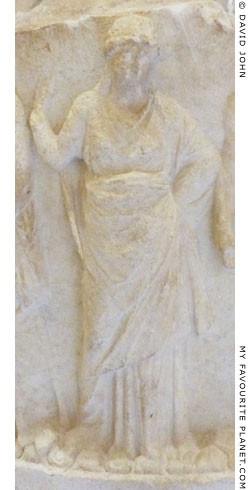
Deity No. 4 on the Ostia
Dodekatheon relief,
traditionally identified
as Demeter or Amphitrite. |
|
| |

A drawing of the Dodekatheon relief in Ostia.
The gods are shown in a different order to that in Becatti's study. Left - right:
1. Hermes, 2. Hestia or Demeter (seated), 3. Apollo, 4. Artemis, 5. Athena,
6. Zeus (enthroned), 7. Hera, 8. Demeter, Hestia or Amphitrite,
9. Poseidon, 10. Aphrodite, 11. Ares, 12. Hephaistos. |
| |
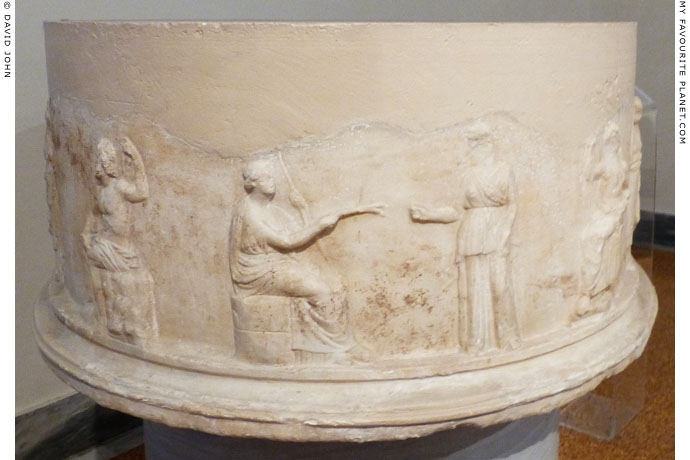
The remains of a marble cylindrical altar with a relief of the Dodekatheon, the twelve
Olympian gods, around its sides. The gods visible in the above photo (left-right):
Poseidon, Demeter, Athena, Zeus. Demeter sits on the sacred kiste, facing right,
holding a sceptre in her left hand and ears of wheat in the right.
Around 350-340 BC. Found in 1877 north of the Stoa of Attalos in
the Ancient Agora, Athens. Pentelic marble. Height approx. 44 cm..
National Archaeological Museum, Athens. Inv. No. 1731.
|
The broken part of the altar has been restored with plaster, but only seven gods and part of an eighth have been preserved. They have been identified as (left-right):
1) Hestia, facing right, holding her veil with her left hand; 2) Poseidon sitting on a rock, facing left, holding a trident in his raised left hand; 3) Demeter sitting on the sacred kiste, facing right, holding a sceptre in her left hand and ears of wheat in the right; 4) Athena standing, facing left, wearing the aegis over a peplos; 5) Zeus enthroned, facing right, holding a sceptre in his right hand; 6) Hera, facing left, pulling at an edge of her veil with her right hand; 7) Apollo sits, facing right, holding a kithara in his left hand and a plectrum in the right; 8) part of another god, now unidentifiable. |
|
|
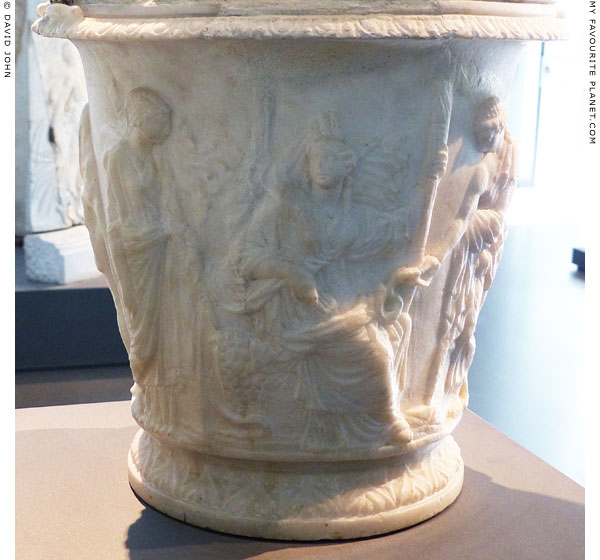
Demeter shown seated and holding a long torch, with ears of corn in her hand and hair,
on the side of the "Lovatelli Urn" (Urna Lovatelli), a marble cinerary urn with a low relief
depicting the initiation of Herakles into the Eleusinian Mysteries.
Fine-grained white marble. Early Imperial period, inspired by a late Hellenistic model
from Alexandria, Egypt. Found in the columbarium, the burial ground of the freed slaves
and servants of the gens Statilia, on the Esquiline Hill near the Porta Maggiore, Rome.
Height 29.4 cm, maximum diameter 32.0 cm. Height of figures 22.0 cm.
Palazzo Massimo alle Terme, National Museum of Rome. Inv. No. 11301.
|
The "Lovatelli Urn" (Urna Lovatelli) was named after Ersilia Caetani Lovatelli (1840-1925) who first published details of the vessel in the article: Di un vaso cinerario con rappresentanze relative aimisteri de Eleusi. In: Bullettino della Commissione archaeologica comunale di Roma 7, 1879, pages 5-18.
The side of the finely sculpted urn is decorated all around with narrative scenes concerning the initiation of Herakles into the Eleusinian Mysteries (see drawing below). To the left of the main scene Demeter is shown seated and holding a long torch, with ears of corn in her hand and hair. The god Iakchos stands in front of her, touching the head (or feeding) a snake in her lap. Demeter turns her head to see Persephone (Kore) approaching from behind.
In the main scene the initiate Herakles sits with a lionskin covering his head and shoulders, while a priestess holds a wicker screen (liknon) above his head. To the right a hierophant (priest), holding a bowl and a jug, accepts the sacrificing of a piglet, placed on a low altar by a male figure (also Herakles?).
Unfortunately, the urn is displayed near a wall and it is difficult to view the side scenes which are unlit. |
|
| |
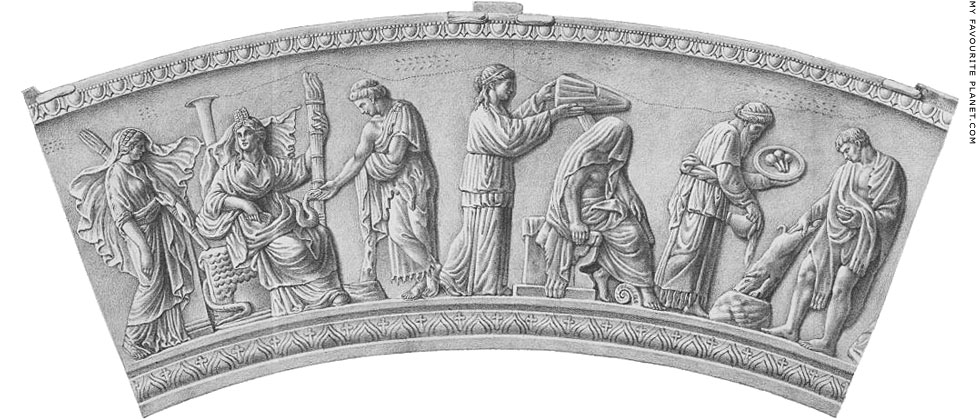
A "roll-out" drawing of the relief around the side of the "Lovatelli Urn" (Urna Lovatelli).
Image source: Ersilia Caetani Lovatelli, Antichi monumenti illustrati, Tavelo III.
Tip. della R. Accad. dei Lincei, Rome, 1889. At Arachne, University of Cologne. |
| |
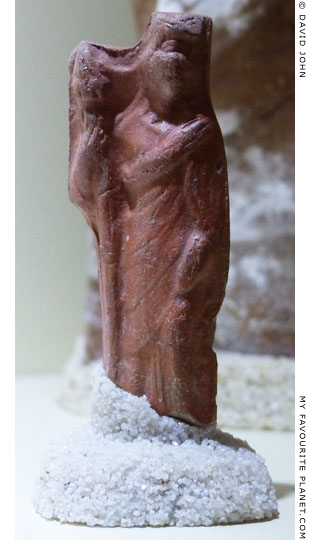
Terracotta statuette of Demeter
veiled and holding a long torch.
Roman period, 1st - 2nd century AD.
From Egypt. Provenance unknown.
Civic Archaeological Museum, Milan.
Inv. No. E 1998.03.451.
Temporary exhibition: Milano in Egitto:
Gli scavi di Achille Vogliano nel Fayum
(Milan in Egypt: The excavations of Achille
Vogliano in Fayum), Civic Archaeological
Museum, Milan, 17 May - 15 December 2017,
extended until 13 May 2018. |
|
|
|
| |
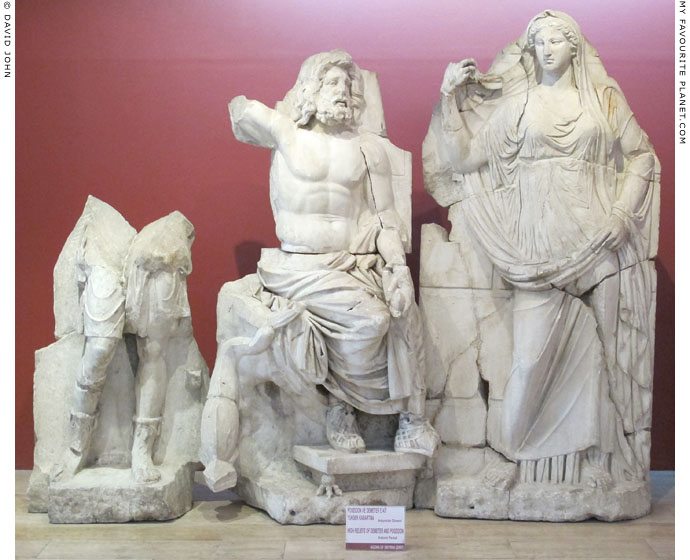
Fragmentary marble stele with high reliefs of Artemis, Poseidon and Demeter.
Only the lower torso and legs of Artemis have survived.
Discovered in the Agora of Smyrna (Izmir, Turkey) during excavations
by German and Turkish archaeologists 1932-1941. Believed to have
been part of a group of deities on an altar to Zeus in the centre of the
agora. Antonine period (138-193 AD). Height 220 cm, width 270 cm.
Izmir Museum of History and Art. |
| |
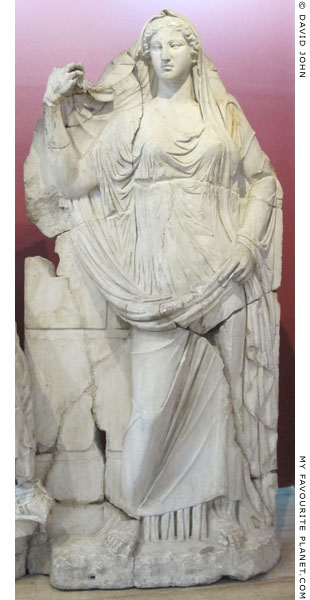
The Demeter relief from the Smyrna agora.
Izmir Museum of History and Art. |
|
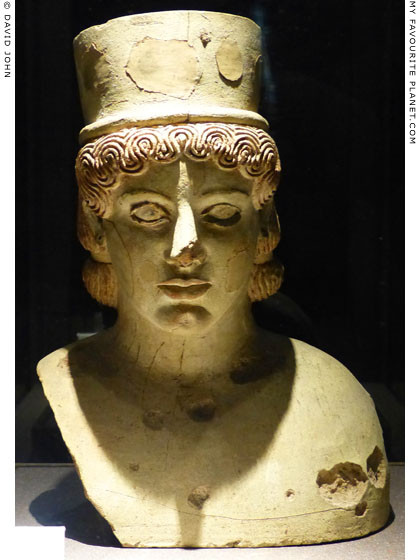
Ceramic bust of Demeter wearing a polos. 5th century BC.
Museo Civico, Castello Ursino, Catania, Sicily.
Inv. No. 5685. From the Biscari Collection. |
| |
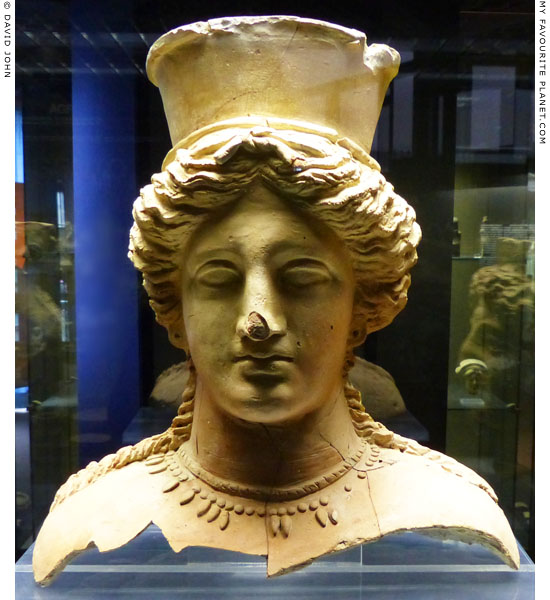
One of the larger and finer terracotta votive busts of a goddess wearing a polos,
probably Demeter or Persephone, from the cave sanctuary, known as "Demeter's
Holy Cave", Agrigento (ancient Akragas, Ἀκράγας), southern Sicily.
Late 5th - early 4th century BC.
Paolo Orsi Regional Archaeological Museum, Syracuse. Inv. No. 16085.
|
There are holes in the earlobes for earrings and she wears a necklace with pendants. Below the polos is a headband tied at the front with a Herakles knot, a feature of several similar busts and statuettes from Sicily (see photos below). Also typical of this type of figure is the hairstyle: parted in the middle, the hair is swept up and back from around the face; sometimes as here, grown to below the nape of the neck, sometimes shoulder-length. In this case there are also plaits falling from behind the ears to the shoulders, as seen also on deptions of other gods such as Artemis, Apollo, Dionysus and Hermes.
See also the bust from Syracuse in Demeter and Persephone part 1. |
|
| |
One of several busts (see photos below) of various sizes and other terracotta votive offerings from the cave sanctuary known as "Demeter's Holy Cave" or San Biagio's cave sanctuary, on the cliff-face outside the city wall at the east of Agrigento. The sanctuary may have been founded by native Sicilians before the arrival of the Rhodian and Cretan Greek colonizers from Gela, further east along the south coast of Sicily, around 582-580 BC (Thucydides, History of the Peloponnesian War, Book 6, chapter 4), and was in use until the sack of the city by the Carthaginians in 406 BC.
Above this sanctuary, on the top of the cliff, stood the temple of Demeter and Persephone, built 479-472 BC by Theron (Θήρων), the tyrant of Akragas, as part of a building programme following the Greek defeat of the Carthaginian invasion at Himera in 480 BC. The foundations and lower walls of the Doric temple, 13.3 x 30.2 metres, can still be seen beneath the Norman church of San Biagio (see image below), built in the 12th or 13th century with stone from the ancient building. The eastern hill of the Akragas acropolis, known as the Rupe Atenea (Rock of Athena), was also the location of temples of Athena and Zeus Atabyrios (Διὸς Ἀταβυρίος), whose cult was brought from Rhodes by the founders of Gela (Polybius, Histories, Book 9, chapter 27).
The cult of Demeter and Persephone at Akragas (Ἀκράγας) was referred to by the Theban poet Pindar (Πίνδαρος, circa 522-443 BC) at the beginning of one of his odes for a victor at the Pythian Games in Delphi. He wrote that the city, which was named after ther River Akragas, was the abode of Persephone (here written Φερσεφόνας, Fersefonas):
"I beseech you, splendour-loving city, most beautiful on earth, home of Persephone; you who inhabit the hill of well-built dwellings above the banks of sheep-pasturing Akragas: be propitious, and with the goodwill of gods and men, mistress, receive this victory garland from Pytho in honor of renowned Midas, and receive the victor himself, champion of Hellas in that art which once Pallas Athena discovered..." [7]
Pindar, Pythian 12, For Midas of Acragas, winner of the aulos-playing contest, 494 or 490 BC. At Perseus Digital Library.
The cave sanctuary, discovered by chance in the late 19th century, consists of a monumental fountain-reservoir in front of a rock face into which three tunnels had been dug. Two of the tunnels carried water to the city's water supply network, known as "dei Feaci" (of the Phaeacians), dated to the 5th century BC. It is thought that the local water deity Persephone-Nestis, mentioned by the philosopher Empedocles who lived in Akragas, may have been worshipped here.
Among the many objects found, dated to between the 8th or 7th and 4th centuries BC, were Geometric and Proto-Corinthian pottery, oil lamps, libation bowls, jugs and wine cups (skyphoi), "piglet offering figures" connected with propitiatory fertility rituals (see photo right) and ceramic sculptures, mostly depicting females, perhaps Demeter and Kore.
The sanctuary was first investigated by Pirro Marconi in 1926, by which time a great number of artefacts had already been looted and sold on the black market, and many smuggled out of Sicily. Some found their way to museums of Agrigento, Palermo and Siracusa. The objects in this group had been dug up by "grave robbers" and sold to antiquities smugglers, but were for some reason delivered in boxes to the Palermo museum on Christmas 1888.
Demeter is also thought to have been one of the deities worshipped in the Sanctuary of the Chthonic Divinities in the Valley of the Temples, below and to the southwest of the city. Although it it not known which deities were worshipped there (perhaps the Dioskouroi), the site contained bothroi (sacrificial pits), and terracotta figurines discovered there are almost identical to those found at other sanctuaries of Demeter in Sicily. |
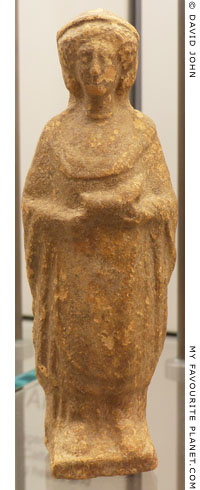
One of the piglet offering figures
from "Demeter's Holy Cave" in
Agrigento. A terracotta figurine of
a female holding a sacrificial piglet.
Antonino Salinas Regional
Archaeological Museum,
Palermo, Sicily.
See other piglet-offering figures
associated with Demeter and
Persephone below and in part 1. |
| |
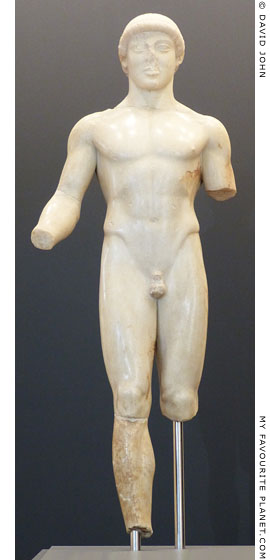
A smaller than life-size marble kouros
statue, found in 1897 in a cistern near
the temple of Demeter and Persephone
on the Rupe Atenea, Agrigento. The
figure, which may have been a votive
offering to the goddesses, has been
compared with the "Kritios Boy"
kouros found on the Athens Acropolis.
Around 480 BC.
Pietro Griffo Regional Archaeological
Museum, Agrigento. |
| |
| |
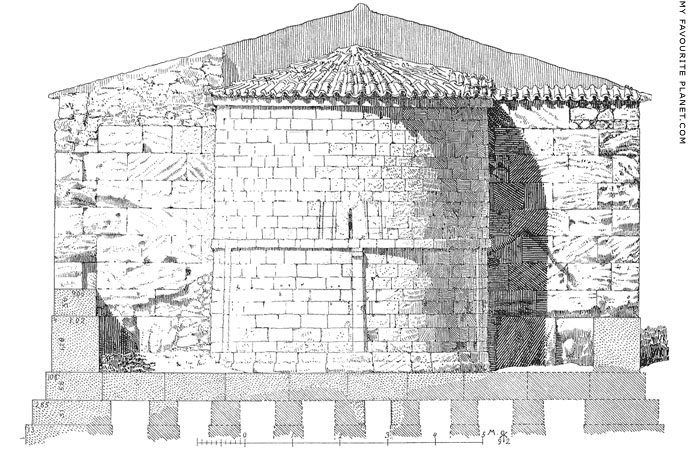
A drawing of the east side of San Biagio church in Agrigento, Sicily.
Source: Robert Koldewey and Otto Puchstein, Die griechischen
Tempel in Unteritalien und Sicilien, Band 1, Abbildung 128, page 143.
A. Ascher & Co., Berlin, 1899. At Heidelberg University Digital Library. |
| |
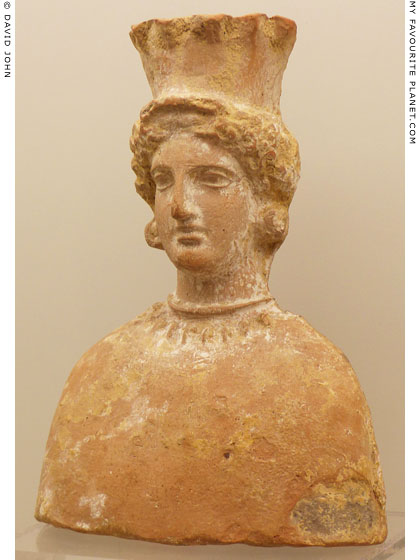
Terracotta votive bust of Demeter or Persephone wearing a polos.
5th - 4th century BC. From Agrigento (ancient Akragas), Sicily.
Antonino Salinas Regional Archaeological Museum, Palermo, Sicily. |
| |
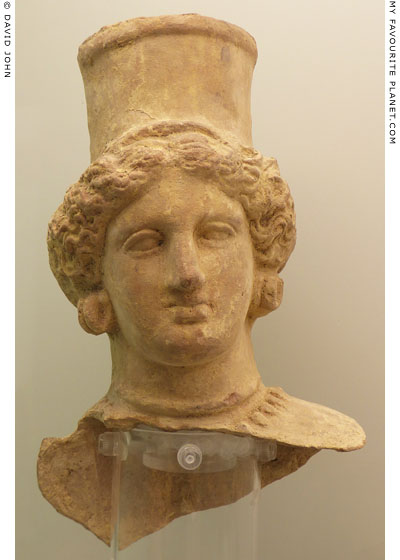
A terracotta votive bust of Demeter or Persephone
from "Demeter's Holy Cave", Agrigento.
Antonino Salinas Regional Archaeological Museum, Palermo, Sicily. |
| |
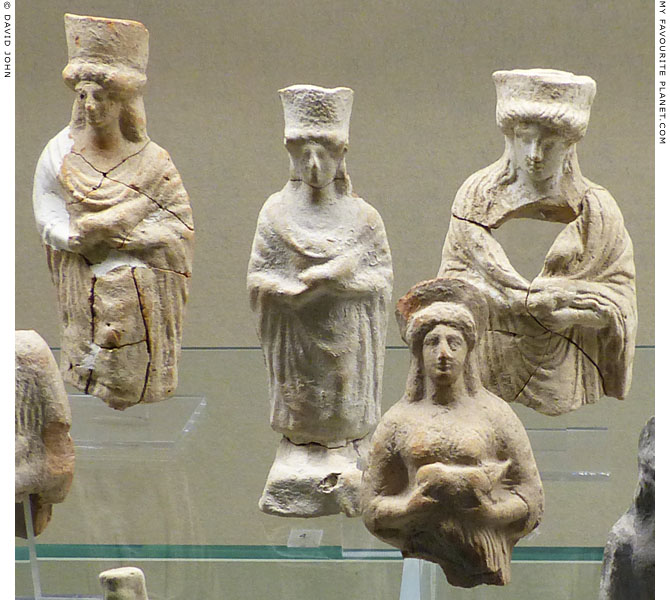
Terracotta figurines of a goddess wearing a polos and holding a piglet,
known as piglet offering figures, from various deposits in the sanctuary
of Demeter and Kore at Kamarina (Καμάρινα), on the south coast of Sicily.
5th - 4th centuries BC.
Paolo Orsi Regional Archaeological Museum, Syracuse.
Inv. Nos. 16347, 16344, 2293, 2294, 1949, 16342, 18475.
Only 7 Invoice Numbers are given on the museum label for the group of
8 figures displayed together, and it is not possible to tell which is which.
|
| The ruins of Kamarina (Καμάρινα) are near the eastern end of the south coast of Sicily, 16 km southwest of modern Vittoria. Like all ancient Sicilian cities it had a tumultuous history. It was founded in 599 BC by Syracuse, which destroyed it in 552 BC. Refounded by Gela in 461 BC, it was sacked by the Carthaginians in 405 BC. Timoleon (see part 1) restored it once again in 339 BC, and in 258 BC it was taken by the Romans. Its final destruction came in 853 AD. |
|
| |
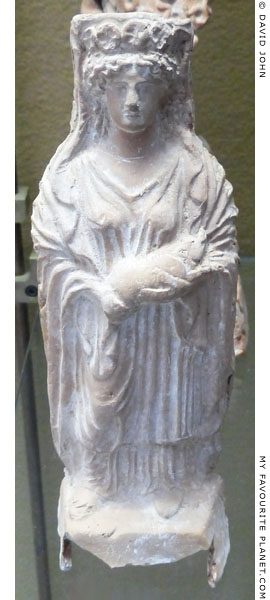
Terracotta figurine of a goddess wearing
a polos and holding a sacrificial piglet.
4th century BC. From the city of
Megara Hyblaia (Μέγαρα Ὑβλαία), Sicily.
Paolo Orsi Regional Archaeological
Museum, Syracuse. Inv. No. 1104. |
|
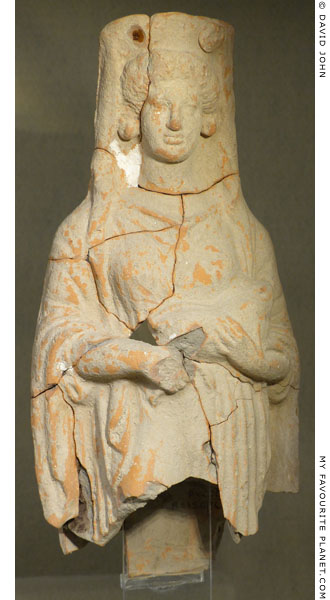
Terracotta figurine of a goddess wearing
a polos and holding a sacrificial piglet.
From Syracuse (?)
Paolo Orsi Regional Archaeological
Museum, Syracuse. Unlabelled. |
|
| |
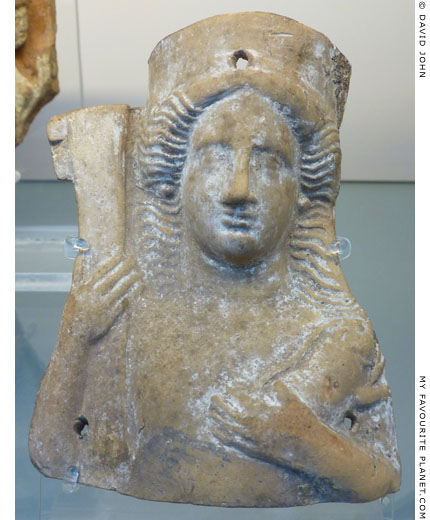
Terracotta bust of Demeter or Persephone holding a torch and a pig.
Made in Taranto, Italy around 420-400 BC. From Rubi.
British Museum. Gr 1856.12-26.325 (Terracotta 1276).
Bequeathed by Sir William Temple. |
| |
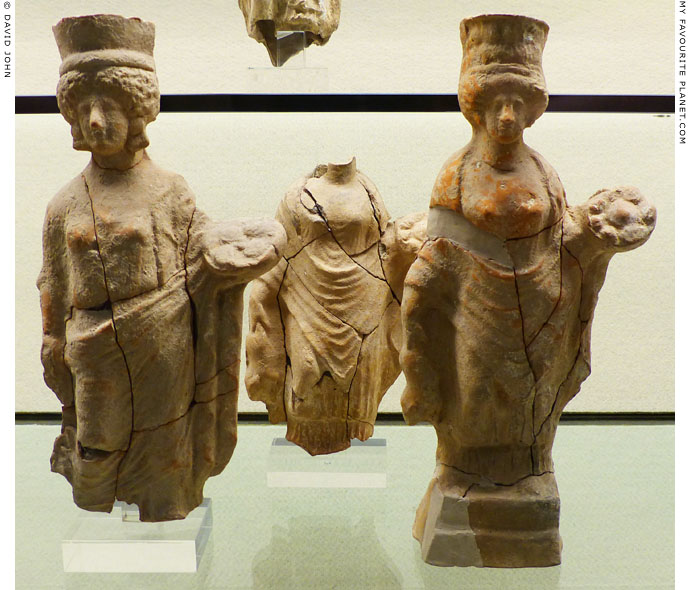
Terracotta figurines of a goddess wearing a polos
and holding a liknon (see part 1) in her left hand.
From Syracuse (?)
Paolo Orsi Regional Archaeological Museum, Syracuse. Unlabelled. |
| |
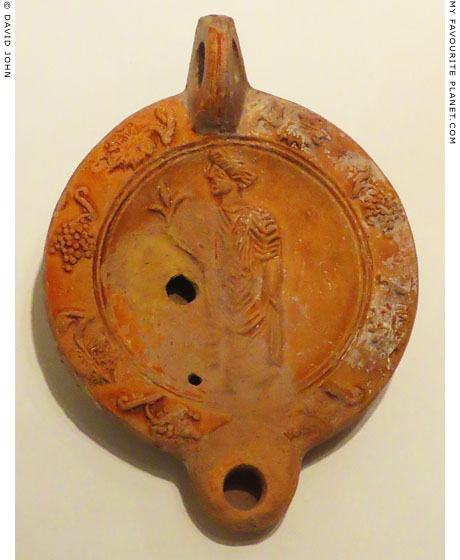
A terracotta oil lamp with a relief of Ceres standing in the central
tondo, holding an ear of wheat in her right hand. Around the outside
of the tondo are reliefs of bunches of grapes and vine leaves.
Circa 2nd century AD. From Tunisia.
Allard Pierson Museum, Amsterdam. Inv. No. 12.534. |
| |
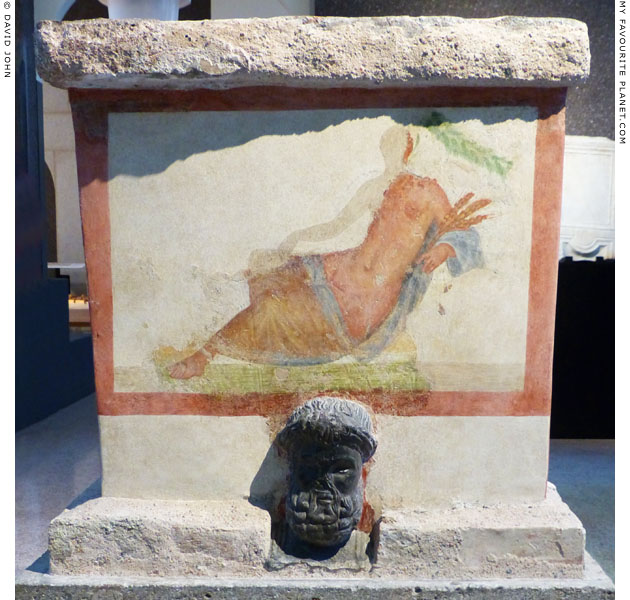
A painting of a Roman fertility goddess, either Tellus (Terra) or Ceres, on the side of
a plaster-covered stone altar. Below is a black marble head of Dionysus/Bacchus.
From the Roman city Mediolanum (Milan), late 1st - early 2nd century AD.
Found in 1825 in the Via Circo, Milan.
Probably from a domus extra moenia, outside the city walls, perhaps from a collegium
(corporation of craftsmen or merchants). Each of the four sides has a painting of a deity.
The other three sides show Fortuna-Abundantia, Hercules and Nike/Victoria.
Civic Archaeological Museum, Milan. Inv. No. E 0.9.1070. |
| |
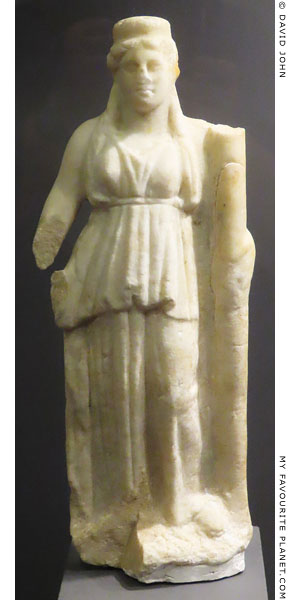
A marble statuette of a goddess,
perhaps Demeter, wearing a polos
and holding a long torch.
1st century AD. Found in the sanctuary
of Demeter in the city of Rhodes.
Palace of the Grand Master, Rhodes.
|
|
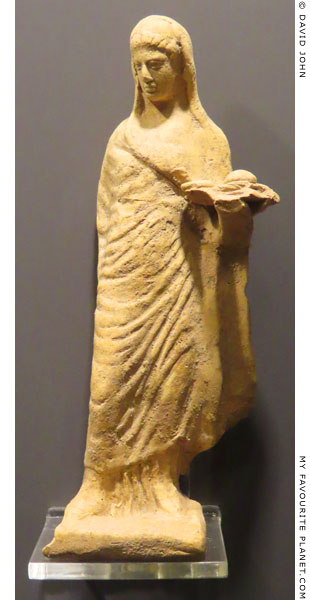
A ceramic figurine of a young female
(Kore?) draped in a himation (cloak),
holding a tray of fruits.
4th century BC. Found in the sanctuary
of Demeter in the city of Rhodes.
Palace of the Grand Master, Rhodes.
|
|
Both objects were found in the 1980s during a rescue excavation at the northeast end of the city of Rhodes (at the northern tip of the island), in what is now the New Town, near the ancient city walls. The excavation was concentrated on the Karayannis-Georgiadis properties at the junction of Kaouli Street and Amerikis Street, an area now occupied by hotels, near the National Theatre, and around 50 metres from the Hellenistic wall.
Only part of the extensive ancient sanctuary discovered there could be excavated, as the rest lies beneath modern buildings. A bronze ladle inscribed with a dedication to Demeter (see photo below) and several other finds of votive objects typical of the worship of Demeter and Persephone at other locations in East Greece (Troy, Pergamon, Priene, Kos and Lindos) convinced the archaeologists that this sanctuary was dedicated to these goddesses.
The finds included figurines thought represent of the Kore (Persephone), as well as worshippers carrying pigs (choirophoroi), water (hydrophoroi) and children (kourotrophoi). There were also hundreds of miniature olpae (jugs) and around three thousand oil lamps (see photo below). No temple has been found, and it has been suggested that the sanctuary may have been a thesmophorion (see part 1).
Remains were found of rectangular structures, three of which were not in alignment with the ancient street grid designed on the urban planning principles of Hippodamus of Miletus (although he probably did not take part in the design of Rhodes) when the city was founded in 408 BC. It is thought that the sanctuary was probably in use from the city's foundation until the early 2nd century BC.
The finds from the sanctuary are part of the collection of the Rhodes Archaeological Museum, but a few are currently (2022) part of the extended exhibition "Ancient Rhodes - 2400 years", in the Palace of the Grand Master, Rhodes.
As with much of the archaeological activity on Rhodes since the 19th century, very little information about the excavation of the sanctuary of Demeter has been published.
Prior to the discovery of this sanctuary, very little evidence had been found for the civic worship of Demeter on the island. More particularly, no inscriptions mention priests of the goddess, leading to the suggestion that her cult may have been led here by women who were not mentioned in the epigraphic records.
See, for example: Juliane Zachhuber, The lost priestesses of Rhodes? Female religious offices and social standing in Hellenistic Rhodes. In: Kernos, issue 31, 2018, pages 83-110. At OpenEdition Journals. |
|
| |

A bronze ladle with a handle ending in the head of a duck, and on the back a
dedication to Demeter has been inscribed in lettering formed by series of dots.
ΧΑΙΡΙΩΝ ... ΔΑΜAΤΡΙ
Chairion [dedicated] to Demeter
4th century BC. Found in the sanctuary
of Demeter in the city of Rhodes.
Palace of the Grand Master, Rhodes. |
| |
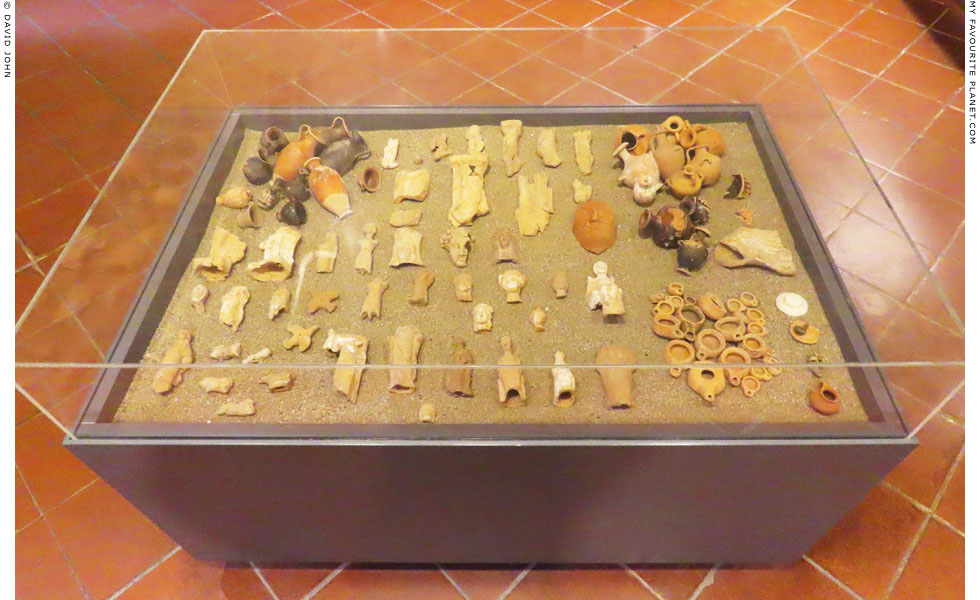
A display case with archaeological finds from Rhodes: ceramic figurines, lamps
and vases. The assembly is not labelled, and it is not clear if these are finds
from the sanctuary of Demeter, from some other dig, or a general display.
Palace of the Grand Master, Rhodes. |
| |
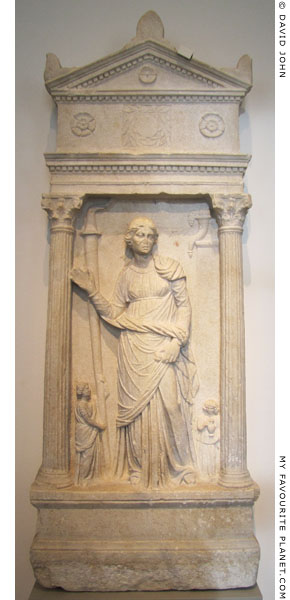 |
|
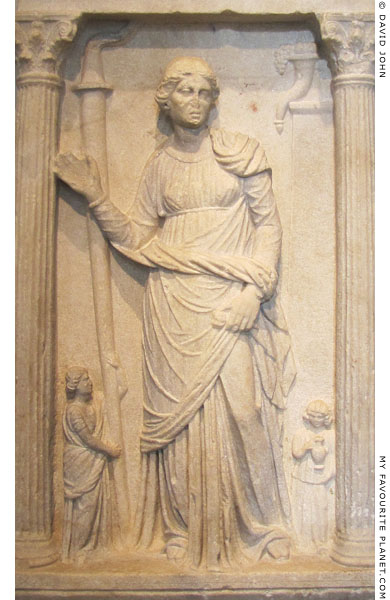 |
Marble funerary stele with a relief of a woman, perhaps a priestess of Demeter.
Found at the caravan bridge at Smyrna (Izmir, Turkey). Hellenistic period,
around 150-100 BC. Coarse-grained, blue-greyish white marble.
Height 155 cm, width 65 cm, depth 14 cm.
Altes Museum, Berlin. Inv. No. Sk 767. Acquired in 1878.
|
|
| The woman holds poppy capsules in her left hand, and one of her diminuative female servants (slaves) holds a long torch. To the right, a cornucopia stands on top of a pilaster in lower relief. All three symbols are associated with the cult of Demeter and Persephone. However, this does not necessarily indicate that she was a priestess: the iconography, perhaps based on a statue of a prietess of Demeter, was common in Smyrna to depict respected women. The elaborate carving of the main figure and the architectural setting, complete with Corinthian columns and rosettes, suggest that she was from a wealthy family. |
|
| |
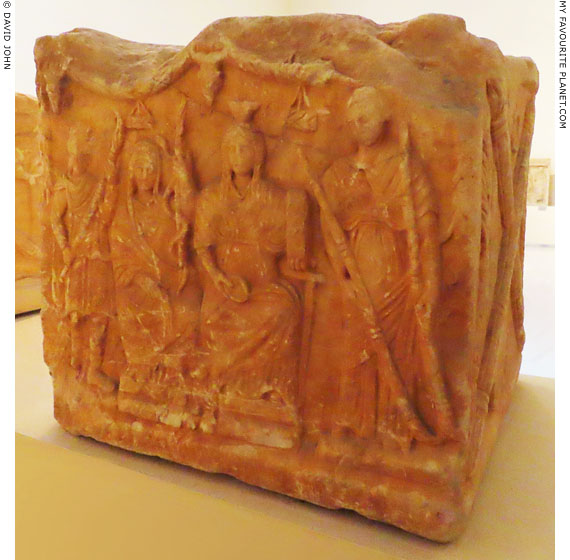
The rear of a Taurobolic altar with a relief of Demeter (left) and Cybele enthroned
next to each other. The goddesses are flanked by the Eleusinian deity Iakchos
(far left), holding a torch, and Persephone (far right) holding two torches.
387 AD, late Antiquity. From Attica. Pentelic marble.
National Archaeological Museum, Athens. Inv. No. 1747.
One of two very similar altars exhibited in the museum. Unfortunately, they are displayed close to a wall, so that it is impossible to get a good look (or photo) of the back of the objects, which were designed to be admired in the round. The other altar, Inv. No. 1746, is dated around 360-370 AD, perhaps during the reign of Julian the Apostate (361-363 AD). It is thought that they are from Chalandri (ancient Phlya), Attica. They are associated with the cult of Cybele-Rhea, particularly with the mystery celebration of the Taurobolia.
Each altar has a relief on three sides and a dedicatory inscription on the fourth. The relief scenes include cult symbols or props, such as long torches, pan pipes, drums and castanets. On the front of each is a relief of enthroned Cybele-Rhea resting her right hand on the shoulder of Attis, who stands to her right. On the left side are crossed torches and symbols, and on the rear side is the group of Iakchos, Demeter, Cybele and Persephone.
The inscription on the fourth side of this altar states that it was dedicated by Mousonios as a symbol of the ceremony of the Taurobolion. According to calendar references mentioned, it has been estimated that the altar was set up on 27 May 387.
Altar 1746 was dedicated by Archelaos of Athens, torch-bearer of Persephone at Lerna and key-bearer of Hera, in return for his initiation into the Taurobolic Mysteries. He also claims to have been the first to celebrate the Taurobolia at that particular location. The inscriptions are indications that there was still interest in pagan eclectic mystery cults even after Chrisitanity had swept through the ancient world and become the de facto official religion of the Roman Empire. But cult devotees like Mousonios and Archelaos were fighting very much a rear-guard action, and shortly after these altars were set up pagan worship would be forbidden and the temples and sanctuaries of the ancient gods forced to close forever. |
|
| |
| |
Demeter on coins |
 |
|
| |
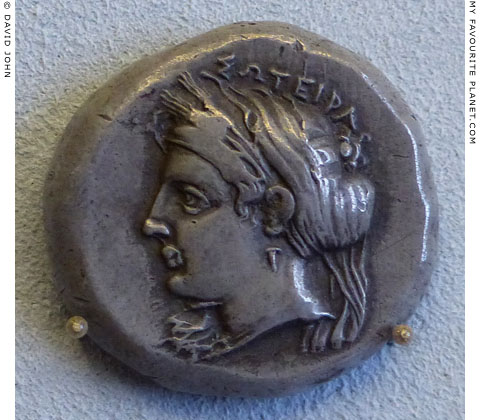
A silver tetradrachm coin of Kyzikos (Cyzicus, Κύζικος) Mysia,
northwestern Anatolia (today Erdek, Balikesir Province, Turkey),
with the head of Demeter facing left, her hair held up by a sakkos
(headscarf), and wearing an earring in the form of an ear of wheat.
Above right is the inscription "ΣΩΤΕΙΡΑ" (Soteira, Saviour).
Circa 400 BC. Diameter 23 mm, weight 15.15 grams.
Numismatic Collection, Bode Museum, Berlin. Inv. No. 18200339. |
| |
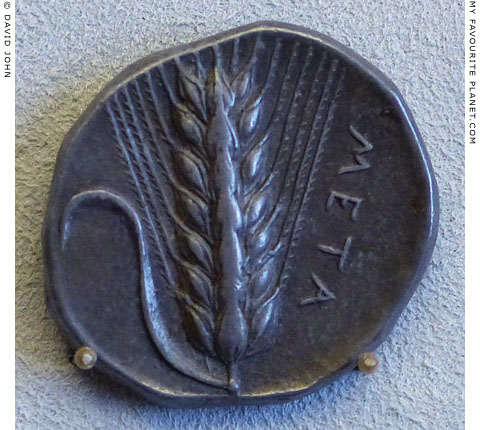
A silver stater coin of Metapontion, Magna Graecia, with an
ear of corn representing the cult of Demeter. Circa 375 BC.
The obverse shows the head of Demeter wearing a wreath,
an earring and necklace, and the signature "APIΣTOΞE" of
the die-cutter Aristoxenos, who also made dies for nearby
Herakleia. Diameter 22 mm, weight 7.88 grams.
Numismatic Collection, Bode Museum, Berlin. Inv. No. 18200338.
|
Metapontion (Μεταπόντιον; Latin, Metapontium), on the gulf of Tarentum, southern Italy, was a colony of Achaea in the Peloponnese, founded around 700-690 BC.
At the end of the first century BC Strabo reported the legend that the city had been founded by Greeks from Pylos, southwestern Peloponnese, at the time their aged king Nestor returned from the Trojan War. The Metapontians apparently prospered from the fertility of the land and could afford to send a "golden harvest" (θερος χρυσοῦν) as a votive offering to the sanctuary of Apollo at Delphi. This is taken to have been ears of grain made of gold.
"Next in order is Metapontium, at a distance of 140 stadia from the sea-port of Heraclea. It is said to be a settlement of the Pylians at the time of their return from Ilium under Nestor; their success in agriculture was so great, that it is said they offered at Delphi a golden harvest."
Strabo, Geography, Book 6, chapter 1, section 5. Edited by H. C. Hamilton and W. Falconer. George Bell & Sons, London, 1903. At Perseus Digital Library.
The city appears to have been destroyed long before the time of Pausanias, in the mid second century AD.
"How it came about that the Metapontines were destroyed I do not know, but today nothing is left of Metapontum but the theatre and the circuit of the walls."
Pausanias, Description of Greece, Book 6, chapter 19, section 11. At Perseus Digital Library. |
|
| |

A drawing of an ear of bearded wheat, by the British
traveller and archaeologist Charles Fellows (1799-1860).
|
Charles Fellows travelled through southwestern Anatolia in 1838, 1840, 1842 and 1843, discovering and exploring several ancient Lycian cities. During his first journey he discovered the ancient Lycian capital Xanthos (Greek, Ξάνθος; Lycian, Arnna), which he described as "my favourite city", and from where he later took artefacts, including the surviving parts of the famous Nereid Monument, for the British Museum (see Museum boom part 1 at The Cheshire Cat Blog).
He noted the customs and ways of life of local people as well as the plants and crops in the area. Although the bearded wheat grown in Anatolia reminded him of depictions and symbols of Ceres, he did not report on any evidence of the worship of Demeter and Persephone in Lycia. An entry from his journal, written 19th April 1838, while he was in Xanthos, Lycia (at the village of Kınık, Antalya Province, southwest Turkey):
"The only wheat grown in Asia Minor is bearded, and this is the peculiar kind represented in the figures of Ceres and upon ancient coins."
Charles Fellows, A journal written during an excursion in Asia Minor, 1838, page 235. John Murray, London, 1839. At the Internet Archive. |
|
| |
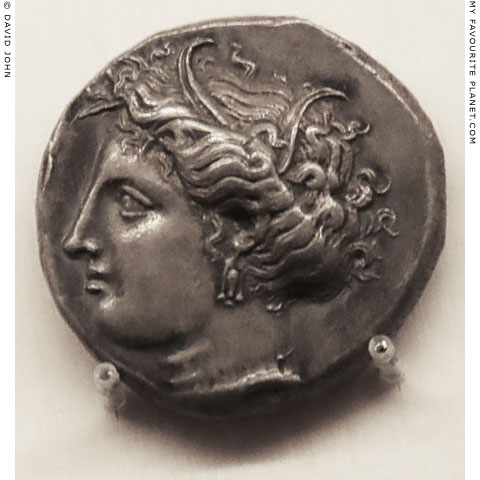
A silver stater from Lokri Epizephyrii, Magna Graecia (Ἐπιζεφύριοι Λοκροί,
today Locris, Calabria, southern Italy), with the head of Demeter in profile,
facing left, wearing a grain wreath and an earring with pendants.
Circa 369-338 BC.
Rijksmuseum van Oudheden, Leiden, Netherlands. |
| |
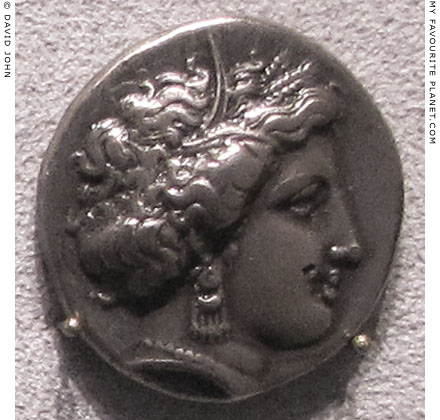
A silver stater from Pheneos (Φενεός, Feneos), Arcadia, with the
head of Demeter in profile, facing right, wearing a grain wreath,
a disc and crescent earring with pendants, and a pearl necklace.
Circa 360-340 BC. Diameter 24 mm, weight 11.85 g.
Altes Museum, Berlin. From the collection of Dr. Alfred von Sallet.
Numismatic Collection, Berlin State Museums (SMB). Inv. No. 18214906.
|
Pheneos (Φενεός) was a city in Arcadia, northeastern Peloponnese, Greece. Today it is in the Prefecture of Corinthia. It stood at the foot of Mount Kyllene, the mythical birthplace of Hermes, was an important cult centre for the god, and the location of an annual festival of the Hermaea. It also had sanctuaries for Demeter and Asklepios.
The reverse side of the coin shows Hermes carrying the infant Arkas, and the inscription ΦΕΝΕΩΝ (see the photo of another coin of this type on the Hermes page).
The design of these staters, as well as coins minted around the same time in Messene (Μεσσήνη, southwestern Peloponnese) depicting Demeter, and Opuntian Locris (Λοκροὶ Ὀπούντιοι, central Greece) depicting Persephone, is thought to have been influenced by the dekadrachms of Syracuse, designed by Kimon and Euainetos (see examples on the Nike page). See also Sicilo-Punic and Carthaginian coins with similar heads, identified as Tanit-Persephone, below. |
|
| |
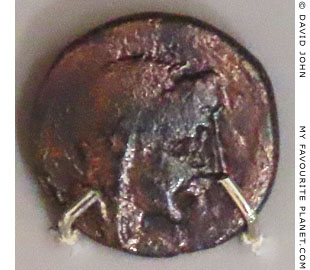
A small bronze coin of the island Kos with
the head of Demeter in profile, facing right.
220-200 BC.
Kos Archaeological Museum. Inv. No. N712. |
| |
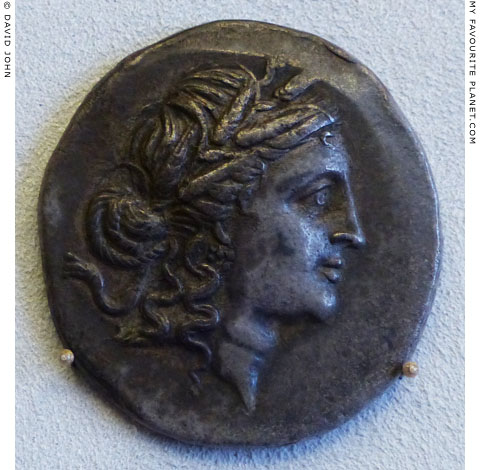
A silver tetradrachm coin of the Cycladic island Syros (Σύρος), with
the head of Demeter facing right, wearing a wreath with ears of corn
and an earring. Circa 150 BC. Diameter 31 mm, weight 15.88 grams.
The reverse side shows a laurel wreath surrounding two Kabeiroi
(or Dioskouroi) standing facing, each nude except for a cloak,
holding a sceptre or spear, and surmounted by a star, and the
inscription "ΘEΩN KABEIΡΩN ΣΥΡIΩN" (divine Syrian Kabeiroi).
Numismatic Collection, Bode Museum, Berlin. Inv. No. 18200337. |
| |
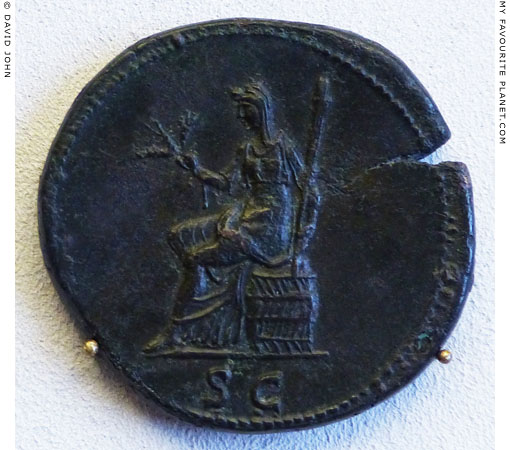
Roman bronze sestertius coin showing Ceres (Demeter) sitting on the
sacred kiste (cista mystica), holding a torch in her left hand and three grain
stalks in the right. Circa 128-135 BC. Diameter 34 mm, weight 25.16 grams.
One of many coin types issued by Empress Vibia Sabina (83 - 136/137 AD),
wife of Emperor Hadrian. In 128 AD she was awarded the title of Augusta
which allowed her to issue her own coinage.
Numismatic Collection, Bode Museum, Berlin. Inv. No. 18200340.
See also a statue of Vibia Sabina as Ceres in Part 1.
Read more about the Bode Museum Numismatic Collection
in Big Money at the Cheshire Cat blog. |
| |
| |
Depictions of Isis-Demeter |
 |
|
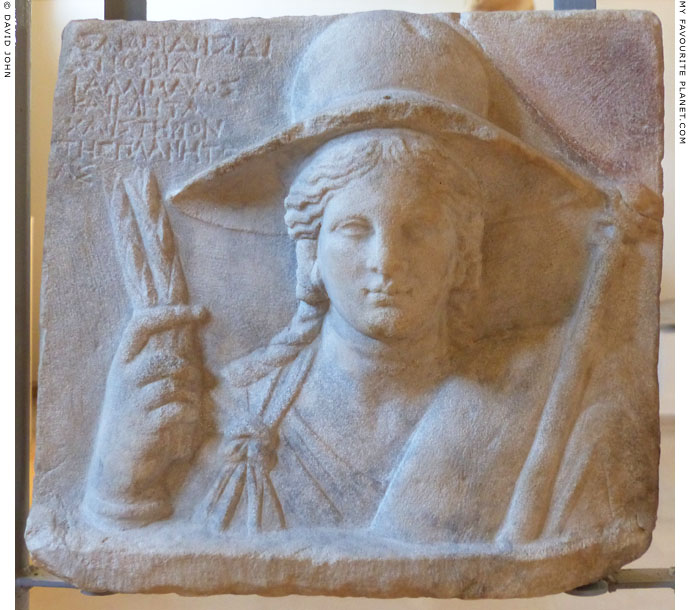
Marble relief of Isis-Demeter from the facade of the main temple
of the sanctuary of Isis, Dion, Macedonia, Greece. 2nd century BC.
Dion Archaeological Museum. Inv. No. 410. |
| |
Herodotus was the first known author to identify Demeter with the Egyptian goddess Isis. He, and later others, recognized parallels in the myths of the two deities, both of whom were associated with fertility, the underworld and the cycles of life, growth, decline and death. Like Demeter, Isis undertook a long search for her closest companion, her brother and husband Osiris, who had been killed by their brother Seth. She finally recovered his body and brought him back to life, restoring order and cosmic balance. Greeks living in Egypt and the Levant (Syria) adapted local beliefs and practices, mixing them with their own to suit their religious and cultural preferences, and, particularly from the Hellenistic period, the cults of syncretic deities such as Isis-Demeter, Zeus Ammon and Serapis were spread around the Greco-Roman world.
For further information about the relief and the sanctuaries of Demeter and Isis at Dion, see Dion: the garden of the gods at The Cheshire Cat Blog. |
|
| |
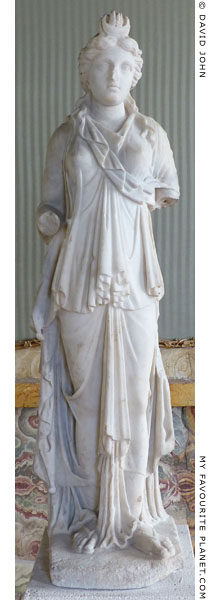 |
|
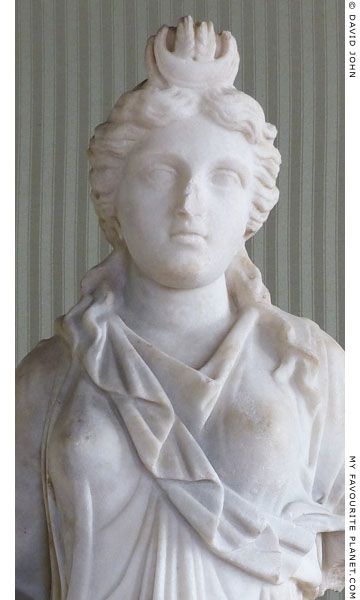 |
Marble statue of Isis-Demeter wearing a crescent moon topped by two ears of corn.
The frontal pose and garments resemble those of types of statues of Isis.
First half of the 2nd century AD. Proconnesian marble. Provenance unknown.
Palazzo Altemps, National Museum of Rome. Inv. No. 126074.
Until 1951 in the Barberini Collection. |
|
| |
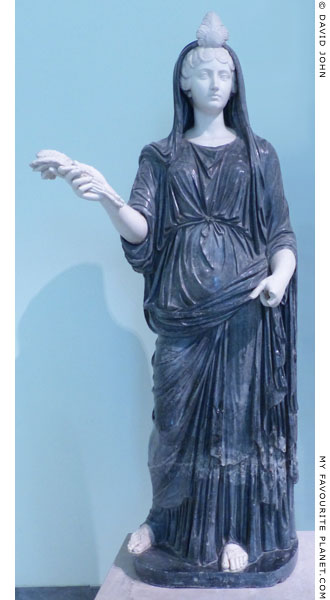 |
|
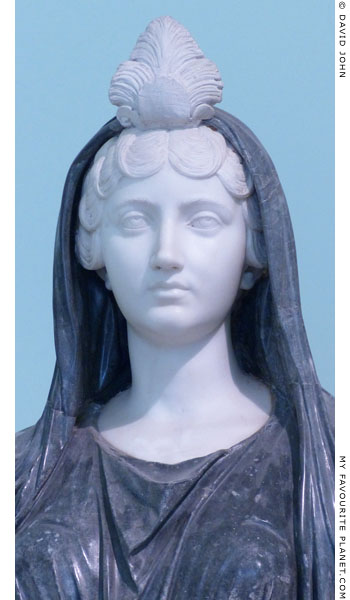 |
Marble statue of Fortuna-Isis restored as Faustina the Younger dressed as Ceres.
2nd century AD. Bigio morato marble. The head, hands
and legs are modern restorations. Height 192 cm.
Faustina the Younger (or Faustina Minor, Annia Galeria Faustina Minor,
circa 130-175 AD) was the daughter of Emperor Antoninus Pius and
Faustina the Elder. She became empress as the wife of Marcus Aurelius.
National Archaeological Museum, Naples. Inv. No. 6368. Farnese Collection.
For further information about Roman empresses
depicted as Ceres, see Demeter and Persephone Part 1. |
|
| |
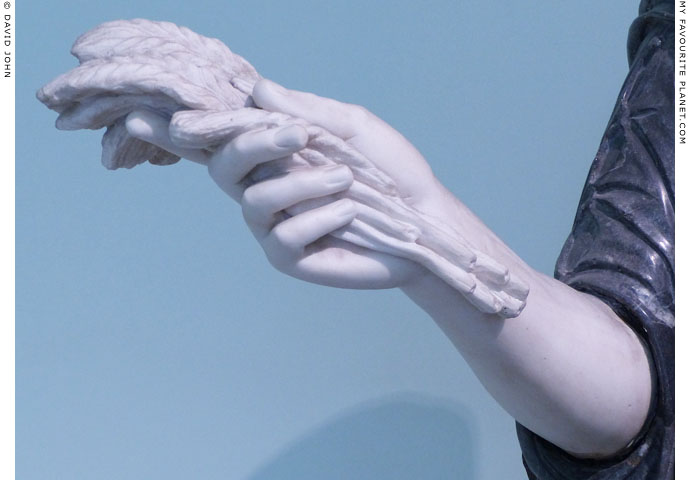
Ears of wheat in the right hand of the restored statue of Faustina / Ceres above. |
| |
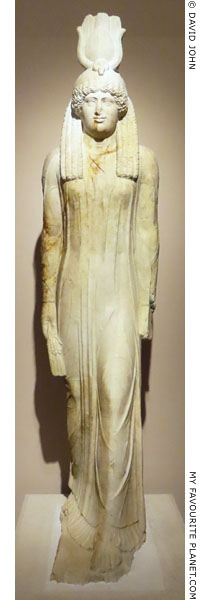 |
|
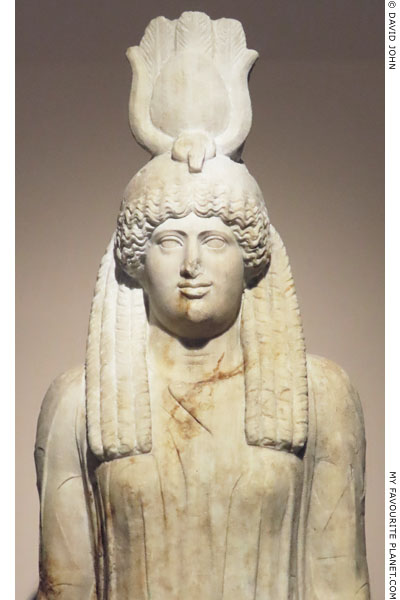 |
|
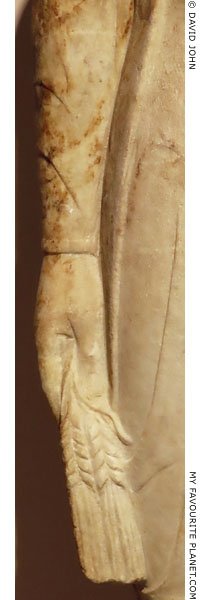 |
Larger than lifesize marble statue of Isis-Demeter holding ears of wheat in her
right hand; much of the left hand is now missing. From the south porch of the
temple in the Sanctuary of the Egyptian Gods at Brexiza, near Marathon, Attica,
built around 160 AD by the wealthy Athenian Herodes Atticus (circa 101-177 AD).
For further information about the sanctuary, see the Herodes Atticus page.
A statue of Isis and one of Osiris flanked each of the four entrances to the temple.
The other surviving Isis, from the west porch, depicts her as Isis-Aphrodite, and
the three Osiris statues found there are of the Antinous-Osiris type (se Antinous).
Mid 2nd century AD.
Marathon Archaeological Museum. |
|
| |
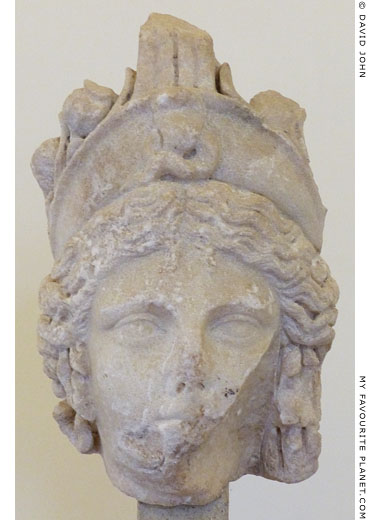
Fragmentary marble head of Isis-Demeter wearing
a tall diadem, decorated with the uraeus, the snake
symbolizing Egyptian royalty, and ears of corn and
poppies, agricultural attributes of Demeter.
Late 2nd century AD. Provenance unknown.
Palazzo Altemps, National Museum of Rome. Inv. No. 75065.
Donated by the marquise Céline Cappelli in 1917. |
| |
| |
Depictions of Demeter and Persephone |
 |
|
| |
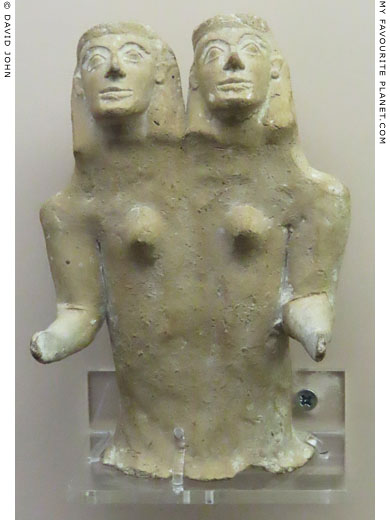
Part of a terracotta figurine depicting a pair of female deities,
probably Demeter and Persephone. The two heads in the
Daedalic style, share a single body, a type of depiction also
known from votive figures of around the same period found
at the Sanctuary of Zeus Meilichios in Selinunte, Sicily.
From an inhumation burial of an adult and a young woman
in a single tomb, Papatislures T 27 (35). 625-600 BC.
Found during excavations in the cemetery at Papatislures,
near the ancient city of Kamiros, western Rhodes.
Rhodes Archaeological Museum. |
| |
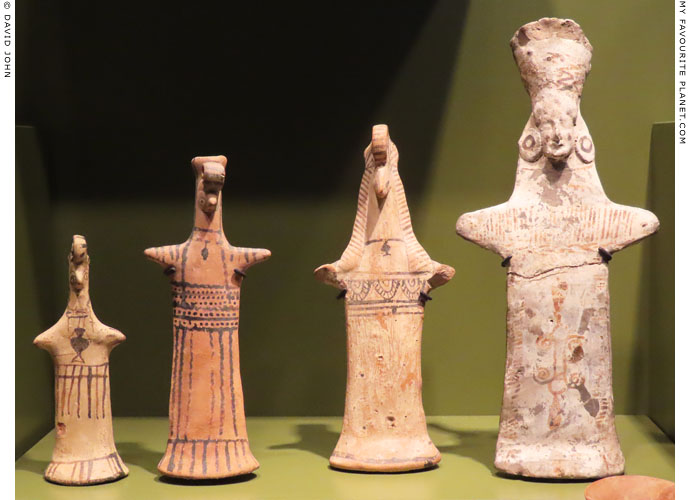
Terracotta "pappades" or plank idols that may represent Demeter and Persephone.
Made in Boeotia, central Greece. 6th century BC.
Allard Pierson Museum, Amsterdam. Inv. Nos. 15.710, 1317, 597 and 3294.
|
Flat-bodied "board-idols", "plank Idols" or "plank figures" (σανίδες, sanides, from plank, board, piece of wood; sanidomorpha, plank-shaped) were made in various forms around the Aegean from prehistoric times. Pappades (Παππάδες; from παππας, pappas, priest) are types of plank figures made in Boeotia between around 625 and 550 BC, during the Archaic period. Their name is due to the fact that many of the figures wear a polos (e.g. the figure on the far right in the photo above) similar to the tall cylindrical hats worn by modern Greek Orthodox priests. Most pappades have been found in tombs, and the majority for which the provenance is known are from Tanagra in Boeotia.
Some have human faces, while others have oddly-shaped "mouse heads" or "bird beaks". They appear to be females, have a variety of long or short hairstyles, wear jewellery, and their broad, flat bodies are clothed in robes with embroidered patterns, the details painted in black and purple. They are thought to represent Demeter and Persephone (Hera has also been suggested), or were dedicated to the goddesses. |
|
| |
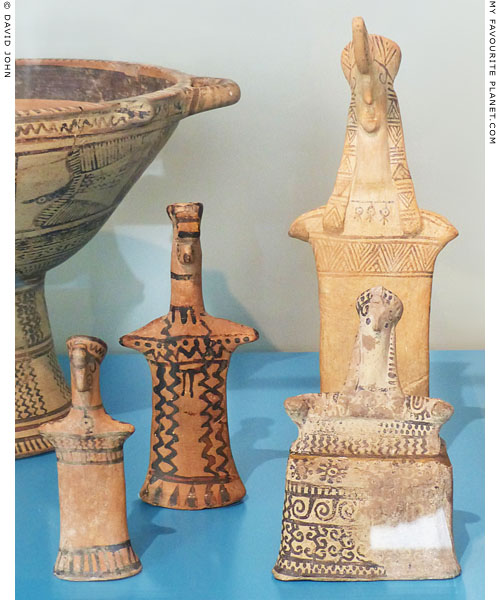
Terracotta "pappades" (plank idols) from Boeotia, central Greece. Mid 6th century BC.
Museum für Kunst und Gewerbe Hamburg. Inv. Nos. 1925.7, 1926.3, 2002.4, 1955.29.
Inv. No. 2002.4 bequest of Herbert Joost, Hamburg. |
| |
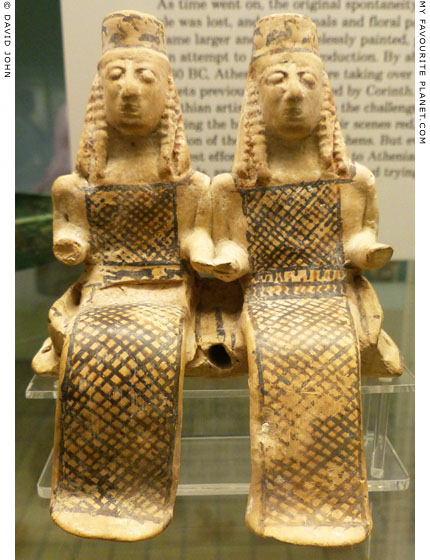
Corinthian terracotta figurines of two females, perhaps
Demeter and Persephone, sitting side by side in a cart.
Around 600 BC. Said to be from Thebes.
British Museum. Inv. No. GR 1895.10-29.5 (Terracotta 897). Acquired in 1895.
|
| The style of decoration resembles that of Boeotian Geometric vases (see the "pappades" above), while the faces of the figures has been described as "somewhat oriental in character". Each figure wears a polos decorated with a frieze of ducks facing right. Their dresses are decorated with cross-hatching. The girdle of the figure on the left has a frieze of two animals (horses?) running to the right. The girdle of the right-hand figure has a band of vertical hatching over one of wavy lines. |
|
| |
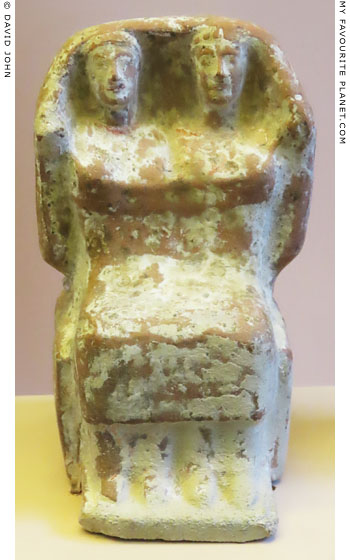
Terracotta figurine of two seated goddesses, perhaps Demeter and
Persephone. They have been described as sharing a cover (himation
or cloak). As in the much earlier figurine from Kamiros above, the
bodies of the two figures almost seem to merge with each other. From an inhumation burial of an adult, Macri Langoni T 26 (54).
450-420 BC. Found during excavations in the cemetery at Macri
Langoni, near Kamiros, Rhodes.
Rhodes Archaeological Museum. |
| |
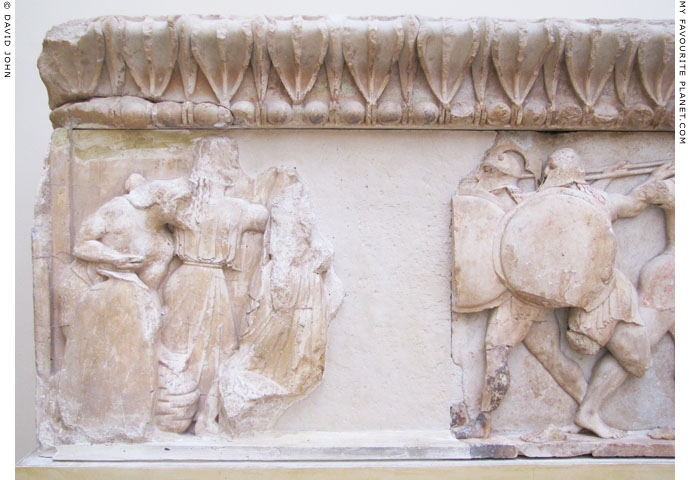
Hephaistos with two goddesses, thought to be Demeter and Persephone, on
a fragmentary Archaic relief depicting the myth of the Gigantomachy (the battle
between the Olympian gods and the Giants), from the Siphnian Treasury, Delphi.
A fragmentary slab of the left (west) end of the north frieze of the Ionic treasury,
built for the people of Siphnos around 525 BC (before 524 BC). Parian marble.
On the far left Hephaistos, wearing a chiton, stands at his bellows preparing
fireballs as weapons for the gods (see detail below). Next to him stand two
goddesses, dressed in long chitons, facing two Giants with Corinthian helmets,
round shields and spears, attacking them from the right.
On another fragment of the relief, part of the signature of the sculptor has
survived on the shield of a Giant, although his name is now missing. He is
referred to as "Master B", and Aristion of Paros, Boupalos of Chios and Endoios
have been suggested. See the Aristion of Paros page for further details.
Delphi Archaeological Museum, Greece.
See also a relief of Demeter with Athena and Hera
from the east side of the frieze, above. |
| |
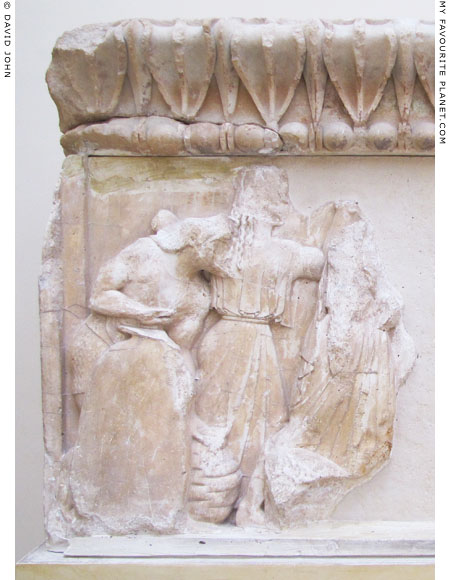
The fragment of the Gigantomachy relief from the north frieze of the
Siphian Treasury, Delphi, depicting Hephaistos, Demeter and Persephone. |
| |
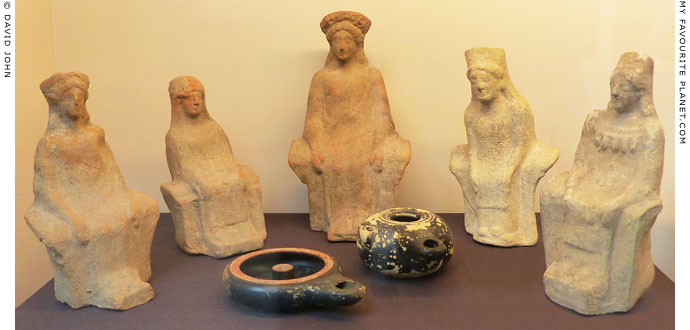
Terracotta figurines dedicated to Demeter and Persephone and clay lamps.
Made in Sicily around 500-450 BC. From Gela, Sicily.
British Museum.
Terracottas: GR 1863,0728.273, 274, 266, 268 and 269.
Lamps: GR 1863,2728.117 and 121.
|
The worship of Demeter and Persephone (Kore) was particularly popular in Sicily. In and around Gela, on the south coast, there were several major sanctuaries dedicated to the goddesses at which a large number of terracotta votive offerings and lamps have been found. The lamps suggest that rituals took place in semi-darkness.
Southeast of the city's acropolis (Lindioi) there was a sanctuary of Demetra Thesmophoros, founded in the 7th century BC on a low hill now known as Bitalemi, on the coast east of the mouth of the Gelas river. Excavations at the thesmophorion, led by Piero Orlandini 1964-1967, revealed disctinct phases of development from around 640 BC, including a major restoration about 480 BC, until the destruction of the city and the sanctuary by the Carthaginians around 405 BC. Another sanctuary at Predio Sola may have been dedicated to Demeter, Kore or Aphrodite. |
|
| |
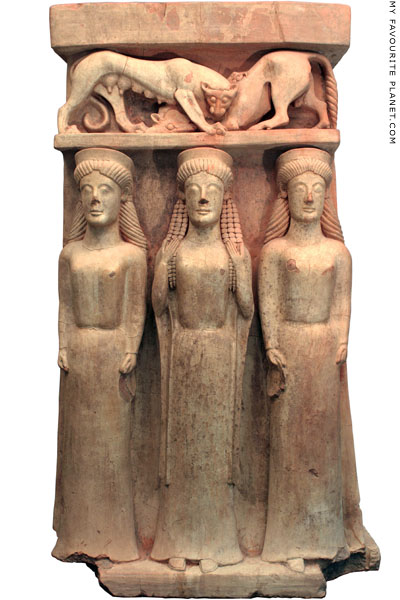
Ceramic arula (portable altar) with a high relief depicting a triad of goddesses,
probably Demeter (centre) and Persephone with Hekate, Aphrodite or Artemis.
In the register above is a zoomachy: a lioness or panther attacking a bull.
Pink clay. 500-480 BC. From the emporion (ἐμπόριον, trading centre)
at the Bosco Littorio, Gela, Sicily. Height 113 cm.
Gela Regional Archaeological Museum. Inv. No. Sop. BL 30.
|
One of three similar, well-preserved portable altars with reliefs of extraordinarily fine quality, discovered with fragments of others at the Bosco Littorio archaeological site in December 1999, during excavations by Lavinia Sole under the direction of Sopraintendente Rosalbe Panvini. The other two altars have reliefs depicting Medusa carrying Pegasus and Chrysaor, and Eos abducting Kephalos. All three are exhibited in the excellent Gela museum.
These light-weight altars, probably made in the same workshop, had apparently never been used, and may have been made for sale or export to customers who for some reason never received them. The site at the Bosco Littorio, on the coast of Gela, south of the acropolis (Lindioi) and west of the mouth of the Gelas river, is thought to have been an emporium due to finds of objects related to trade, including transport amphorae and imported vessels from Attica and Chalcis (Euboea) in Greece. The buildings at the site have been dated to the early 6th to early 5th centuries BC, and the altars appear to have been abandoned there around 480 BC, when the buildings of the area were violently burnt and destroyed.
The bodies of the altars, made of clay slabs, are hollow and perforated by large holes (see the photo on the Medusa page), making them lighter and easier to transport. These are among several portable altars found in Sicily (see, for example, a portable altar from Selinunte on the Medusa page). The reliefs, which were made separately then attached to the bodies before firing, were originally highly coloured, with red used as a background colour, and a yellow pigment which became almost vitrified (glass-like) during firing.
On this altar, three standing female figures are shown in stiff, frontal poses, typical of the Archaic period, and the braided locks of the figure in the centre are reminiscent of Daedalic style of the 6th century BC. Each wears a polos and a long-sleeved peplos. The central figure also wears a cloak, her hands resting on the braids which hang over the front of each shoulder. The other two, both probably made from the same mould, have formally styled hair with locks tied behind the ears with bands, then spiral down behind the shoulders. Their arms are at their sides and they each hold a wreath or garland in one hand. If the figures were made in the same mould, then the wreaths must have been modelled by hand after moulding.
Described as "triade divinità" (triad of female divinities), the figures have been interpreted as a triad of chthonic (underworld) goddesses. The central figure is thought to be Demeter, one of the other two Persephone, and the third possibly Hekate, Aphrodite or Artemis. The figures have been compared to those on a metope from Selinunte (see Part 1), whose identity is also uncertain.
The relief of a lean lioness attacking a bull in the upper register may further inform the debate over whether such depictions where influenced by Persian Achaemenid iconography, known from the monumental reliefs at Persepolis. It has been argued that the motif belongs to a Greek tradition which predates the arrival of the Persians in the Greek world by several centuries (see, for example, illustrations on Stageira gallery page 30). It has been suggested that the lioness killing the bull to feed her young is a symbolic echo of a priest sacrificing a bull to a deity to ensure the spiritual and physical welfare of the community.
On the sides of the altars are lotus blossoms painted in brown and black, now barely visible. The lotus flower was associated with female sexuality and fertility, birth and rebirth, and, like the poppy, with Demeter and Persephone (see Part 1). The flowers are also thought to have been used as ingredients in narcotic preparations consumed during ritual worship of the goddesses.
During my recent visit to the Gela museum the altar was in London, so I was unable to photograph it. This is a press photo for the fascinating exhibition, Sicily: Culture and Conquest, at the British Museum, 21 April - 14 August 2016. Photo © Regione Siciliana.
See: Dirk Booms and Peter Higgs, Sicily: Culture and Conquest, exhibition catalogue, pages 58-62. The British Museum, London, 2016.
The archaeological site at the Bosco Littorio is not usually open to the public, but is sporadically opened on special occasions. |
|
|
| |
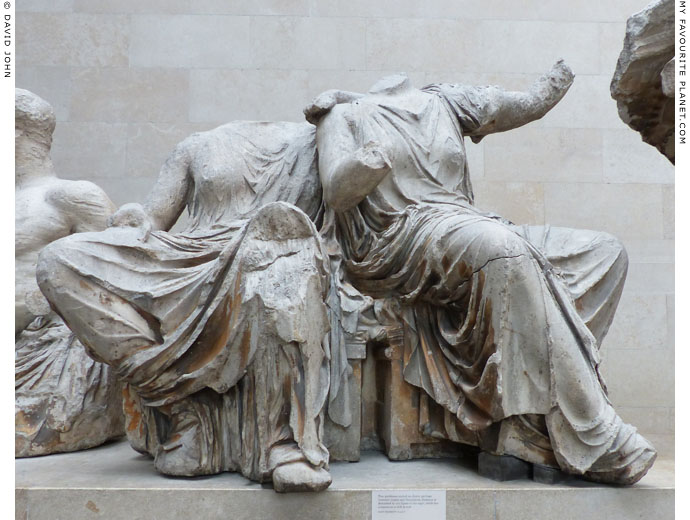
Marble statues of two goddesses seated on chests, from the east pediment of the Parthenon,
thought to depict Persephone (left) and Demeter. 438-432 BC.
British Museum. East pediment E and F. Part of the "Elgin Marbles".
|
The pedimental sculptures of the Parthenon were made of Pentelic marble by Pheidias and his pupils 438-432 BC. According to Pausanias (Description of Greece, Book 1, chapter 24, section 5), the theme of the east pediment was the birth of Athena, and that of the west pediment the contest between Athena and Poseidon for the patronage of Athens.
Each of the sculptures is actually a free-standing statue, executed in the round, rather than the type of reliefs known from the pediments of other temples (see for example the high relief of Dionysus from the Temple of Apollo in Delphi). They are remarkably detailed and finished, particularly considering that they stood so high on the Parthenon that many parts would not be visible to the viewer on the ground. An entire pediment can be seen only when standing some distance from the building; the view of the figures from the angle shown in the photo above was not possible when they were in place. Even the details such as drapery of the backs of the figures, although not of the same quality as the fronts, are finished to a surprisingly high degree.
The figure on the left rests her left forearm on the right shoulder of her companion, whose arms are raised. It has been suggested that she may surprised or disturbed by the swiftly moving figure to the right, who may be Artemis or Hebe, the cup-bearer of Zeus. The reclining nude male figure to the left of the pair has been identified as Dionysus.
The composition of this pair may have been copied by Damophon for the statue group he made for the temple of Despoina in Lykosoura (see below). |
|
|
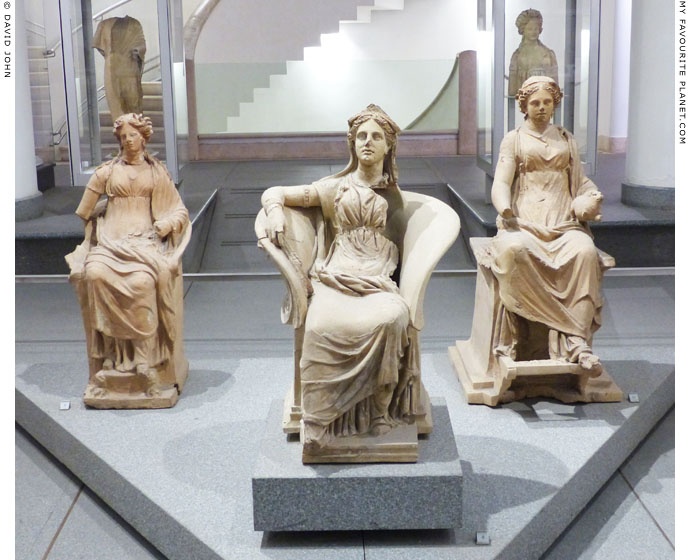
Part of the display of statues and votive objects in the Baths of Diocletian, Rome,
found at the sanctuary of Demeter and Kore (Persephone) at Casaletto, in the
territory of Ariccia, Lazio (ancient Latium), Italy.
End of the 4th - first half of the 3rd century BC. The sanctuary
was discovered by chance in 1927 by farm workers.
Epigraphic Museum, Baths of Diocletian, National Museum of Rome.
|
Ariccia (or Aricia), in the Alban Hills, 25 km southeast of Rome, was founded around 9th - 8th century BC, according to legend by Archilochos, a Siculian (Sicilian) chief. From the late 6th century BC until 338 BC it became one of the most important members of the confederation of 30 settlements and tribes of Latium, known today as the Latin League. In the first century BC Cicero (106-43 BC) described the municipium of Ariccia as "very old" and "federated", that is semi-independent and allied to Rome.
The large number of terracotta votive objects discovered at the sanctuary of Demeter and Kore, including many depictions of deities and worshippers, indicate the strong influence of the art and culture of Magna Graecia and Sicily.
The centre of the museum display is a triangular dais on which stand three ceramic statues of enthroned goddesses: the godddess on the left has not been identified, in the centre is Demeter, and on the right Kore holding a piglet. Behind this triad are a headless female statuette, a bust of Kore and a bust of Demeter (not in photo, see photos below). To the right of the dais, a glass case displays votive ceramic heads from the sanctuary.
At the time the following photos were taken the room was being renovated and some of objects were not on display. The bust of Demeter below, for example, is not the one described in the labelling and illustrated in the museum guide book [8]. |
|
| |
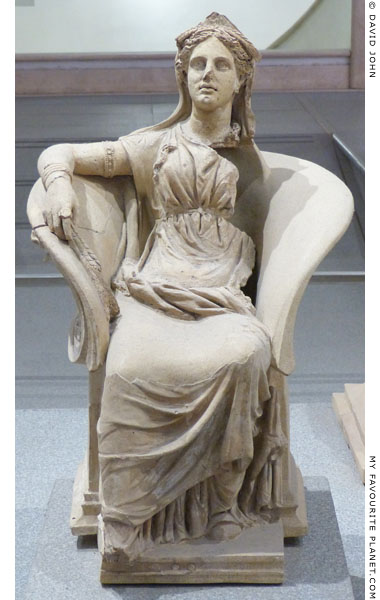 |
|
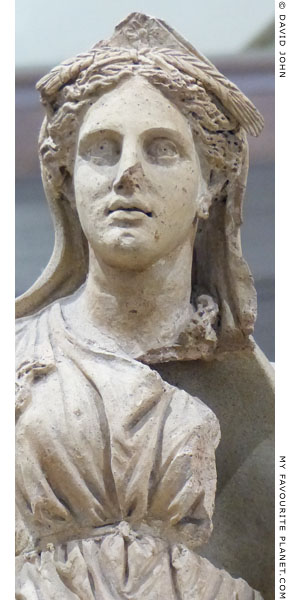 |
Ceramic statue of Demeter sitting on a richly decorated throne.
She wears a long chiton (tunic), a cloak, a diadem with ears
of corn and jewellery, and holds ears of corn in her right hand.
From the sanctuary of Demeter and Kore, Ariccia, Lazio, Italy.
Rosy-beige clay. End of the 4th - first half of the 3rd century BC.
Baths of Diocletian, National Museum of Rome. |
|
| |
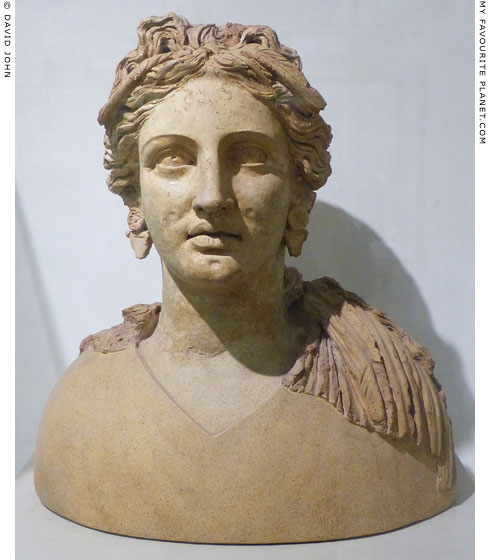
Partly restored ceramic bust of Demeter wearing a headband decorated
with ears of corn, a chiton, a cloak and rosette earrings with triangular
pendants. Her thick wavy hair is tied back and falls over her shoulders
(some of the hair and the back of the head are missing).
From the sanctuary of Demeter and Kore, Ariccia, Lazio, Italy.
Beige clay. End of the 4th - first half of the 3rd century BC.
Baths of Diocletian, National Museum of Rome. |
| |
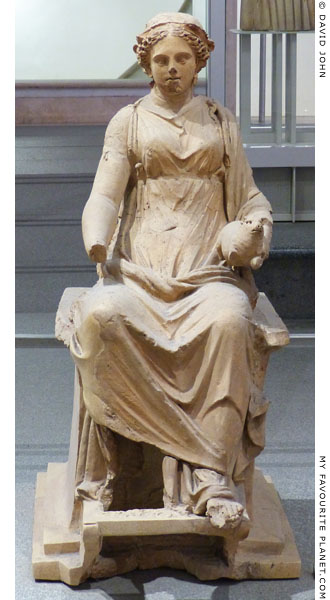 |
|
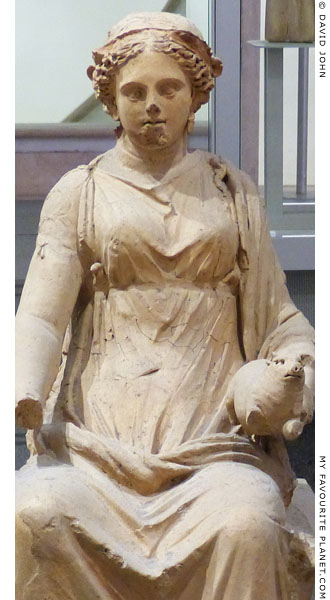 |
Ceramic statue of Kore, enthroned and holding a votive piglet in her left hand.
She wears a chiton, a cloak and jewellery similar in style to that of Magna Graecia.
From the sanctuary of Demeter and Kore, Ariccia, Lazio, Italy.
Reddish clay. End of the 4th - first half of the 3rd century BC.
Baths of Diocletian, National Museum of Rome. |
|
| |
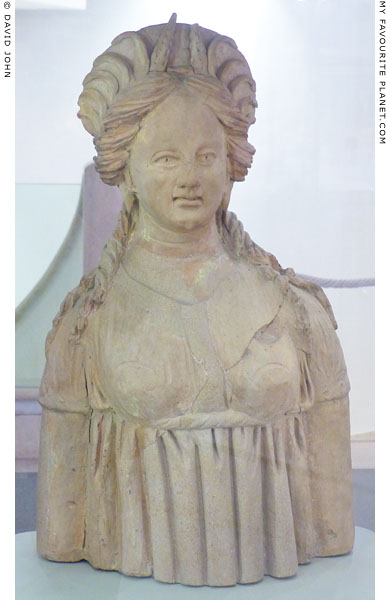
Ceramic bust of Kore wearing a headdress decorated by
two upright ears of corn and radiating forms which appear
to be snakes, and a high-belted chiton. Her plaits, which fall
over her shoulders, are also decorated with ears of corn.
From the sanctuary of Demeter and Kore, Ariccia, Lazio, Italy.
Beige terracotta. End of the 4th - first half of the 3rd century BC.
Baths of Diocletian, National Museum of Rome. |
|
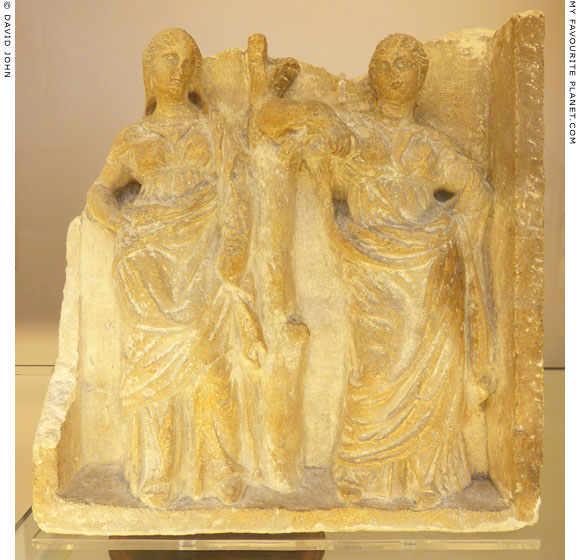
Limestone relief of two female figures, possibly Demeter and Persephone.
A metope from a Doric tomb. Made in Taranto, southern Italy around 300 BC.
British Museum. Inv. No. Gr 1873.8-20.746 (Sculpture 793). |
| |
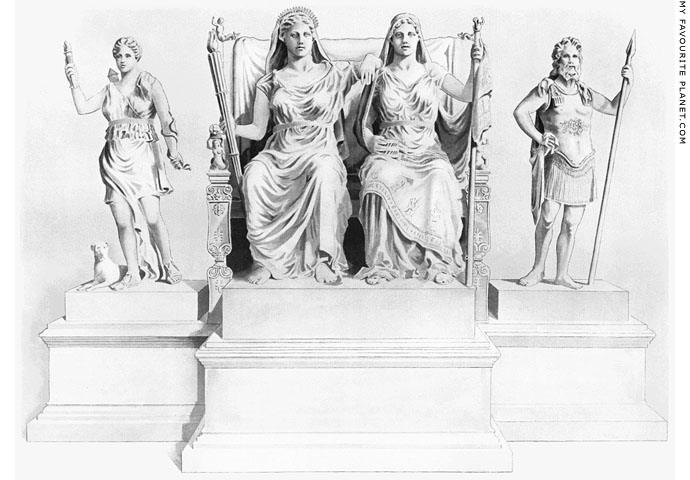
Reconstruction drawing of the Lykosoura statue group by Damophon of Messene,
in Lykosoura on Mount Lykaion, Arcadia, southwestern Peloponnese. 190-180 BC.
Left - right: Artemis, Demeter, Despoina (Persephone), the Titan Anytos.
National Archaeological Museum, Athens.
Reconstruction by Guy Dickins of the British School at Athens, 1906.
Based on several fragments discovered during excavations and a
description of the statue group by Pausanias [9]. |
| |
The Lykosoura statue group
The Arcadian city Lykosoura (Λυκόσουρα) on Mount Lykaion and its sanctuary of Demeter and Despoina (Δέσποινα, usually translated as the Mistress, see note in Part 1) are considered to have been very ancient. The only ancient source on the location, Pausanias, reported the claim that it was the oldest city in the world.
"A little farther up is the circuit of the wall of Lycosura, in which there are a few inhabitants. Of all the cities that earth has ever shown, whether on mainland or on islands, Lycosura is the oldest, and was the first that the sun beheld; from it the rest of mankind have learned how to make them cities.
On the left of the sanctuary of the Mistress is Mount Lycaeus. Some Arcadians call it Olympus, and others Sacred Peak. On it, they say, Zeus was reared."
Pausanias, Description of Greece, Book 8, chapter 38, sections 1-2. At Perseus Digital Library.
Demeter and Despoina were worshipped there according to the archaic Arcadian chthonic rites, thought to be quite different from those of the Eleusinian cult, and perhaps closer to those of the oriental Kybele or Magna Mater (Great Mother).
Pausanias wrote that when the Arcadians united (forming a synoikism) to found the city of Megalopolis (Μεγαλόπολις) around 370 BC because of the fear of Spartan expansion, the inhabitants of several Arcadian settlements were forced to move there. Those who dissented were either massacred or fled the Peloponnese. The Lykosourians refused to give up their city but were spared because they took refuge in the sanctuary of Demeter and Despoina (Description of Greece, Book 8, chapter 27, sections 1-6). Later the Eleusinian cult spread through Arcadia, probably after being introduced to Megalopolis.
Although the location of Lykosoura was identified by the British traveller Edward Dodwell in 1806, the first excavations there were undertaken by the Greek Archaeological Society in 1889, 1890 and 1895, directed by Panagiotis Kavvadias (Παναγιώτης Καββαδίας, 1850-1928) and Konstantinos Kourouniotis (Κωνσταντίνος Κουρουνιώτης, 1872-1945), who also founded the small museum at the site. During the excavation of the Doric temple of Despoina (see plan below) over a hundred fragments of a group of four larger than lifesize statues were discovered [10].
Guy Dickins of the British School at Athens reconstructed the composition of the statues with the aid of the description of the group by Pausanias (see below). His reconstruction appeared to be largely confirmed a few years later by the publication by the Greek archaeologist Valerios Stais (Βαλέριος Στάης, 1857-1923) of a Roman Imperial period coin minted by nearby Megalopolis (7 km to the east), which had been locked away in the Athens museum (see photo, below right). On the obverse side of the coin is the head of Julia Domna (170-217 AD), second wife of Emperor Septimius Severus (reigned 193-211 AD), and on the reverse what is thought to be a representation of the Lykosoura statue group.
The group was around 5.6 metres high, including the 8.4 metre long, T-shaped limestone pedestal. Although Pausanias described the statues he saw as "made from a single piece of stone", this group was constructed of several separately worked pieces joined by iron and lead dowels and cement. Modern scholars have concluded that he may have been misinformed by his local guides, which has led to the question of whether he was also misled into believing the group was by Damophon. Konstantinos Kourouniotis commented:
"One imagines that Pausanias derived the story about the single block of marble, from which the group of Demeter and Despoina was constructed, from servants of the temple who were in the habit of playing on the credulity of tourists in order to enhance the miraculous nature of their sanctuary." [see note 9]
The statues were orginally brightly coloured (polychrome). In the centre Demeter and Despoina were seated together on a wide throne, covered with a cloth and decorated with figures of female Tritons on the backrest and arms. The Korybantes were depicted on the base of the throne, and the Kouretes on the footstool (not shown in Dickins' reconstruction). Demeter sat on the viewer's left, holding a long torch in her right hand, and with her left arm resting on the right shoulder of Despoina, who held a sceptre in her left hand, and in the right hand, which rested on her lap, the cista mystica. The height of the Demeter figure is estimated to have been around 4 metres. Guy Dickins (Damophon of Messene II, pages 396-397, see note 9) remarked on the similarities of the seated pair with that of the figures on the East Pediment of the Parthenon (see above).
The other two statues were at a slightly smaller scale, around 3.3 - 3.8 metres tall. Left of the throne stood Artemis, wearing a nebris (deerskin) and a quiver, holding a torch in her right hand and two snakes in the left. At her side was a female hunting dog. To the right stood the Titan Anytos (Ἄνυτος), wearing armour and holding a spear. According to the Arcadian myth related by Pausanias, Artemis was the daughter of Demeter, and Despoina was raised by Anytos.
Since Dickins' reconstruction, further fragments of the group have been discovered, and a number of scholars have attempted to reappraise and reconstruct the composition anew. Among the surviving fragments are also parts of Despoina's folded veil, finely decorated with horizonzal bands of reliefs imitating embroidery, depicting eagles with winged thunderbolts (symbols of Zeus), Tritons and Nereids with sea horses and dolphins (associated with Poseidon), Nikes (or Nikai) carrying censers, and dancing figures with animal heads or masks. The iconography of this decoration has led to further speculation over the nature of the cult practiced at the sanctuary.
The heads of Demeter, Artemis and Anytos, as well as part of Despoina's himation (Inv. No. 1737, see photo, right) and four statues of Tritonesses (Inv. Nos. 2171, 2172, 2174, 2175) are kept in the Athens museum. Fragments of the throne and torsos of the figures are in the Lykosoura Archaeological Museum. These fragments were also originally planned for removal to Athens, but fortunately for the Lykosoura museum, at the time the bad state of the roads prevented the transportation of the fragile torsos.
"The actual images of the goddesses, Mistress and Demeter, the throne on which they sit, along with the footstool under their feet, are all made out of one piece of stone. No part of the drapery, and no part of the carvings about the throne, is fastened to another stone by iron or cement, but the whole is from one block. This stone was not brought in by them, but they say that in obedience to a dream they dug up the earth within the enclosure and so found it. The size of both images just about corresponds to the image of the Mother at Athens.
These too are works of Damophon. Demeter carries a torch in her right hand; her other hand she has laid upon the Mistress. The Mistress has on her knees a staff and what is called the box, which she holds in her right hand. On both sides of the throne are images. By the side of Demeter stands Artemis wrapped in the skin of a deer, and carrying a quiver on her shoulders, while in one hand she holds a torch, in the other two serpents; by her side a bitch, of a breed suitable for hunting, is lying down.
By the image of the Mistress stands Anytus, represented as a man in armour. Those about the sanctuary say that the Mistress was brought up by Anytus, who was one of the Titans, as they are called. The first to introduce Titans into poetry was Homer *, representing them as gods down in what is called Tartarus; the lines are in the passage about Hera's oath. From Homer the name of the Titans was taken by Onomacritus, who in the orgies he composed for Dionysus made the Titans the authors of the god's sufferings.
This is the story of Anytus told by the Arcadians. That Artemis was the daughter, not of Leto but of Demeter, which is the Egyptian account, the Greeks learned from Aeschylus the son of Euphorion. The story of the Curetes, who are represented under the images, and that of the Corybantes (a different race from the Curetes), carved in relief upon the base, I know, but pass them by.
The Arcadians bring into the sanctuary the fruit of all cultivated trees except the pomegranate. On the right as you go out of the temple there is a mirror fitted into the wall. If anyone looks into this mirror, he will see himself very dimly indeed or not at all, but the actual images of the gods and the throne can be seen quite clearly."
* Homer, The Iliad, 14.279.
Pausanias, Description of Greece, Book 8, chapter 37, sections 3-7. At Perseus Digital Library. |
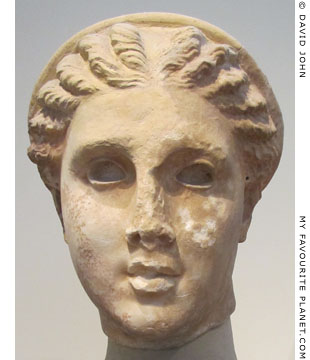
Head of Artemis from the Lykosoura
statue group by Damophon.
190-180 BC. Doliana marble. Height 48 cm.
The goddess wears a wreath. The eyes
were inlaid, and there are holes for
attaching metal jewellery. The torso
and parts of the limbs are kept in the
Lykosoura Archaeological Museum.
National Archaeological Museum,
Athens. Inv. No. 1735. |
| |
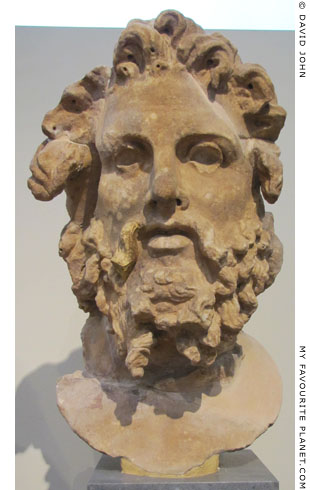
Head of the Titan Anytos from the
Lykosoura statue group by Damophon.
190-180 BC. Doliana marble. Height 74 cm.
The eyes were inlaid.
National Archaeological Museum,
Athens. Inv. No. 1736. |
| |
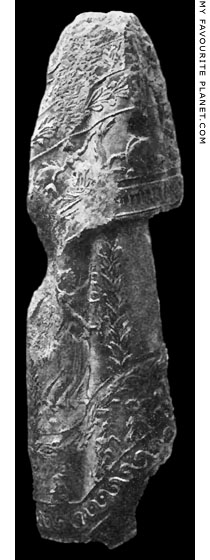
A fragment of Despoina's himation
decorated with reliefs, from the
Lykosoura statue group.
See also below.
National Archaeological Museum,
Athens. Inv. No. 1737.
Image source:
Ernest Arthur Gardner, A Handbook
of Greek Sculptures Part 2, Fig. 97,
page 402. Macmillan and Co., London,
1897. At the Internet Archive. |
| |
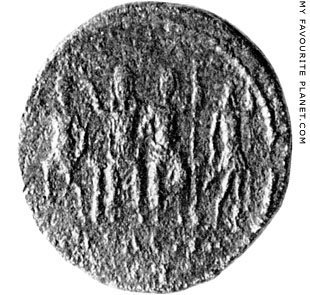
The Roman period coin of Megalopolis
thought to depict the Lykosoura
statue group by Damophon.
Early 3rd century AD.
National Archaeological Museum, Athens.
First published by the Greek archaeologist
Valerios Stais (Βαλέριος Στάης, 1857-1923,
Director of the National Archaeological
Museum, Athens 1887-1923) in the Journal
International d'Archéologie Numismatique. |
| |
| |
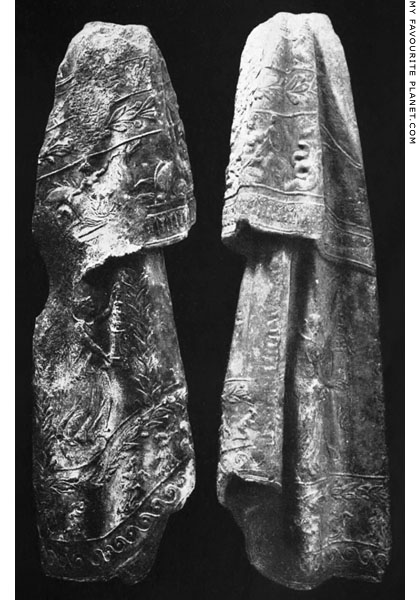
Two views of "Despoina's veil", the himation fragment from the
Lykosoura group, covered with reliefs imitating embroidery.
National Archaeological Museum, Athens. Inv. No. 1737.
|
Guy Dickins was not overly impressed with Damophon's skill or orginality as an artist, considering him to have borrowed from the schools of Pheidias, Praxiteles and Lysippos, and to have been influenced by the sculptors of Pergamon. On the other hand, he admitted some qualified admiration for the reliefs on the himation, which he presumed were made by Damophon himself.
"Damophon's style then was academic and eclectic, borrowing from all sources of inspiration and in general using up over again well-known groups and poses. His execution is even more interesting for its extraordinary inequality. His heads are on the whole very good. The Demeter is a dull piece of work, but both the Anytos and the Artemis show some fancy and some power of original expression. The girl is demure and cheerful, the giant benevolent and rather sly.
But when we come to examine the execution of the fragments of the bodies and limbs which survive at Lycosura, we find a very hasty and poor technical ability. The arms and legs are nearly shapeless. They are colossal, but practically formal in design, and details of muscles and sinews are almost entirely omitted. The drapery makes some effort to follow Pheidian designs, but it is poorly carved and without effect.
Only in one direction does the artist show any skill, and that is in the great embroidered veil worn by Despoina. This is an extraordinary tour de force, not for its sculptural effect, which is purely formal, but for the reproduction of a complicated embroidered design in very low relief. A border of tassels with bands of design about it and large embroidered figures of Victory [Nike] above the bands is rendered with consummate art. We have a frieze of sea-monsters, nymphs, and Erotes according to a common Hellenistic design, a curious local dance of beast figures in human dress, a dance paralleled by some small terra-cotta figures found in the same shrine, and the larger figures of Victory above carrying candelabra.
It is interesting to see the total want of proportion in the artist's mind, who could devote so much time and originality to a comparatively unimportant piece of decoration, while treating the main lines of his drapery with carelessness and monotony.
It is probable that we have here a procedure to be noticed in the Demeter of Cnidos a head done with great care and placed on a torso of inferior execution. While Damophon worked the heads of all the figures and the drapery of Despoina, he must have left the rest of his group to a band of journeymen assistants. We know from inscriptions that Damophon had two sons, Xenophilos and another whose name is lost. It is, therefore, possible that Xenophilos and Straton, the Argive sculptors, were his sons. Their subjects were similar, and their Asklepios, as shown on a coin, is identical with Damophon's."
Guy Dickens, Hellenistic sculpture, Fig. 48, pages 61-62. Clarendon Press, Oxford, 1920. At the Internet Archive.
For more about Xenophilos and Straton, see Damophon. |
|
|
| |
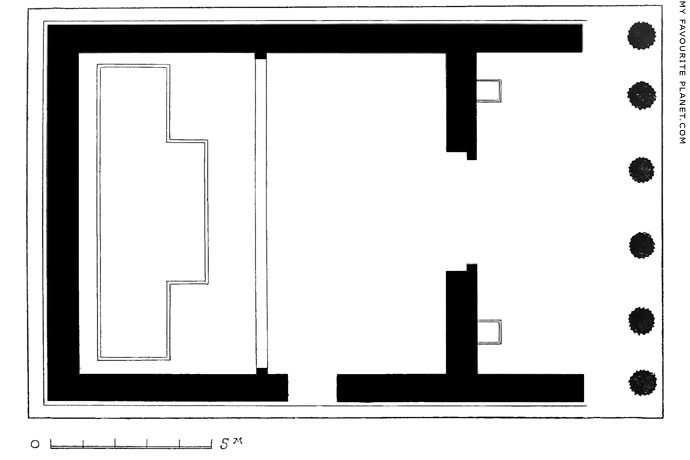
A plan of the temple of Despoina at the sanctuary of Demeter and Despoina,
Lykosoura, showing the location of the T-shaped pedestal (bathron) of the
statue group at the west end of the 10 metre wide cella (left).
Source: Charles Nicolas Normand, Corpus des monuments grecs: Lycosoura,
Planche 8. l'Ami des Monuments et des Arts, Paris, 1892. At the Internet Archive.
See also a plan of the sanctuary below.
|
The temple was discovered during excavations by Panagiotis Kavvadias July-November 1889, around 100 metres west of the ruins of a chapel of Agios Athanasios. It is prostyle-hexastyle, that is with a row of six Doric columns across the front only. The stylobate (platform), oriented east-west, is 11.15 metres wide and 21.35 metres long. The pronaos (front porch) at the east end lead to the cella (inner chamber) in which the cult statues stood, and which had a mosaic floor. Thought to have been built in the 4th century BC, the temple was repaired several times during the Roman period.
"The ground-plan of the temple has been clearly made out, and it is seen to be a Doric hexastyle-prostyle, twenty metres long by ten broad, the cella being thirteen metres long. In the walls of the cella, the lower courses are of masonry of local stone, the upper courses are of unburnt brick. The temple was oriented from east to west, and had a marble portico at the entrance, which seems to have been filled with votive offerings, the bases of which are extant."
Charles Waldstein, Lykosoura - Temple of Depoina = Persephone, The American Journal of Archaeology and of the History of the Fine Arts, Volume 6, No. 1/2 (Mar. - Jun. 1890), pages 209-211. At jstor.org. |
|
|
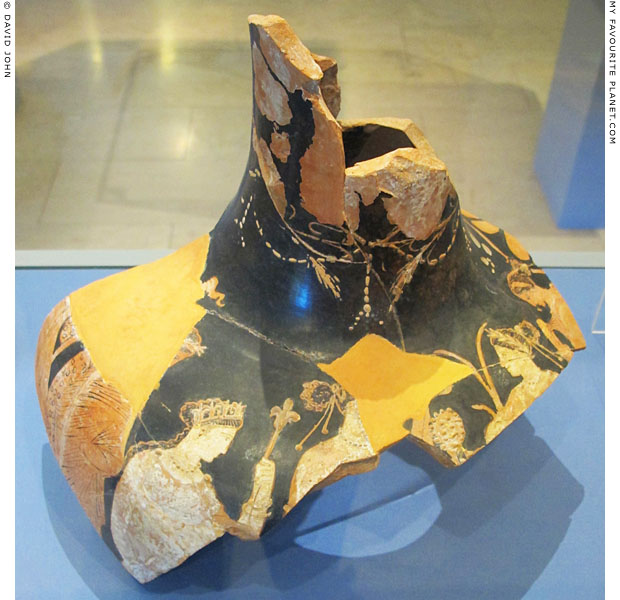
Restored fragments of a red-figure hydria with a scene of the Eleusinian circle of deities.
2nd half of the 4th century BC. From the Gymnasium, Amphipolis, Macedonia, Greece.
Amphipolis Archaeological Museum. |
| |
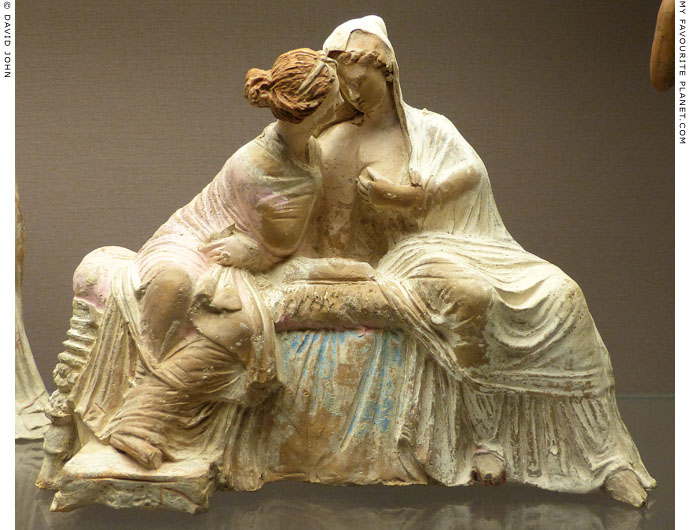
Terracotta group of two seated female figures,
possibly Demeter and Persephone.
Made in Myrina, northwest Anatolia (Asia Minor),
around 100 BC. Said to be from Asia Minor. Height 20.3 cm.
British Museum. Inv. No. Gr 1885.3-16.1 (Terracotta C 529). |
| |
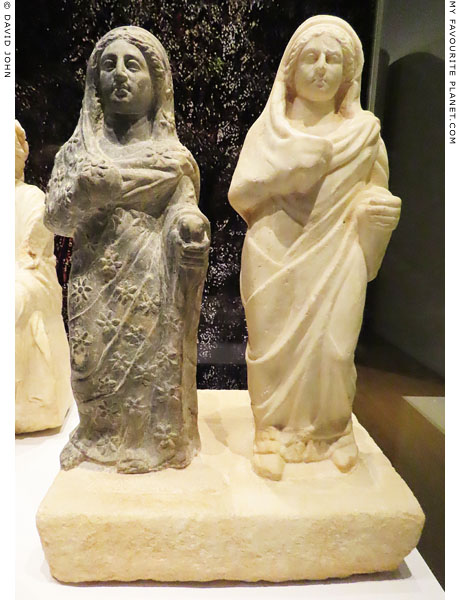
Two marble statuettes on a single base, perhaps representing Demeter and Persephone.
Found in the "Villa of Theseus", Nea Paphos, southwestern Cyprus. 100-200 AD.
Paphos Archaeological Museum, Cyprus.
Exhibited in the exhibition Cyprus - Eiland in beweging (Cyprus - a dynamic island),
Rijksmuseum van Oudheden, Leiden, Netherlands, 11 October 2019 - 15 March 2020.
|
Like the head of the statuette of Demeter from Paphos above, the statuettes were found by Polish archaeologists in Room 18 of the "Villa of Theseus" in Nea Paphos, during excavations in 1966-1967.
The two female figures stand side by side in similar poses, each with the body, arms and legs as well as the back of the head covered by a himation (cloak). The figure on the right is made of white marble and is slightly taller. The left-hand figure is made of dark grey marble, and her himation is covered with a regular pattern of stars in relief. In her right hand she holds a fruit, perhaps a pomegranate, and at the top of her clenched left hand is a rounded object (a fruit, a loaf, a cake?). The facial features of the figures are similar, although the right-hand figure appears to be older and her head larger.
As with many sculptures of the Classical to Roman periods found on Cyprus, it been questioned whether they were made on the island or imported. And as with many such ancient sculptures, the questions also arise of whether they are original creations or copies of other works; do they depict individuals (as portraits) or are they more generalized or idealized personifications.
The identities of the figures has been debated by a number of scholars. The exhibition labelling identifies them as Demeter and Persephone ("Dubbelbeeld van Demeter en Persephone"), but several other suggestions have been made: Demeter and Isis (Isis Ourania or Isis-Aphrodite); Aphrodite Urania and Aphrodite Pandemos; double Nemesis, showing two aspects of the goddess night/death and day/birth/life. It has also been argued that they may be priestesses or worshippers (votaries).
For a good introduction to sculptures from the Villa of Theseus in particular and Cyprus in general, see the link to the article by Panayiotis Panayides above. |
|
| |
| |
Depictions of Persephone |
 |
|
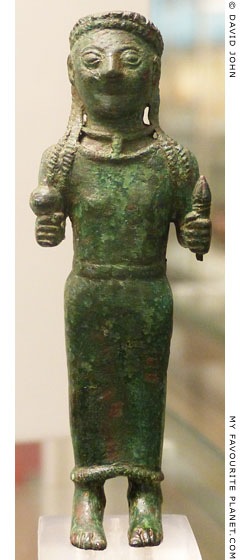
Small bronze figure holding
a torch and a pomegranate,
probably Persephone.
Greek, around 560 BC.
Probably from Athens.
British Museum.
Inv. No. GR 1900.7-27.2. |
|
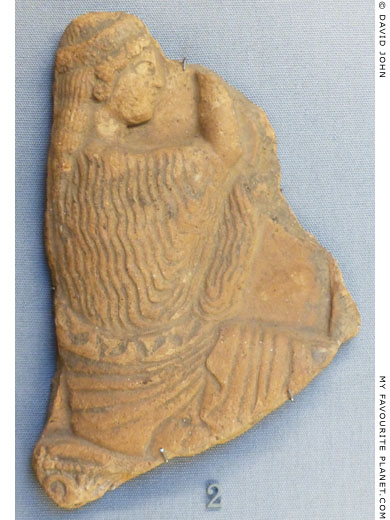
Fragment of a terracotta plaque showing Persephone
seated (beside Hades, now missing).
Made in Medma, southern Italy, around 470 BC.
Height 14 cm.
British Museum. GR 1889.5-21.5 (Terracotta 1220).
Purchased in 1889 from Rev. Greville John Chester. |
|
| |
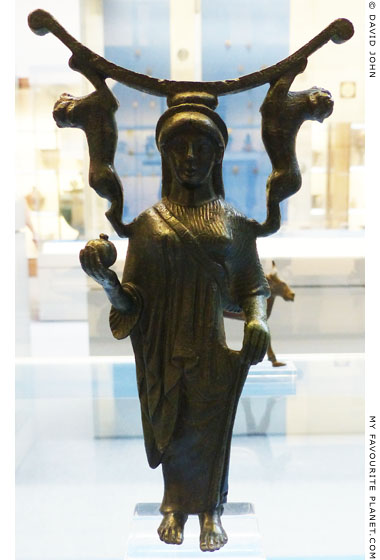
Bronze mirror support in the form of a
female figure holding a pomegranate, and
with a lioness standing on each shoulder.
Made in Magna Graecia (southern Italy)
around 500 BC, perhaps in Croton.
British Museum.
Inv. No. GR 1824.4-72.4 (Bronze 549).
Bequeathed by R. Payne Knight. |
|
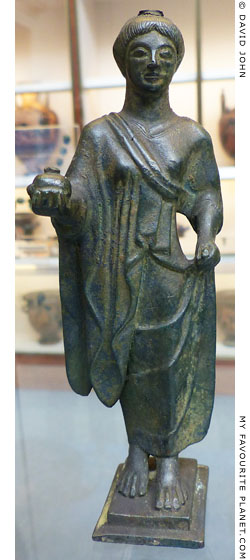
Bronze mirror support in the form of a
female figure holding a pomegranate.
Made in Campania, Magna Graecia
(southern Italy) around 480 BC.
British Museum.
Inv. No. GR 1824.4-72.2 (Bronze 198).
From Rome.
Bequeathed by R. Payne Knight. |
|
| |
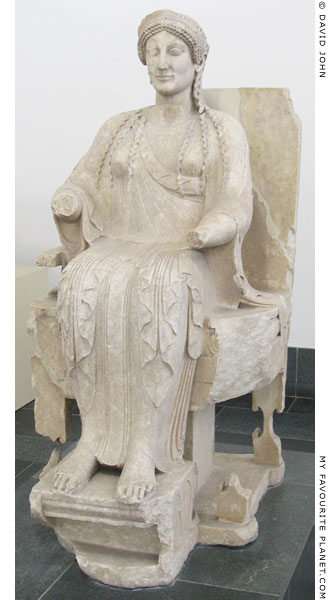 |
|
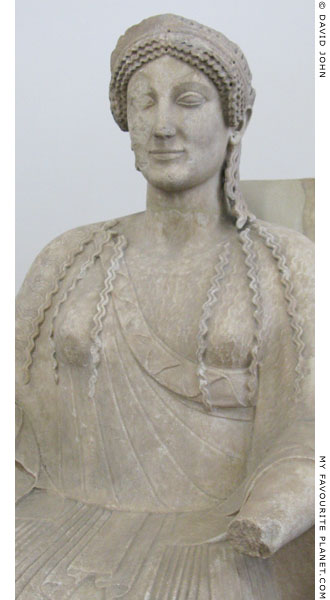 |
"The Goddess of Tarentum", a marble statue of an enthroned goddess,
perhaps a cult statue of Persephone as the queen of the Underworld.
Hera and Aphrodite have also been suggested.
475-450 BC. From Tarentum or Locri, southern Italy.
Antikensammlung, Berlin State Museums (SMB). Inv. No. Sk 1761.
Acquired in 1915. |
|
| |
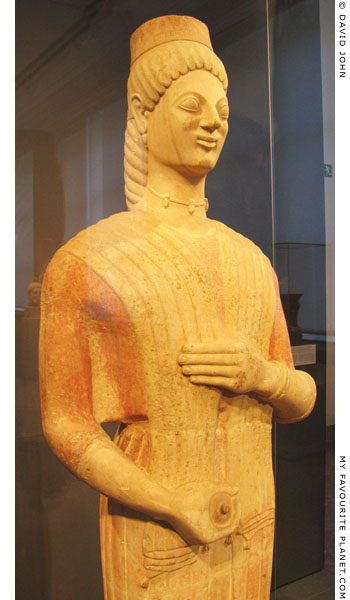 |
|
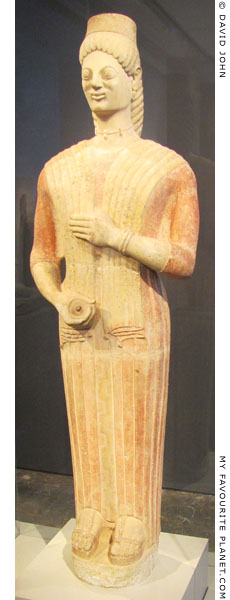 |
"The Berlin Goddess", a marble kore statue of a standing female, wearing
a red polos and long garment, holding a pomegranate in her right hand.
Thought to be the funerary statue of a woman from a wealthy family
represented as "the bride of the Underworld god Hades", i.e. Persephone.
580-560 BC. From a rural cemetery at Keratea, Attica, Greece. Height 190 cm.
Altes Museum, Berlin. Inv. No. Sk 1800.
Purchased on the art market in 1924. |
|
| |
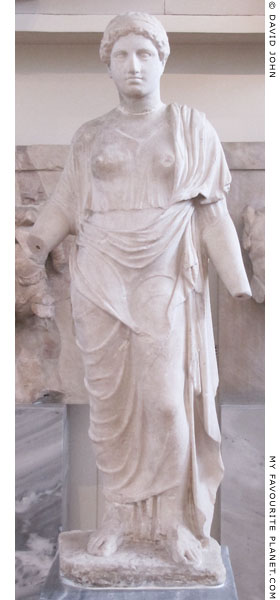 |
|
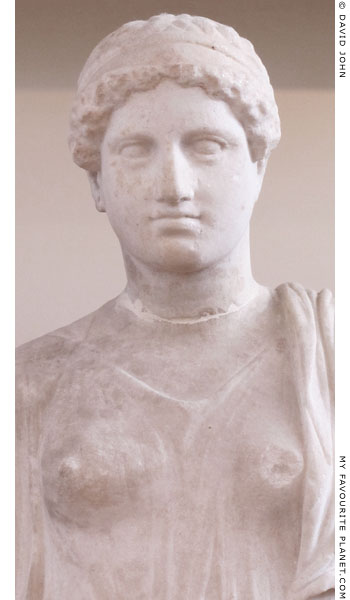 |
Marble statue of Persephone.
Work of the school of Agorakritos of Paros, circa 420-410 BC.
Found on the hill of Mounychia, Piraeus. Pentelic marble. Height 77 cm.
The goddess would have originally held a torch in each hand.
National Archaeological Museum, Athens. Inv. No. 176.
See also a statue of Demeter attributed to Agorakritos in Part 1. |
|
| |
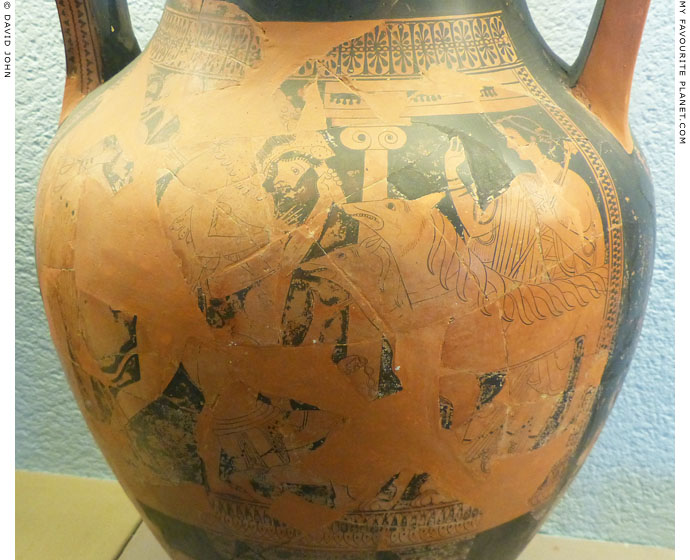
Detail of an fragmentary Attic red-figure amphora showing Herakles capturing the two-headed
guard dog of Hades, Cerberus (Κέρβερος, Kerberos), one of his twelve labours, in the presence
of Athena (far left, head now missing). An Ionic column and part of an architrave indicate the
entrance to the underworld kingdom of Hades. Immediately in front of Herakles, a kneeling
figure wearing a petasos hat and holding the hell hound's chain is thought to be Hermes.
To the right, behind Cerberus, stands Persephone, holding a sceptre in her left hand and her
right hand raised. According to the museum labelling, "Persephone, Queen of the Afterlife,
represented on the right, flees in terror". However, she appears to be either greeting the
other three figures, or telling Herakles to stop trying to take Cerberus.
Attributed to the Painter of Nikoxenos. End of the 6th century BC. Found in
a votive deposit in the southern sanctuary, north of the "Temple of Poseidon",
Paestum (ancient Poseidonia, see above), Campania, Italy.
The other side of the amphora shows four Amazons putting on their armour.
National Archaeological Museum of Paestum, Campania, Italy. |
| |
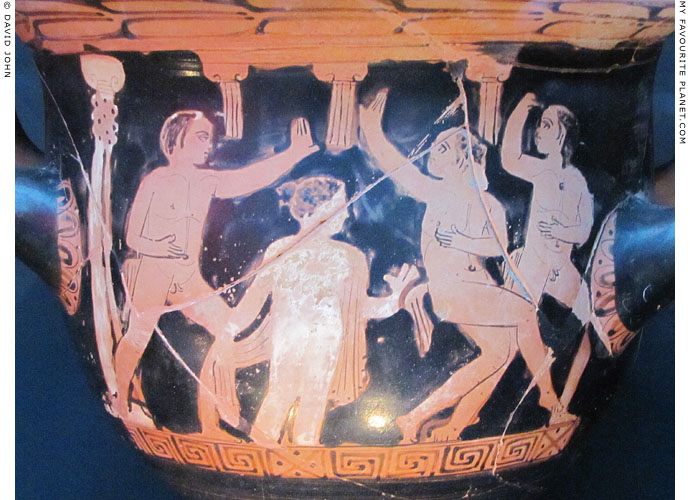
Detail of an Attic red-figure bell krater with a depiction of Persephone emerging from
the earth among three young Satyrs. The scene was probably inspired by a satyr play.
Made in Athens, 380-360 BC. Attributed to the Upsala Painter.
From Akanthos (Ἄκανθος), Halkidiki, northern Greece.
Thessaloniki Archaeological Museum. Inv. No. 93.
|
The figures have a pinkish tone, with added white, now worn, on the head, body and arms of Persephone, a thyrsos and the Ionic column on which it rests, to the left of the scene. The tops of three other Ionic columns and part of an architrave can be seen behind the figures. Persephone is seen from the knees upwards, her lower legs being still below the earth. Her body is shown frontally and she appears to be naked, apart from a himation (cloak) draped over her left shoulder. With her lowered right hand she holds one end of the garment, her left hand is raised, and her head is turned to her left. The three naked Satyrs (one on the left, two on the right) appear to be dancing, each with one arm raised. The museum labelling describes them as being startled by Persephone's appearance.
The scene of Persephone's annual return to above the earth from her obligatory stint with Plouton in the Underworld is referred to as the anodos (ἄνοδος, the way upwards), as opposed to her descent to Hades, the kathodos (κάθοδος, the way down). She is sometimes depicted as being brought back to the surface by Plouton in a chariot (see image below).
The painting on the other side of the vase shows draped youths.
Beazley Archive Database, Vase No. 9026322 |
|
| |
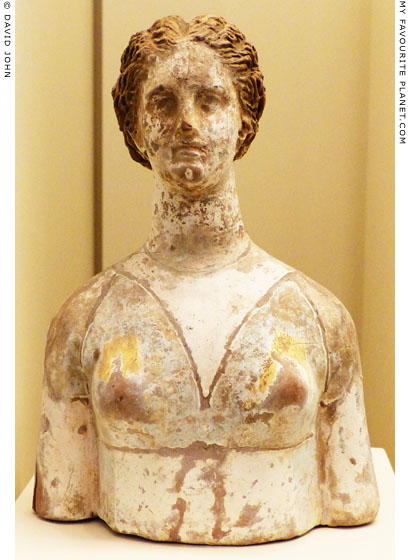
Ceramic bust of Persephone from Egypt.
Hellenistic period.
Egyptian Collection, National Archaeological
Museum, Athens. Inv. No. 2627. |
| |
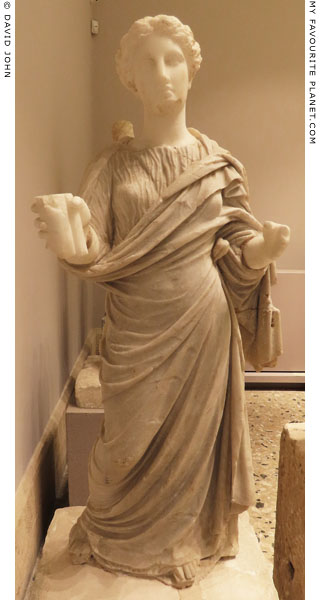
Marble statuette of Persephone from Kos.
4th century BC.
Kos Archaeological Museum. |
|
|
|
| |
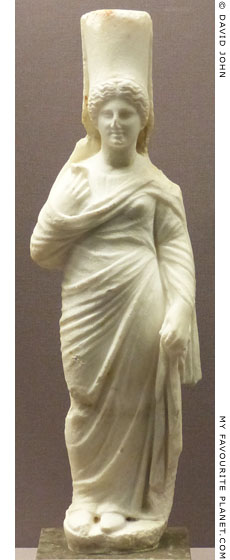
Marble statuette of Persephone
wearing a high polos and holding
a pomegranate flower.
Around 350-300 BC. Excavated in
1858 by Charles Thomas Newton,
in the sanctuary of Demeter,
Knidos, Caria. [see note 1]
The pomegranate played an important
role in the cult of Persephone, since she
had eaten its seeds in the Underworld.
British Museum.
GR 1859.12-26.43 (Sculpture 1302). |
|
|
|
| |
|
| |
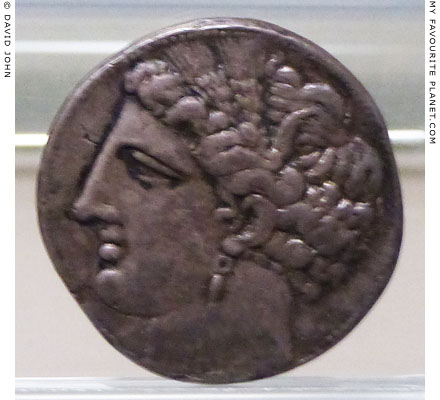
Sicilo-Punic dekadrachm with the head of Tanit-Persephone-Demeter,
facing left, wearing a corona spicea (a crown of ears of grain) and
a pendant earring.
4th century BC. Diameter 38 mm, weight 29.41 grams.
Civic Archaeological Museum, Milan. Inv. No. Brera, n. 4290. |
| |
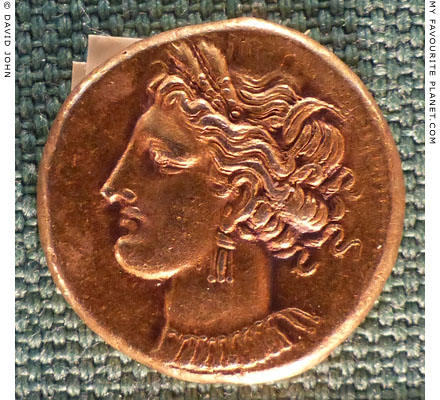
Carthaginian stater with the head of Tanit-Persephone-Demeter,
facing left, wearing a corona spicea (a crown of ears of grain),
a triple-pendant earring and necklace with several pendants.
4th century BC. From Selinous (Selinunte), Sicily
(see Demeter and Persephone part 1).
Museo Civico, Castelvetrano, Sicily.
|
From 600 to 265 BC the Carthaginians (known to the Romans as Punici, Punics) and Greek colonists fought bitterly for dominance in Sicily, after which the Romans continued fighting Carthage for the control of the western Mediterannean. In some cases Sicilian Greek colonies sided with the Carthaginians against rival Greek cities and tyrants. The Carthaginians only began minting coins around the time of the Second Sicilian War (or Greco-Punic War, 410-340 BC) in order to pay for mercenary armies. From around 410 to 307 BC they gained control of several areas in the west of the island and part of the north coast, and established mints, including one at Panormos (Greek, Πάνορμος; Punic, Ziz; today Palermo).
Sicilian Greek die engravers, perhaps those whose home cities had been destroyed or taken over during the wars, designed coins for the Carthaginans, adapting motifs used in Greek cities such as Syracuse (see examples on the Nike page) as well as elements of Punic iconography. Tanit, the chief goddess of Carthage, was portrayed in the same way as the Greek nymph Arethousa or as Persephone. Notably, these Sicilo-Punic coins are usually referred to as multiples of the Greek drachma, based on the weight of around 4.3 grams. The Carthaginian or Punic shekel typically weighed around 7.2 grams in silver and 7.5 grams in gold, and probably preceded the Tyrian shekel of Phoenicia (see Big Money at The Cheshire Cat Blog), which developed around 300 BC.
Although the heads on the coins have been identified as being based on depictions of Persephone, they are very similar to those on Greek coins thought to show Demeter (see photo above). The head of Persephone appeared on Syracusan coins, particularly on tetradrachms issued around 310-304 BC by Agathocles of Syracuse (Ἀγαθοκλῆς, tyrant of Syracuse 317-289 BC, and king of Sicily 304-289 BC). The heads are similar to this one and are labelled ΚΟΡΑΣ (her name in the genitive case). When Agathocles landed in Africa in 310 BC, during his campaign against Carthage, he is said to have sacrificed to Demeter and Kore and dedicated his fleet to the goddesses before burning all sixty ships (Diodorus Siculus, Historical Library, Book XX, chapter 7).
The reverse side of these types of coins usually showed Pegasus (see Medusa), a horse or a horse's head, often with Punic inscriptions. The reverse of the Sicilo-Punic dekadrachm above shows Pegasus flying to the right and the Punic legend B'RST ("in the territories"). Some scholars have dated coins of this type to the period of the First Punic War with the Roman Republic (264-241 BC). See, for example:
Ancient Coinage of Sicily, Punic. At wildwinds.com.
The cult of Demeter and Persephone was officially recognized in Carthage itself around 396 BC. According to the Sicilian historian Diodorus Siculus (Διόδωρος Σικελιώτης, 1st century BC) worship of the goddesses was initiated there in order to "propitiate the gods who had been sinned against", after their general Himilco had plundered the temples of Demeter and Kore in Syracuse (see part 1) during his unsuccessful siege of the city in 396 BC [11].
The use of Greek iconography on Sicilo-Punic coinage is an indicator the complex relations of the ethnic groups on the island, a subject which has only recently been examined in depth. See, for example:
Jonathan R. W. Prag, Siculo-Punic Coinage and Siculo-Punic Interactions. In: M. Dalla Riva (editor), Meetings between Cultures in the Ancient Mediterranean. Proceedings of the 17th International Congress of Classical Archaeology, Rome, 22-26 September 2008. Published online in Bollettino di Archeologia online, I, 2010, Volume speciale. |
|
| |
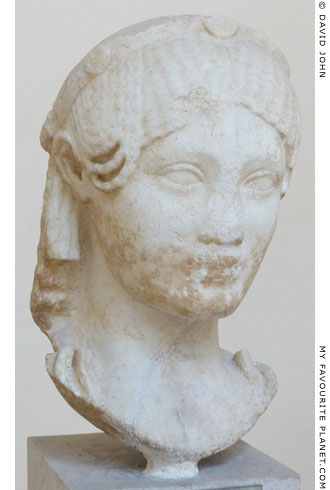
Archaistic marble head of a kore.
Found in the Domus of Fortuna
Annonaria (V,II,8), Ostia.
Ostia Archaeological Museum. Inv. No. 102.
|
|
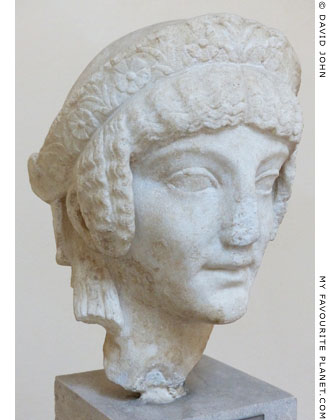
Archaistic marble head of a kore.
Late 1st century BC or early 1st century AD.
Found in the Tomb of Julia Procula (Tomb 97),
necropolis of Portus on the Isola Sacra, Ostia.
Ostia Archaeological Museum. Inv. No. 104. |
|
| The two heads are exhibited next to each other in the Ostia museum without explanation other than "Testa di Kore" and the findspot of each. Little has been written about these sculptures, although the head on the right has been described as depicting Minerva-Athena. Identification of many ancient buildings and objects at Ostia has proved difficult, often due to the lack of inscriptions, literary evidence and other archaeological clues. Both females wear diadems decorated with flowers, and those of the head on the right appear similar to the stylized poppies and lotus blossoms associated with the cult of Demeter and Persephone. |
|
| |
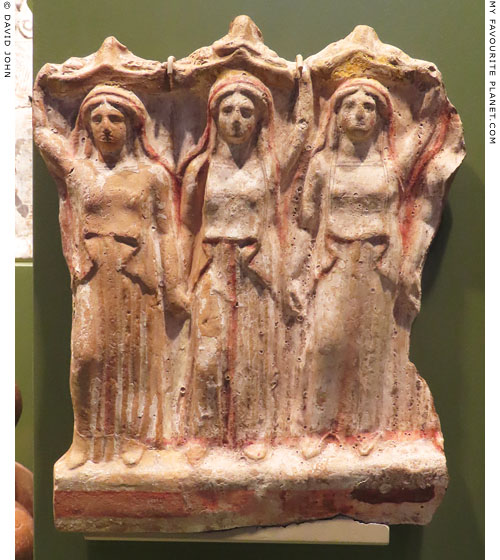
A fragment of a painted ceramic pinax (plaque) with a relief of three
women, each carrying on her head a basket of offerings for Persephone.
On the right side of the broken plaque is part of a fourth woman. They
are described by the museum labelling as "girls" (in Dutch as "meisjes",
maidens) but by the museum's website as "women".
450-425 BC. Made in Tarentum (Greek, Τάρᾱς, Taras;
today Taranto), Apulia, southern Italy. Height 25.2 cm.
Allard Pierson Museum, Amsterdam. Inv. No. APM 1159. |
| |
| |
Persephone and Plouton (Hades) |
 |
|
| |
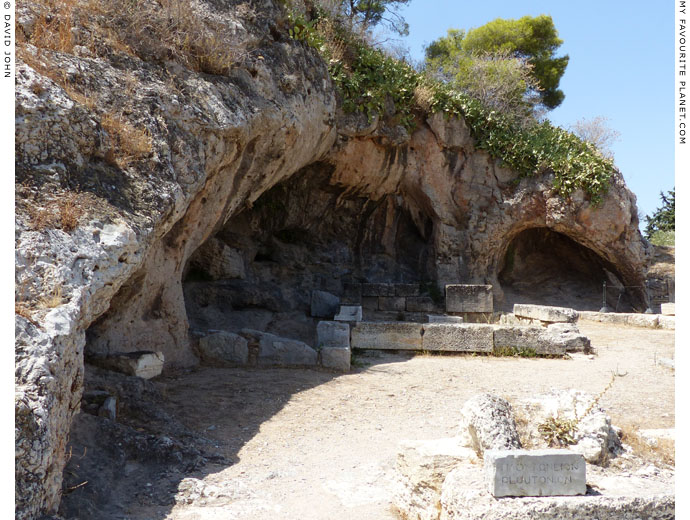
The "Ploutonion" (also known as "the sacred precinct of the
Mirthless Rock") in the Sanctuary at Eleusis (see Part 1),
at the foot of the northeast slope of the acropolis hill.
|
In front of the cave, which perhaps represented the gates of Hades, the small 4th century BC Temple of Plouton replaced the 6th century BC Peisistratid temple which may have been destroyed during the Persian invasion of 480-479 BC.
Although Plouton was a central figure in the myth of Demeter and Persephone, his role in the Mysteries themselves is considered to have been relatively minor.
The "Mirthless Rock" or "Mirthless stone" (Αγέλαστος Πέτρα, Agelastos Petra, literally smile-less stone or stone without laughter) is usually thought to be the stone on which Demeter sat to rest during her search for Persephone (see Part 1).
"We put the urn aboard ship
with this inscription:
This is the dust of little
Timas who unmarried was led
into Persephone's dark bedroom
And she being far from home, girls
her age took new-edged blades
to cut, in mourning for her,
these curls of their soft hair"
Sappho, 7th century BC.
In Homer's Odyssey (Books 10-11), Hades was the house of "mighty Hades and dread Persephone" in which the ghosts of dead mortals wandered aimlessly like shadows in the joyless, murky darkness. It lay beyond "deep-flowing Oceanus, that bounds the Earth". The divine sorceress Circe (Κίρκη) gave Odysseus directions to the Undeworld entrance.
"'Son of Laertes, sprung from Zeus, Odysseus of many devices, let there be in thy mind no concern for a pilot to guide thy ship, but set up thy mast, and spread the white sail, and sit thee down; and the breath of the North Wind will bear her onward. But when in thy ship thou hast now crossed the stream of Oceanus, where is a level shore and the groves of Persephone – tall poplars, and willows that shed their fruit – there do thou beach thy ship by the deep eddying Oceanus, but go thyself to the dank house of Hades. There into Acheron flow Periphlegethon and Cocytus, which is a branch of the water of the Styx; and there is a rock, and the meeting place of the two roaring rivers.'"
Homer, The Odyssey, Book 10, lines 504-515. At Perseus Digital Library. |
|
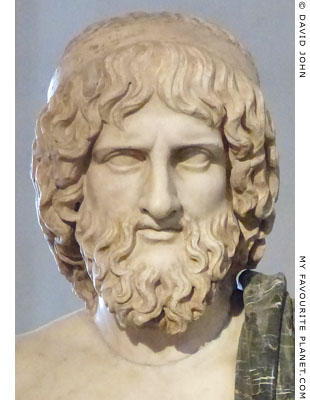
Marble head of Hades (Pluto).
Fine-grained marble. Roman period copy
of a 5th century BC Greek archetype.
Extensively restored during the Baroque
period, when the bust and black marble
mantle were added.
Palazzo Altemps, National Museum of Rome.
Inv. No. 8584. Ludovisi Collection. |
|
| |
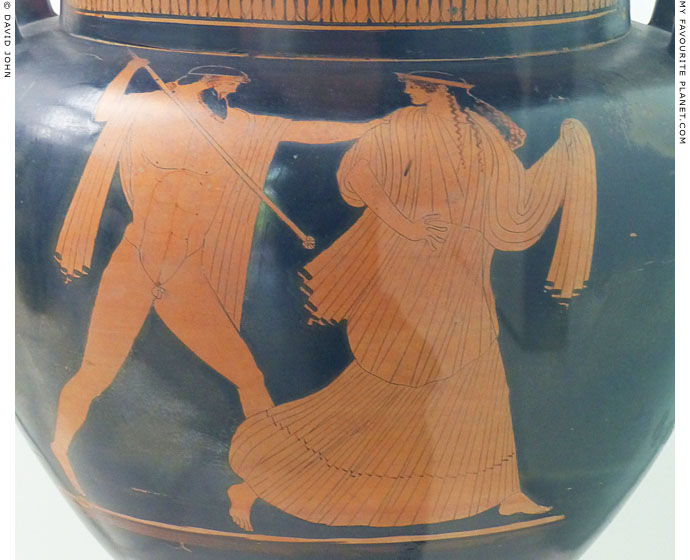
Detail of an Attic red-figure column krater with a god chasing a female,
possibly Plouton (Hades) and Persephone, or Zeus and a maiden.
The other side of the krater shows a female figure with a torch.
Attributed to the Boreas Painter. 470-460 BC. One of five Attic kraters
found in 1841 in the necropolis of Akragas (Agrigento), Sicily (see below).
Antonino Salinas Regional Archaeological Museum, Palermo. Inv. No. 2555 (V795).
Beazley Archive Database, Vase No. 206127 |
| |
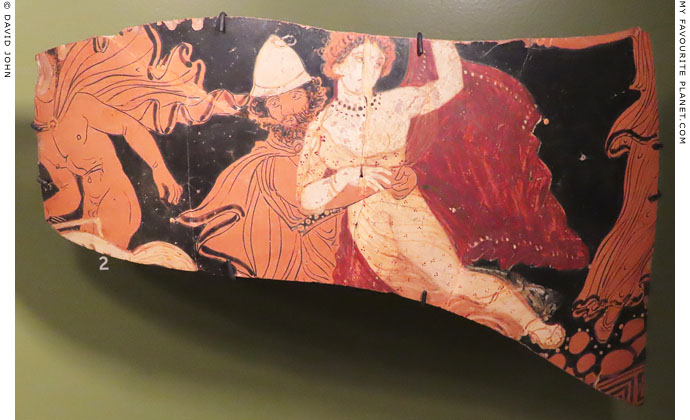
A sherd (fragment) of a red-figure ceramic vessel with a depiction
of Hades abducting Persephone. On the left is part of a nude male
figure in a chariot, presumably Eros. On the right is part of a female
figure, probably one of Persephone's companions.
Made and found in Taranto, 350-325 BC.
Allard Pierson Museum, Amsterdam. Inv. No. 2588. |
| |
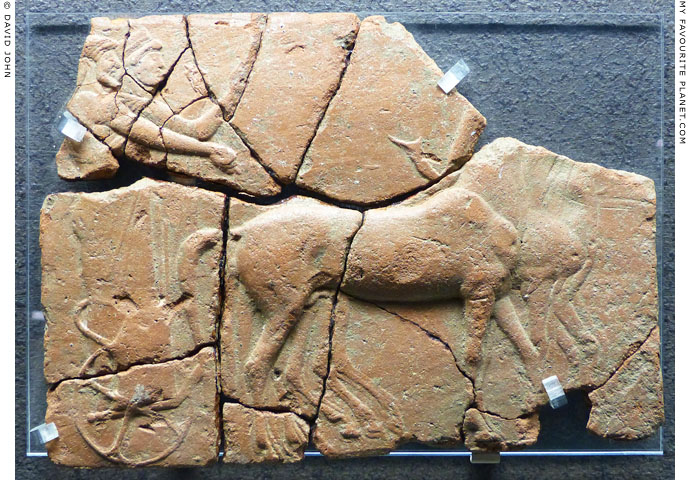
A fragmentary terracotta pinax (plaque) with a relief of a divine couple,
probably Persephone and Plouton (Hades), in a quadriga (four-horse chariot).
Around 490-470 BC. From Francavilla di Sicilia, Sicily.
Paolo Orsi Regional Archaeological Museum, Syracuse. Inv. No. 84839.
|
One of several fragmented mould-made pinakes depicting scenes from the myth of Persephone and Hades, dated to the first half of the 5th century BC, excavated from a votive deposit at Francavilla di Sicilia, in the valley of the Alcantara river, around 50 km south of Messina, northeast Sicily. The site was part of an unknown Greek settlement thought to have been associated with the nearby ancient colony of Naxos. The plaques have been compared to those discovered by Paulo Orsi and others at the sanctuary of Persephone of Manella at Locri Epizefiri, Reggio Calabria, southern Italy.
See another Francavilla di Sicilia pinax depicting Plouton and Persephone enthroned below. |
|
| |
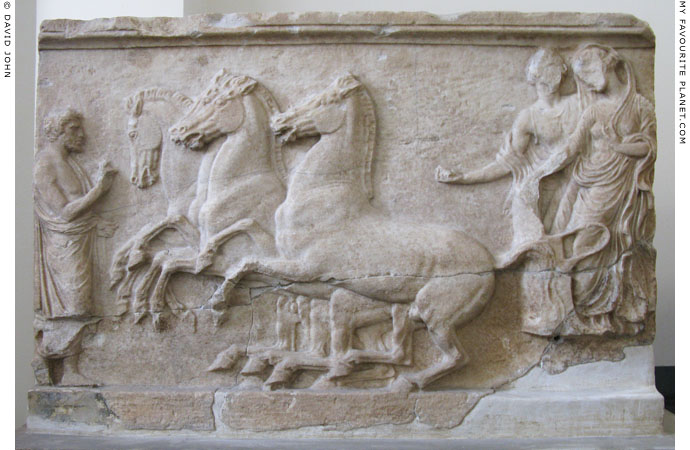
A marble votive stele from Rhodes with a relief depicting a male
and female in a quadriga (four-horse chariot). The scene is
thought to represent the mythological abduction of the female.
430-420 BC. From Afantou (ancient Brygindara), northeast Rhodes.
Height 51.5 cm, width 79 cm, depth 7 cm. Height of relief 43 cm.
Antikensammlung, Berlin State Museums (SMB). Inv. No. Sk 1545.
|
The theme of a god or mortal abducting a female was a recurring subject of Greek and Roman literature and art. The culprits include Hades, Zeus, the Dioskouroi, Pelops, Theseus and Paris. Abductors were often depicted using a chariot as a getaway vehicle, particularly in the case of Hades abducting Persephone (see photos below). The identity of the pair in this relief is unknown, but Echelos and Basile, and the local eponymous goddess or heroine Brygindis (Βρυγίνδις) of the Rhodian deme Brygindara, have been suggested. On the left stands the dedicator of the relief.
The larger upper fragment of the relief was purchased on the art market in early 1903. Shortly after Friedrich Freiherr Hiller von Gaertringen (1864-1947) went to the village Afantou (Αφάντου), on the northeast coast of Rhodes, the location of ancient Brygindara, and purchased the other three fragments from the owners. The stele had been used as a doorstep for many years.
The composition is similar to that of a relief found in 1893 at Neo Phaleron, Attica, depicting a couple on a quadriga, inscribed with the names of the hero Echelos and Basile or Iasile (see below). The style of both reliefs has been compared to that of the Parthenon frieze.
Reinhard Kekulé, who published the relief from Afantou in 1905, stated that the stele was made of Pentelic marble and the work of an artist from Attica, and that it depicted, like the Phaleron relief, Echelos and Basile. Later authors, including Carl Blümel (Die klassisch-griechischen Skulpturen der Staatlichen Museen zu Berlin, Berlin, 1966, pages 59-60), concluded that the marble was not from Attica and that the relief was more likely to have depicted Brygindis. However, only the name of this local goddess or heroine is known from short dedicatory inscriptions, and nothing is known of myths or legends concerning her, or whether she was abducted.
See: Reinhard Kekulé von Stradonitz (1839-1911), Echelos und Basile: attisches Relief aus Rhodos in den Königlichen Museen. 65. Winckelmannsprogramme der Archäologischen Gesellschaft zu Berlin. Georg Reimer, Berlin, 1905. At the Internet Archive. Includes plates of both reliefs and a contribution by Hiller von Gaertringen on ancient Brygindara. Confusingly, the first page has a plate of another relief with a similar subject, without a caption.
See also a vase painting of Plouton and Persephone in a quadriga below. |
|
| |
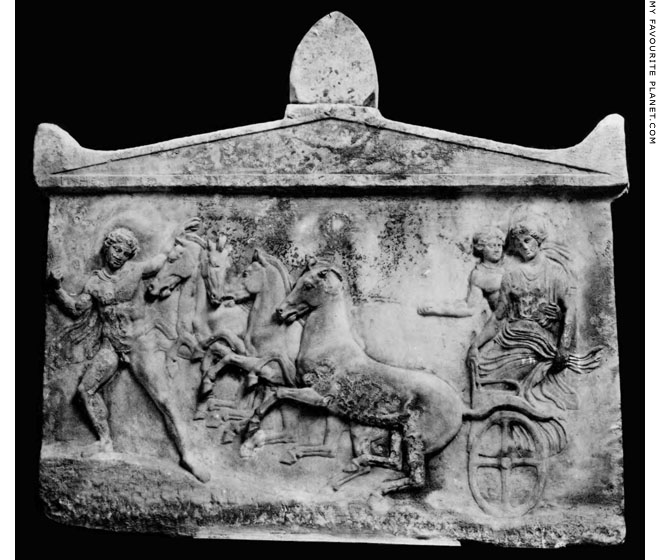
A relief on one side of an amphiglyphon (stele with reliefs on both sides) thought to show
Echelos (Ἐχέλος) abducting Basile (or Iasile) in a four-horse chariot, which is guided by
Hermes (left) who held a painted whip (now faded) in his right hand.
Around 410 BC. Excavated in June 1893 at Neo Phaleron, Attica, near the confluence of the
rivers Ilissos and Kephisos. Pentelic marble. Height 76 cm, width 88 cm, thickness 11 cm.
National Archaeological Museum, Athens, Inv. No. 1783.
|
The barely legible names of Hermes, Echelos and Basile or Iasile are inscribed on the epistyle on this side of the stele, and on the other side is a dedication to Hermes and the Nymphs. The tall poros (limestone) base on which the stele stood is inscribed with the name of the dedicator Kephisotodos (Κηφισόδοτος or Κεφισόδοτος), son of Demogenes, who also dedicated an altar.
Κηφισόδοτος Δεμογένος
Βουτάδες ἱδρυσατο
καὶ τόν βωμόν.
Kephisodotos son of Demogenes
of Boutadai founded [this]
and the altar.
Inscription IG I³ 986 A, IG II² 4546 l. 1-3.
The relief on the other side of the stele shows six figures, perhaps deities, standing in a row, apparently in discussion. Since the discovery of the stele there has been much debate over the significance of the reliefs and the figures represented, as well as the contents of the damaged and now incomplete inscriptions.
Echelos (Ἔχελος) was the eponymous hero of Echelidai (Ἐχελίδαι), a district in the Attic deme of Xypete (Ξυπέτη), northeast of Piraeus. He is known from a decree found on the north slope of Areopagos, Athens (inscription IG² 4545 48). He was honoured at a hieron near Piraeus, and a statue of him stood near the hippodrome in Phaleron. The identity of Basile or Iasile is unknown, although a number of theories have attempted to associate the name Basile with that of a Nymph or other deity, for example Basileia, sister of Rhea and daughter of Ouranos and Titaia (Ge). The name Basile (Queen, Mistress) was also an epiphet of Persephone.
Image source: J. N. Svoronos (Ioannis Nikolaou Svoronos, Iωάννης Ν. Σβορώνος, 1863-1922), Das Athener Nationalmuseum, German edition by W. Barth, Textband 1, No. 9, Inv. No. 1783, pages 120-136; and Tafelband 1, Tafel 28. Beck & Barth, Athens, 1908. At the Internet Archive.
See also: Nicholas E. Crosby, A basrelief from Phaleron. In: The American Journal of Archaeology and of the History of the Fine Arts, Volume 9, No. 2 (April-June 1894), pages 202-205 and plate XII. Archaeological Institute of America. At Jstor. Crosby associated the abduction of Basile/Iasile by Echelon with that of Persephone by Hades. |
|
| |
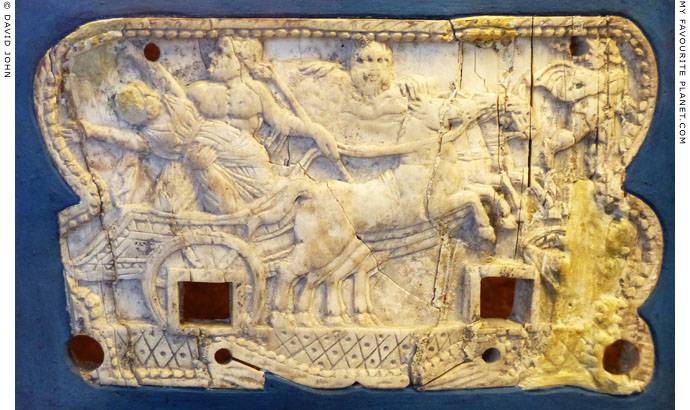
An ivory plaque with a carved relief of Plouton carrying off Persephone in a quadriga.
1st century BC - 1st century AD. Found on 27th June 1873 in a house
in Insula 2, Regio I, Pompeii, together with other ornaments and a
small wooden chest. Height 7.6 cm, height 12.2 cm.
Persephone raises both arms as if crying for help. Unfortunately, her face has
not survived. A bearded figure (Zeus or Poseidon?) appears in the background,
and Hermes flies in front of the chariot, leading the way to the Underworld.
Part of another figure can be seen in the bottom right corner.
National Archaeological Museum, Naples. Inv. No. 109905A.
|
Pausanias related a local belief that Plouton descended to the Underworld with Persephone near Lerna in Argolis, northeast Peloponnese:
"On returning to the straight road, you will cross the Erasinus and reach the river Cheimarrus [Winter-torrent]. Near it is a circuit of stones, and they say that Pluto, after carrying off, according to the story, Kore, the daughter of Demeter, descended here to his fabled kingdom underground. Lerna is, I have already stated, by the sea, and here they celebrate mysteries in honour of Lernaean Demeter."
Pausanias, Description of Greece, Book 2, chapter 36, section 7. At Perseus Digital Library.
In the version of the myth summarized by the Roman mythographer Hyginus (see the note in Homer part 2), Persephone's father was Zeus, and it was he who suggested to his brother Plouton that he should abduct the Maid. The Underworld god then took his niece off in his four-horse chariot while she was on Mount Aetna in Sicily, gathering flowers with Aphrodite, Artemis and Athena.
"Pluto asked from Jove [Zeus] that he give him in marriage Ceres’ daughter and his own. Jove said that Ceres would not permit her daughter to live in gloomy Tartarus, but bade him seize her as she was gathering flowers on Mount Etna, which is in Sicily. While Proserpina [Persephone] was gathering flowers with Venus [Aphrodite], Diana [Artemis] and Minerva [Athena], Pluto came in his four-horse chariot, and seized her. Afterwards Ceres obtained from Jove permission for her to stay half of the year with her, and half with Pluto."
Hyginus, Fabulae, sections 100-149, 146, Proserpina. At the Theoi Project.
See a sarcophagus relief and a Roman fresco depicting Pluto abducting Proserpina below. |
|
| |
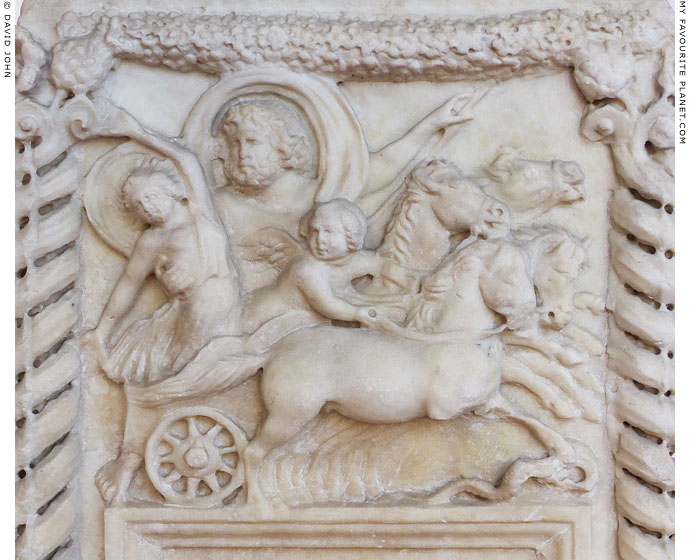
A Roman marble relief depicting the abduction of Proserpina (Persephone)
by Pluto (Plouton) on a cinerary altar with a tabula without an inscription.
Eros drives the charging horses of the quadriga (four-horse chariot).
2nd century AD.
Baths of Diocletian, National Museum of Rome.
Inv. No. 65197. Formerly in the Kircherian Museum. |
| |
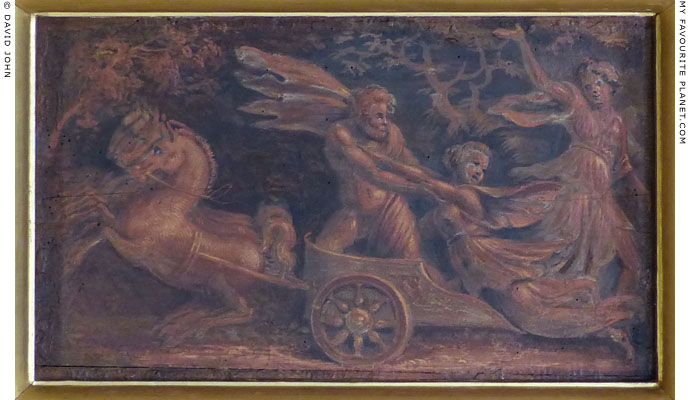
Fresco panel of the abduction of Persephone by Hades on the ceiling of the Room of
the Marriage of Alexander the Great and Roxane, Villa Farnesina, Trastevere, Rome.
|
| The villa and this ceiling were designed by the Sienese architect and painter Baldassare Peruzzi (1481-1536) and built 1506-1511 for the Sienese merchant, banker and mine owner Agostino Chigi (1466-1520). The small ceiling panels depicting mythological scenes were painted by artists from Peruzzi's workshop. The walls of the room, which was Chigi's bedroom, were decorated with frescoes depicting episodes from the life of Alexander the Great, including The Wedding of Alexander and Roxana by Sodoma. |
|
| |
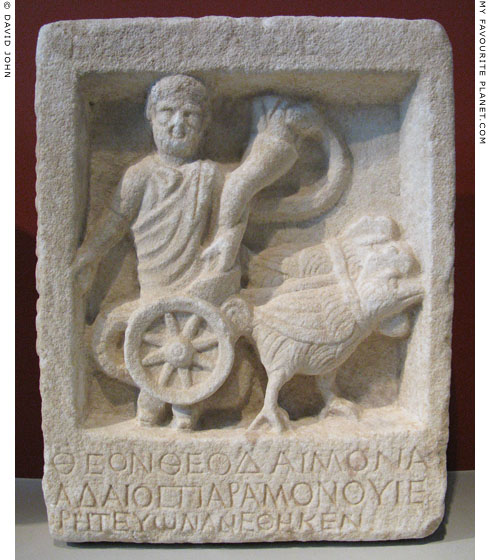
An inscribed limestone votive plaque dedicated to Hades by the priest
Hadaios (ᾍδαίος). The relief depicts Hades (Pluto), holding a cornucopia
in his left hand, standing behind a chariot drawn by two cockerels. A
snake, rising behind him, appears to be feeding from the cornucopia.
Roman period, 2nd century AD. Height 37 cm. Found in 1937 during construction
work on the Derveni-Langada road (a stretch of the EO2 National Road between
Thessaloniki and Kavala, see How to get to Kavala), in the area of the ancient
Mygdonian city Lete (Λητή), near Thessaloniki, Macedonia, Greece. Perhaps from
the Sanctuary of Demeter and Persephone at Lete, where several other ancient
sculptures have been discovered (see above).
Thessaloniki Archaeological Museum. Inv. No. MΘ 1525.
|
On the frame above the relief is a very worn inscription in Greek:
Έτους ΔΞΣ
The year 264 (ΔΞΣ in Greek numerals), corresponding to 116 AD, according to the dating system beginning on the first day of the month of Dios (October) 148 BC, introduced following the Roman defeat of the rebellion of Andriskos (Ἀνδρίσκος, also known as the Pseudo-Philip, pretender to the Macedonian throne, arguably the last Macedonian king) at the Second Battle of Pydna and the establishment of the Roman province of Macedonia.
The inscription on the frame below the relief is better preserved, and states that the work was dedicated to Theodaemon by Hadaios, son of Paramonos, who served as his priest.
Θεόν Θεοδαίμονα
ᾍδαίος Παραμόνου ιε-
ρητεύων ανέθηκεν
It has been suggested that the two small objects beneath the chariot wheel may be the heads of snakes which have replaced the god's feet. It has also been suggested that the rare noun theodaemon, literally demon god, is not a name but a designation as a chthonic (underworld) deity, and that it refers to an unknown local fertility god rather than Hades. |
|
| |
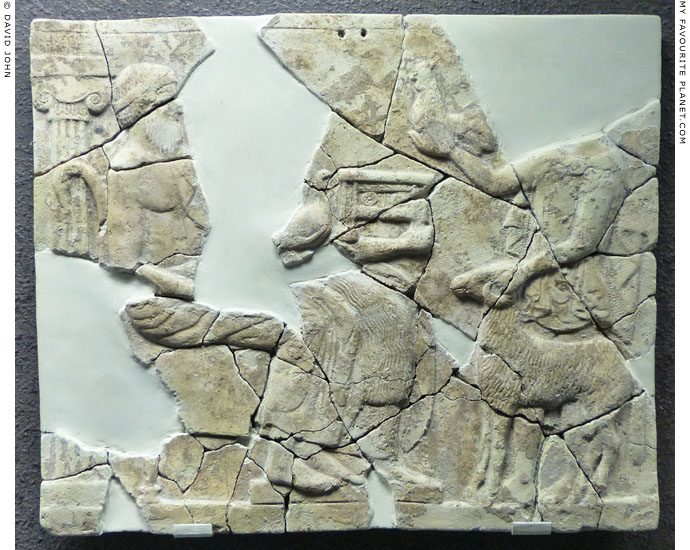
A fragmentary terracotta pinax (plaque) with a relief of Plouton (Hades) and Persephone
enthroned, facing right. They are approached from the right by a male figure believed to
be Hermes Kriophoros (Ram Bearer), holding a ram by one of its horns with his left
hand, and offering them a cockerel he carries in the palm of his raised right hand.
Around 470-460 BC. From Francavilla di Sicilia, Sicily (see above).
Paolo Orsi Regional Archaeological Museum, Syracuse. Inv. No. 85638. |
| |
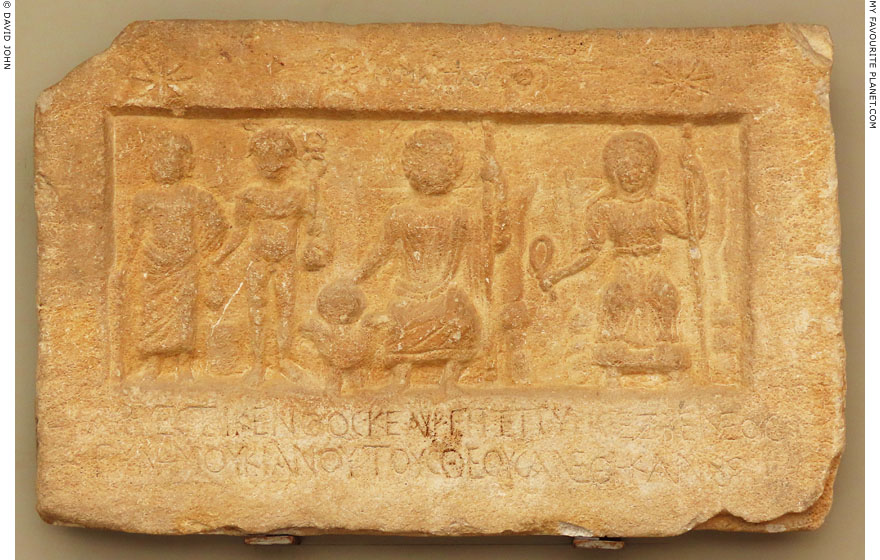
An inscribed marble votive relief, addressed to "Lord Plouton", with a
shallow relief depicting Hades and Persephone enthroned as rulers
of the Underworld, each holding a sceptre in the left hand. On the left,
in front of an altar, stand the healing god Asklepios, holding a staff
in his right hand, and Hermes Kerdoos (Κερδώος, profit-bringing) with
a kerykeion (caduceus) in his left hand and a purse in the right.
3rd century AD. Found around 1889 in the area of Nevrokopi (Νευροκόπι),
in the Rhodope Mountains. north of Drama, East Macedonia, Greece.
Height 53 cm, width 84 cm, depth 6.5 - 9 cm.
Drama Archaeological Museum. Inv. No. Λ 27.
|
This representation of Hades and Persephone resembles depictions of the Egyptian deities Serapis and Isis. Hades' face is no longer visible, but it is clear that his head is surrounded by a nimbus (halo). The faces of Asklepios and Hermes The faces of Asklepios and Hermes have also been worn away by time.
Along the top of the frame is inscribed the salutation "To Lord Plouton" in Greek. Immediately to the left of this address is a small bust of the Sun (Helios / Sol), and to the right a bust of the Moon (Selene / Luna). Two larger eight-pointed stars, one at each side, symbolize the Dioskouri, the heavenly twins.
The dedication in Greek at the lower part of the frame states that Aurelius Mestikenthos and Aurelia Gepepyris, daughter of Ezbenes and wife of Moukianos, dedicated these gods.
κυρίῳ Πλούτωνι
Αὐρ(ήλιος) Μεστικενθος κὲ Αὐρ(ηλία) Γηπεπυρις Εζβενεος
γυνὴ Μουκιανοῦ τοὺς θεοὺς ἀνέθηκαν.
Inscription IGBulg IV 2343.
The names of the dedicants are Thracian rather than Greek or Roman. The name Gepepyris (Γηπεπυρις) has also been read as Eptepyris (Επτεπυρις). IGBulg V 1997, 5927 = 2343.
The dedicants have chosen to appeal to the gods responsible for health (Asklepios), wealth (Hermes Kerdoos and Plouton) and life after death (Plouton/Hades and Persephone).
In classical antiquity Aegean Thrace was a busy place, with many settlements founded by the Thracians themselves, Greeks, including Macedonians, and then Romans. The area profited from being on major trade routes between the Mediterranean and Black seas, Europe, the Balkans, Greece and Asia. From Medieval times, as centres of power and wealth moved elsewhere, many of these settlements were abandoned and the population declined. Following conquest by the Ottoman Turks in the late 14th century, the cultural mix included, Turks, Bulgarians, Greeks, Vlachs, Pomaks and Jews.
During the 19th and early 20th centuries Macedonia and Thrace were still under Ottoman control, and archaeological activity was not as intensive as in independent areas such as central and southern Greece. Even today, many historical sites have not been thoroughly investigated. After the Balkan Wars (1912-1913) and First World War (1914-1918), the regions were divided among Turkey and the newly independent Balkan states. For example, the area in the Rhodope Mountains to the north of Drama was divided between Greece and Bulgaria. The ensuing geographic and political divisions also caused barriers to social, economical and scientific cooperation and development here. The early 21st century has seen considerable improvement in the situation. (For more detailed articles about the history of Macedonia and Thrace, see the History of Macedonia page.)
The recent history of this particular relief may provide a good example of the progress made in the field of archaeology over the last 130 or so years. It was apparently unearthed around 1889, or some time before, somewhere in the area of Nevrokopi (Greek, Νευροκόπι; Bulgarian Неврокоп, Nevrokop), in the Rhodope Mountains, north of Drama. The questions of exactly where, when and by whom it was found remain unanswered. At the time the area was still part of Turkey in Europe, but was violently contested by Greeks and Bulgarians laying claims to the land. Today it is divided between Greece in the south and Bulgaria in the north. The municipality of Kato Nevrokopi (Κάτω Νευροκόπι, Lower Nevrokopi; formerly Zyrnovo, Зърново), 47 km north of Drama, is in Greece, while 30 km further north, Ano Nevrokopi (Άνω Νευροκόπι, Upper Nevrokopi) is in Bulgaria, where it is known as Gotse Delchev (Гоце Делчев).
In antiquity the main settlement in the area was Nicopolis ad Nestum (also referred to as Nicopolis ad Mestum; Ancient Greek, Νικόπολις ἡ περὶ Νέστον, City of Victory near the Nestos River), a very ancient place refounded and renamed to commemorate the victory of the Roman emperor Trajan over the Dacians in 105-106 AD. The city was destroyed by the Slavs in the late 6th century AD, and its remains are located on Bulgarian side of the border, near the village of Garmen (Bulgarian, Гърмен).
In 1889, perhaps due to the political unrest in the area at the time, the relief was taken from Nevrokopi to the house of Mr K. Kapetis, the English vice-consul at Serres. There it was drawn by Petros Papageorgiou (Πετρος Παπαγεωργίου), who published the inscription in the Athenian newspaper Estia Ikonographimeni (Ἑστία Εικονογραφημένη) on 7th March 1893. A drawing by S. S. de Fonseca was published with an article about Nicopolis ad Nestum by Paul Perdrizet in 1906. At some point after it was put into storage at Serres, suffering the fate of a huge number of archaeological finds which disappear into depots and are forgotten for several decades. For around 130 years, scholars in Bulgaria, unaware that the relief had been taken to Serres, supposed it had been lost, perhaps forever. The Bulgarian professor Georgi Michailov published the inscription (IGBulg IV 2343) and a decription of the relief in Volume IV of his Inscriptiones Grecae in Bulgaria Repertae (5 volumes, 1958-1970) without having seen it - like generations of scholars before and after him - or knowing whether it still existed. He believed that the enthroned deites were Jupiter and Juno (the Roman equivalents of the Greek Zeus and Hera).
This short entry in Professor Michailov's epigraphical work was the perhaps the first step in the relief's reemergence from obscurity. 12th December 1999 saw the inauguration of the Archaeological Museum of Drama, which was built by the municipality. Ancient artifacts were brought there from other museums and storage depots to form the new exhibition. In 2012, during one of her visits to the museum, the Bulgarian archaeologist Svetla Petrova (National Archaeological Institute with Museum, Sofia, Bulgaria) recognized the relief, thus - in a very real sense - rediscovering a lost work of art.
During my own recent visit to the museum, 12 years later, I was also attracted to this unusual artwork and wished to know more about it and other objects I saw there. Unfortunately, there is no guidebook to the museum, or even a website with details of the exhibits, and the other "usual sources" of archaeological information were of little help. I was therefore very happy to find Svetla Petrova's article on the relief, which I heartily recommend.
See: Svetla Petrova (National Archaeological Institute with Museum, Sofia, Bulgaria), The votive relief to Pluto from Nicopolis ad Nestum. In: Studia Antiqua et Archaeologica , No. 25 (1), August 2019, pages 95-112. In English, illustrated, with bibliography. At academia.edu, where you can find several other articles by Svetla Petrova.
The article is also available at: the-votive-relief-to-pluto-from-nicopolis-ad-nestum, on the website of the open access journal Studia Antiqua Archaeologica, published online and in print by the Alexandru Ioan Cuza University of Iași (UAIC), Romania. |
|
| |
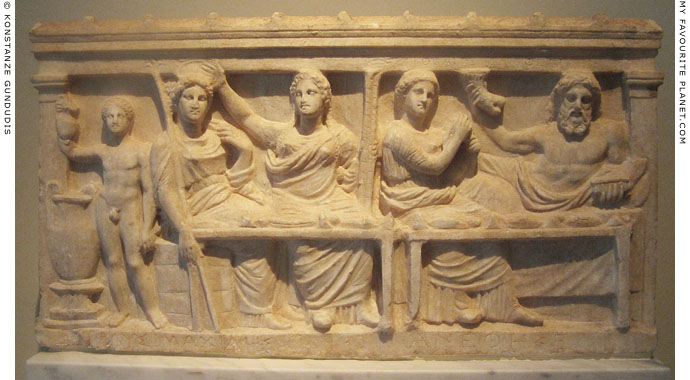
The "Lysimachides relief", a marble votive relief depicting
the principal deities of Eleusis in a banqueting scene.
Made in an Attic workshop around 335-320 BC. Found in 1885
by the Greek archaeologist Demetrios Philios in the Ploutonion
(see above) in the Sanctuary of Demeter and Persephone
at Eleusis. Pentelic marble. Height 38 cm, width 71.5 cm.
National Archaeological Museum, Athens. Inv. No. 1519. Inscription IG II 2 4683.
Photo: © Konstanze Gundudis
|
Two divine couples sit at low tables laden with food offerings in a naiskos (ναΐσκος, small temple). On the left a naked boy as a wine pourer (oinochoos), shown at a smaller scale than the divine figures, stands next to a large krater and holds an oinochoe (wine jug) in his right hand.
On the right a bearded male, wearing only a himation (cloak) over his lower torso, reclines on a kline (couch), resting on his left elbow. In his left hand he holds a dish or container, and in his raised right hand he has a rhyton (drinking horn) or cornucopia. Left of him sits a female figure holding an object with both hands. On the architrave above their heads is inscribed θεᾶι (Theai, the Goddess) and θεῶι (Theoi, the God), identifying them as Persephone (Kore) and Plouton (Hades) dining in the Underworld.
At the left hand table sit two female figures. The figure on the left sits on a large basket or box, probably the sacred kiste (cista mystica), which contained the hidden sacred objects of the Eleusinian Mysteries. With her right hand she holds a sceptre, the top of which rests on her right shoulder, and with her left hand she holds part of the garment on her left shoulder. The figure on the right holds a long torch in her left hand, and with her raised right hand she places a diadem on the head of her companion.
Unfortunately, the two female figures are not identified by inscriptions, but are generally thought to be Demeter (left) and Persephone in a different "incarnation", either before her abduction by Plouton, or during her annual return to the world above the earth. However, there are differences in the hairstyle, face and clothing of the "Persephone" figures at each table, and the female sitting with Demeter may be another goddess, perhaps Hekate.
The relief probably stood on top of a pillar. On the base, beneath the figures, is inscribed Λυσιμαχίδης ἀνέθηκε (Lysimachides anetheke, Lysimachides dedicated it). A Lysimachides, son of Philinos from Piraeus, was archon at Athens 339-338 BC. A man with this name, Lysimachides, son of Lysimachos, of the deme of Acharnai, dedicated a votive relief to Asklepios in the late 4th century BC (see the Asklepios page). A Lysimachides of Acharnai is also known from his inscribed tomb, around 320 BC, in the Street of the Tombs, Kerameikos, Athens, which was topped with a sculpture of a Molossian hound. Kerameikos Archaeological Museum. Inv. No. P 670 (see the photo at The Cheshire Cat Blog). |
|
| |
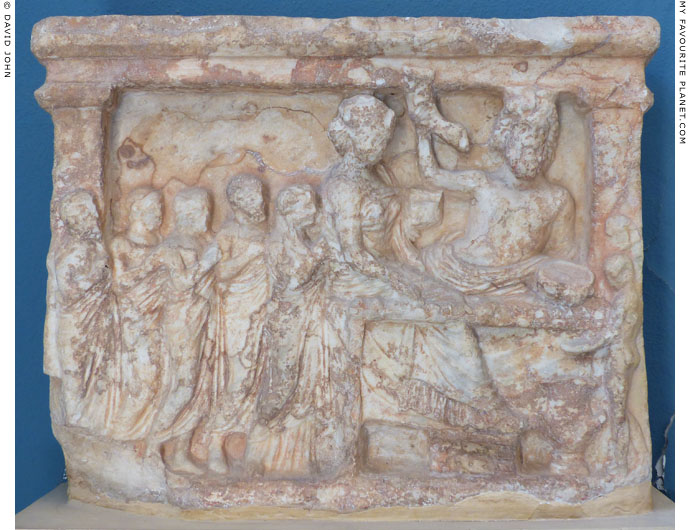
Marble votive relief depicting Hades (Plouton), Persephone and suppliants.
From the Sanctuary of Demeter and Persephone at Eleusis, Greece. 4th century BC.
Eleusis Archaeological Museum. Inv. No. 5122.
|
A bearded man with long hair, wearing a polos and a himation around the lower part of his body, reclines on a kline (couch), resting on his left elbow. In his raised right hand he holds a rhyton (drinking horn), and in his left a phiale (libation bowl). A woman sits to the left of him at the foot of the kline, facing him and holding a small container (perhaps a box or basket of sweets) in her left hand. One of her feet can be seen resting on a wide footrest. A table laden with food offerings stands before the couch. They are approached from the left by five worshippers, a woman and four men, shown at a smaller scale. On the extreme right a small naked boy as a wine pourer (oinochoos) stands next to a large krater. The scene is framed by two pillars supporting a roof, an architectural setting usually referred to as a naiskos (small temple).
Although the main figures in this relief and the one immediately below have been identified as Hades (Plouton) and Persephone in the context of the Eleusis sanctuary, several other similar reliefs discovered elsewhere (e.g. the reliefs from Corinth below) have been interpreted as representing a deceased hero in a nekrodeipno scene (νεκρόδειπνο, funerary banquet or symposium in honour of a deceased person; named Totenmahlreliefs by German archaeologists). [12] A similar 4th century BC relief in the Museo Gregoriano Profano, Vatican Museums, Inv. No. 1348, is also described as depicting Hades, Persephone and worshippers. See: arachne.uni-koeln.de/item/objekt/22114.
The scene of Persephone and Hades on a kline is also known from the tondo of an Attic red-figured kylix, circa 440-430 BC, said to be from Vulci, Etruria (Lazio, Italy). Now in the British Museum, Inv. No. GR 1847.9-9.6 (Vase E82).
The 17th century English traveller George Wheler recorded three such reliefs in Athens, which he called "basso-relievos, depicting Isis and Serapis sitting on a couch" (see below).
See also a similar relief in Lavrion, thought to depict Asklepios and Hygeia, on the Asklepios page.
See more about hero reliefs on Pergamon gallery 2, page 10. For other votive reliefs with gods, see Hermes and Pan. |
|
| |
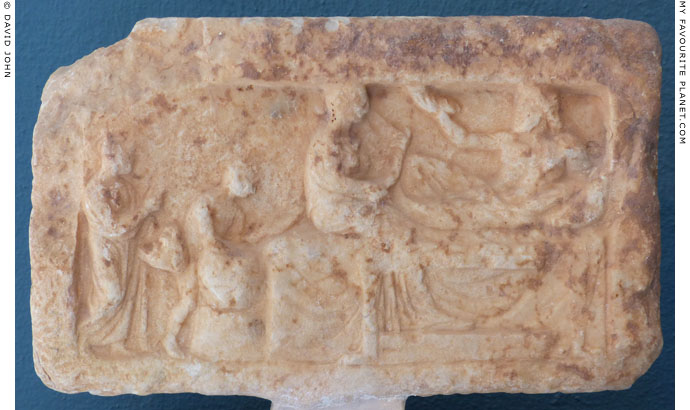
Marble votive relief depicting Plouton (Hades), Persephone,
a suppliant with a theatre mask, and a wine pourer (oinochoos).
Early 4th century BC. Discovered in Eleusis by
Demetrios Philios. Height 17 cm, width 30 cm.
Eleusis Archaeological Museum. Inv. No. 5172. |
| |
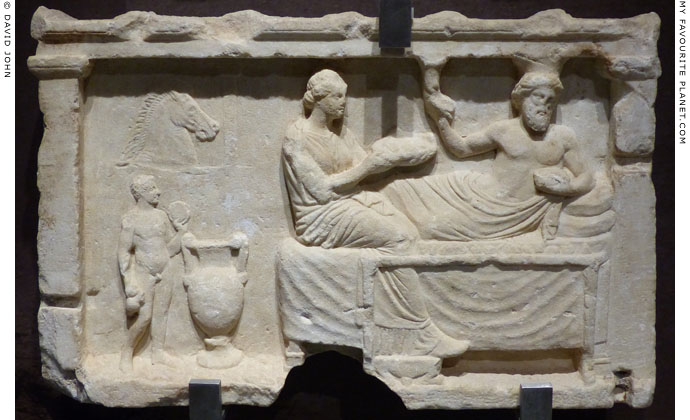
Persephone and Plouton?
A marble votive relief from Corinth, described by the museum as a hero relief. 4th century BC.
The profile horse's head in lower relief on the left side of the scene is a typical feature of
hero reliefs (see, for example, two funerary reliefs from Derveni), although the usual
snake is missing here and on the other reliefs above. On the left, a naked young man,
standing beside a large krater, holds a disk (a tambourine?) and an oinochoe (wine jug).
Corinth Archaeological Museum. Inv. No. S 2632.
See also the sanctuary of Demeter and Kore at Corinth in Part 1.
A similar relief from Athens, dated to around 350 BC, shows the oinochoos with krater
and the couple on a kline, but without horse's head or snakes. A dog sleeps beneath
the low table in front of the kline. National Archaeological Museum, Athens. Inv. No. 3872. |
| |
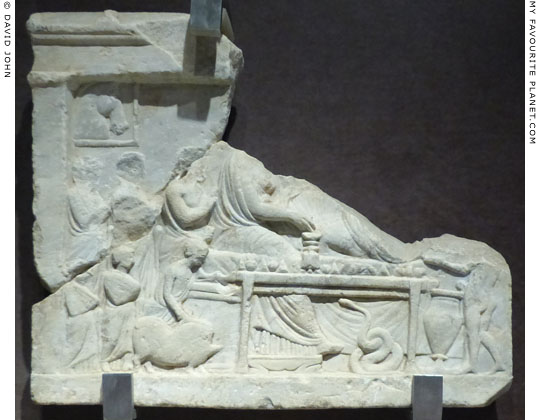
Another "hero relief" from Corinth.
Corinth Archaeological Museum.
|
The scene in this fragmented relief is slightly different to that in the other reliefs above, and more typical of banqueting reliefs. Both the horse and the snake (thought to represent the soul of the deceased hero) are present, as well as a family offering a pig, and a naked boy as a wine pourer (oinochoos) with a large krater. A reconstruction drawing of the scene made in the 1930s conjectured that the missing top right corner showed the male "hero" figure wearing a polos and holding a rhyton and phiale. [13]
See also reliefs of Demeter, Persephone and Zeus Chthonios from Corinth below. |
|
| |
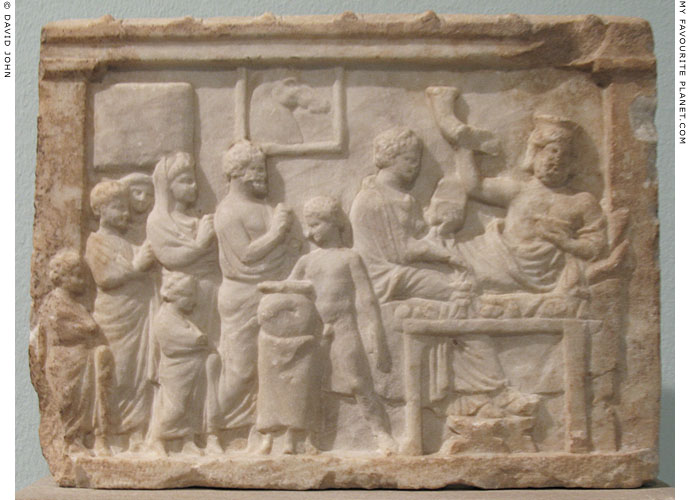
Yet another relief with a banqueting "hero", this one from Thebes, Boeotia. 350-300 BC.
Antikensammlung, Berlin State Museums (SMB).
Inv. No. Sk 825. Acquired in 1884. |
| |
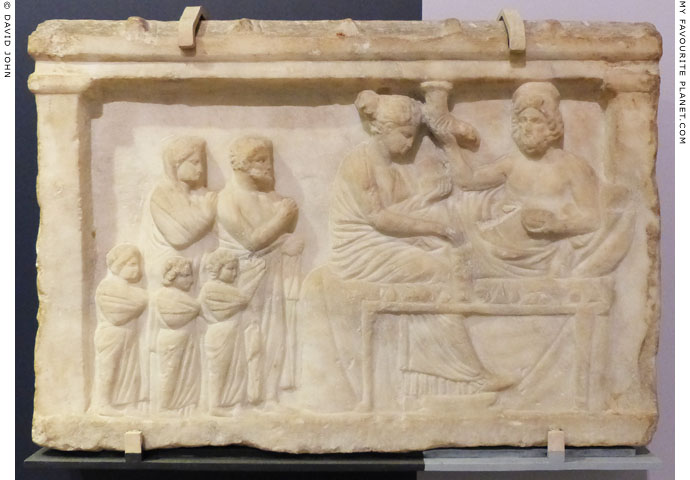
A marble votive relief described by the museum labelling as "A banqueting
hero reclining on a couch and raising a drinking horn is approached by a
family of worshippers. 400-201 BC." Height 26 cm, width 36 cm.
Ashmolean Museum, Oxford. Inv. No. ANMichaelis. 145.
One of three similar reliefs donated to Oxford University at
the end of the 17th century by George Wheler (see below). |
| |
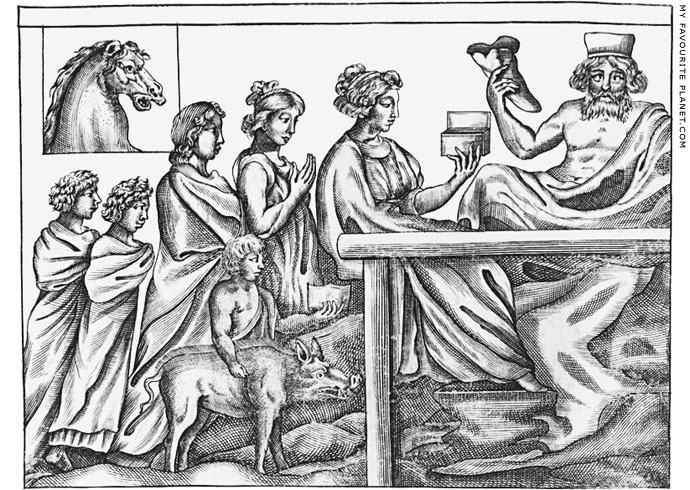
One of the three similar reliefs collected in Greece by the 17th century English
traveller George Wheler, who believed they depicted Isis and Serapis.
4th - 3rd century BC. Grey marble. Height 18 cm, width 27 cm.
Ashmolean Museum, Oxford. Inv. No. ANMichaelis. 144.
|
Jacob Spon and George Wheler travelled together through Italy, Turkey and Greece in 1675-1676. At the end of his account of their visit to Athens in 1676 (A journey into Greece, Book V), Wheler mentioned his collection of "marbles", including reliefs and inscriptions, many of which had originally been discovered and collected by Jean Giraud, the British Consul in Athens. He gave most of the inscriptions to the University of Oxford soon after his return to England, and they were added to the collection known as the Marmora Arundeliana & Seldeniana (based on the former collections of Lord Arundel and John Selden), now in the Ashmolean Museum. Other pieces he at first kept himself, but later, probably in 1683, he also donated many of them, including the three reliefs, to the Oxford museum.
Wheler did not mention where the reliefs were found, but since he discusses them in his account of Athens, they presumably came from in or near the city. He believed the male figure wearing a polos was Serapis because of other representations of the god he had seen elsewhere. For him it was then reasonable to assume that the female figure was Isis. He and Spon also believed that a caryatid they saw at Eleusis (see part 1) and reliefs now known to depict Kybele were depictions of Demeter.
He described the similarities and differences between the three reliefs, and suggested that they were ex-votoes, offerings made in fulfillment of promises made to deities in thanks for the granting of requests and the answering of prayers.
"I have three basso-relievo's, representing Isis and Serapis sitting on a couch. Isis is clothed with a long vest, girded together below her paps, and a loose mantle about her shoulders; She reacheth her right hand down, as receiving something; and in her left she holds a square box with the lid open.
Serapis sits half naked, holding a cornucopia in his right hand, and a plate in his left, with his head covered with a kind of cap sitting much higher than his head. Before them stands a table to receive the offerings, on which are things of divers figures, round, three square, and half round.
Upon one of the basso-relievoes there is a bag, which seems to be a bag of money; whereof Isis takes out to put in her box. On the right hand of two of them, are a man, and a woman, and children; I suppose, coming to worship, or to sacrifice. For on this I give the figure, there is a little boy with a present in his hand, and a beast by him, I take to be a hog; but it is somewhat defaced.
On this also is a Horses head, as hung up in a corner of the room; but not on the rest. Isis, and Serapis are represented in all three much alike: Only in one of them, Isis holds no box; but collects her money in her lap: But in the other figures they all differ. This seems to be a man, and his wife, and three children; being two sons, and a daughter. The second hath a man, and his wife, and three sons. The third, a man, and one son. Whence I judge them to be memorials of the payments of vows, made to those idols in times of sickness or distress: Such as the Roman Church usually now make, and pay to the saints, and hang up in their churches."
George Wheler, A journey into Greece in company of Dr Spon of Lyons, Book V, pages 405-408, illustration on page 406. William Cademan, Robert Kettlewell, and Awnsham Churchill, London, 1682. At Googlebooks.
Only one of the reliefs (see photo above) is usually on display in the Ashmolean Museum, probably because it is the best preserved. The third is Inv. No. ANMichaelis. 146. 4th - 3rd century BC. Height 28 cm, width 41 cm. There is no horse's head, and the male deity/hero does not wear a polos. His female companion holds a fillet rather than a box. On the left stands a bearded worshipper in a cloak, and on the right is a naked wine-pourer.
The invoice numbers are based on the numbering in Ancient marbles in Great Britain by Adolf Michaelis (1835-1910), which provides detailed descriptions of many ancient artefacts at that time in various British collections and museums. Michaelis believed that Nos. 145 and 146 were made of Pentelic marble, although so far I have found no recent confirmation of this.
Adolf Michaelis, Ancient marbles in Great Britain, numbers 144, 145 and 146, pages 576-577. Translated from German by Charles Augustus Maude Fennell. Cambridge University Press, 1882. At the Internet Archive. |
|
|
| |
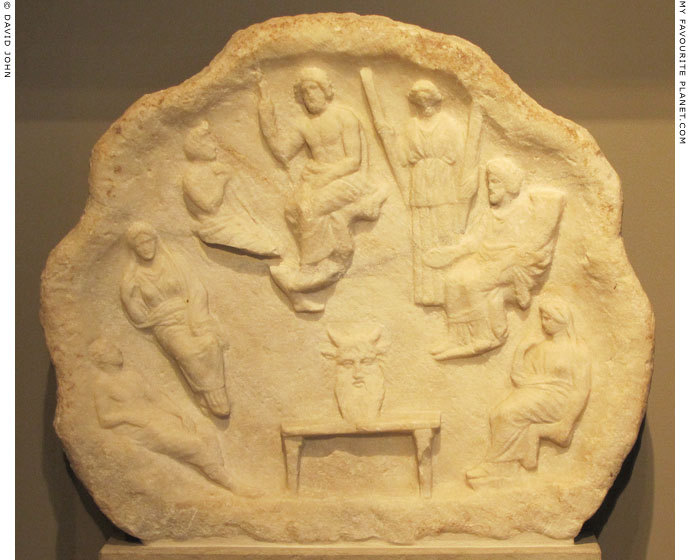
Marble votive relief with Zeus and a gathering of the gods in a grotto sanctuary.
From Megara, Greece, 380-370 BC. Height 50 cm, width 50 cm, depth 10.5 cm.
Altes Museum, Berlin. Inv. No. Sk 679.
Acquired in 1884 from the Sabouroff Collection.
|
| Seven deities are arranged in a semi-circle around a mask of the river god Acheloos on an altar. Most have not been definitely identified because of the lack of attributes, and one or more may be local deities. The supreme Olympian god Zeus sits in the centre, above the others. Left of him is Pan with his horns and lagobolon (hunting stick), then perhaps Persephone (Kore) and Hermes on the far left. To the right stands Persephone or Hekate holding two torches, then Hades (Plouton) with a phiale (libation bowl) and cornucopia, and perhaps Demeter. |
|
| |
| |
Triptolemos and other Eleusinian deities |
 |
|
| |
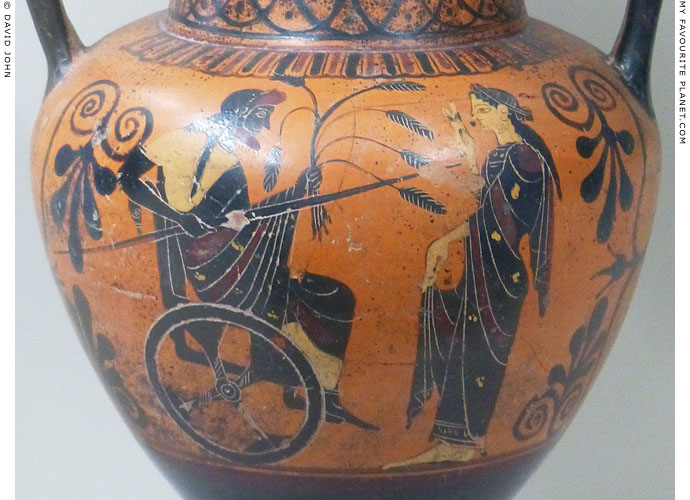
Detail of a small Attic black-figure amphora showing
the "apostole", the mission of Triptolemos.
By a painter of the Leagros Group. Excavated from
Tomb L, Osteria necropolis, Rome. 530-510 BC.
Demeter bids farewell to a bearded Triptolemos, seated in his chariot with a sceptre and
a sheaf of corn, who is about to set off on his mission to teach humans the art of cultivation.
The subject was popular with Greek vase painters from the mid 6th to the late 4th century BC.
National Etruscan Museum, Villa Giulia, Rome. |
| |
The Roman mythographer Hyginus summarized one or more versions of the myths concerning Demeter and Triptolemos:
"When Ceres was hunting for her daughter, she came to King Eleusinus, whose wife Cothonea had borne the boy Triptolemus, and pretended she was a wet nurse. The queen gladly took her as nurse for her son. Since Ceres wanted to make her charge immortal, she fed him by day with divine milk, but by night secretly hid him in the fire.
In this way he grew more than mortals are wont to grow, and so, when the parents wondered at it, they watched her. When Ceres was about to put him in the fire, the father was terrified. In her anger, she struck down Eleusinus, but on Triptolemus, her foster-son, she conferred everlasting honour, for she gave him her chariot yoked with Serpents to spread the cultivation of grain. Riding in it he sowed grain throughout the earth.
When he returned, Celeus bade him be killed for his benefactions, but when this was known, by Ceres' order he gave the kingdom to Triptolemus, who called it Eleusis from his father's name. He also established sacred rites in honour of Ceres, which are called in Greek Thesmophoria."
Hyginus, Fabulae, sections 100-149, section 147, Triptolemus. At the Theoi Project.
Hyginus mentioned another tale from the Triptolemos myths when discussing the various mythological explanations for the origins of stellar constellation Ophiuchus:
"Ophiuchus, who, by our writers, is called the Serpent-holder, is stationed above Scorpio, and holds in his hands a serpent which coils about his body.
Many have called him Carnabon, king of the Getae, who lived in Thrace. He came into power at the time when it is thought grain was first given to mortals. For when Ceres was distributing her bounties to men, she bade Triptolemus, whose nurse she had been, go around to all the nations and distribute grain, so that they and their descendants might more easily rise above primitive ways of living. He went in a dragon car, and is said to have been the first to use one wheel, so as not to be delayed in his journey.
When he came to the king of the Getae, whom we mentioned above, he was at first hospitably received. Later, not as a beneficent and innocent visitor, but as a most cruel foe, he was seized by treachery, and he who was ready to prolong the lives of others, almost lost his own life. For at the order of Carnabon one dragon was killed, so that Triptolemus might not hope his dragon car could save him when he realized an ambush was being prepared.
But Ceres is said to have come there, and restored the stolen chariot to the youth, substituting another dragon, and punishing the king with no slight punishment for his malevolent attempt. For Hegesianax says that Ceres, for men’s remembrance, pictures Carnabon among the stars, holding a dragon in his hands as if to kill it. He lived so painfully that he brought on himself a most welcome death.
Others point out that he is Hercules, killing in Lydia near the river Sagaris a snake which kept destroying many men and stripping the river banks of grain. In return for this deed, Omphale, the queen of that region, sent him back to Argos loaded with gifts, and because of his bravery he was placed by Jove among the constellations.
Some, too, have said that he is Triopas, king of the Thessalians, who, in trying to roof his own house, tore down the temple of Ceres, built by the men of old. When hunger was brought on him by Ceres for this deed, he could never afterward be satisfied by any amount of food. Last of all, toward the end of his life, when a snake was sent to plague him, he suffered many ills, and at last winning death, was put among the stars by the will of Ceres. And so the snake, coiling round him, still seems to inflict deserved and everlasting punishment."
Hyginus, Astronomica, Book 2, sections 1-17, 2.14 Serpent-holder. At the Theoi Project.
For further information about Hyginus, see the note in Homer part 2. |
|
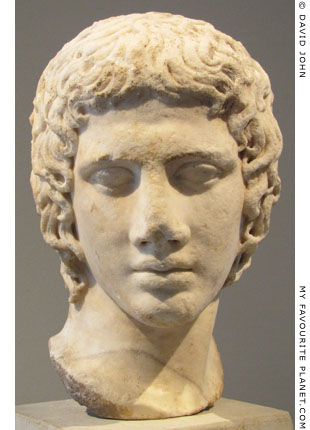
The so-called "Triptolemos" marble head of
a young man, identified as Triptolemos; the
only known head of this type. The features
resemble those of portraits of Antinous,
Emperor Hadrian's deified favourite.
Roman period, 120-140 AD, perhaps a
copy of a Greek Classical type. Allegedly
found near Herculaneum, Italy, in 1750.
Height 34.7 cm, width 22.5 cm, depth 26 cm.
Purchased in Italy in 1755 by Markgräfin
Wilhelmine von Bayreuth, who left it in her
will to Frederick the Great in 1758/1759.
Separated from its Baroque bust, it entered
the Königliche Museum, Berlin in 1830.
Altes Museum, Berlin. Inv. No. Sk 479. |
|
| |
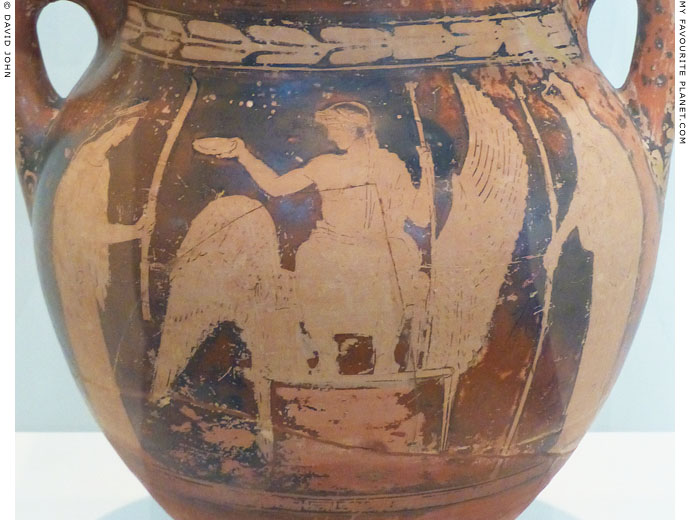
Detail of an Attic red-figure amphora showing Persephone (Kore), Triptolemos and Demeter.
By a painter of the Polygnotan Group. Third quarter of the 5th century BC. Provenance unknown.
A youthful Triptolemos, seated in his winged chariot with a sceptre and phiale (libation bowl),
about to set off on his mission to teach humans the cultivation of corn. Persephone, left, holds
a torch and an oinochoe (wine jar) for the departure libation. Demeter, right, holds a sceptre.
National Archaeological Museum, Athens. Inv. No. 1166. |
| |
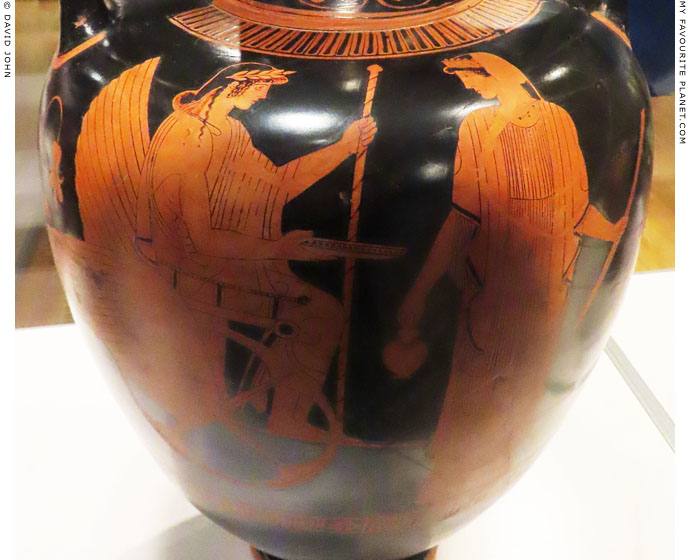
Detail of an Attic red-figure neck amphora showing a youthful, beardless Triptolemos in his
winged chariot, with Demeter standing to the right, holding an oinochoe (wine jug) and a torch.
460-450 BC. Attributed to the Niobid Painter by John Beazley. From Vulci, Etruria, Italy.
Side B shows Iris, holding a kerykeion (caduceus), flying from the right towards Zeus.
Rijksmuseum van Oudheden, Leiden, Netherlands. Inv. No. PC76.
From the Canino Collection. Acquired from Lucien Bonaparte in 1839.
See: Beazley Archive Database, Vase No. 206998. |
| |
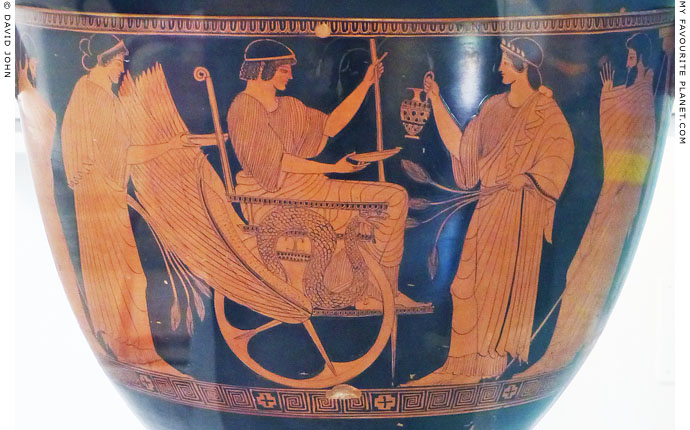
Detail of an Attic red-figure bell krater showing Persephone (Kore), Triptolemos and Demeter,
with King Keleus of Eleusis (Triptolemos' father) and Hippothoon standing at the sides.
Attributed to the Orithyia Painter. 470-460 BC. Height 40.5 cm, diameter 46 cm.
Antonino Salinas Regional Archaeological Museum, Palermo, Sicily. Inv. No. 2557.
|
The largest of five kraters, which had been used as cinerary urns, discovered in a field, the site of a burial complex at Agrigento (ancient Akragas), Sicily in 1841 by Domenico Cardillo (the owner of the field), Gerlando Alletto and Giovanni Gentile. The kraters were given as a gift to King Ferdinand II of Bourbon who donated them to the Museum of the Royal University of Palermo.
The other side of the krater shows Zeus arbitrating in a dispute between Achilles and Memnon.
See: J. Bovio Marconi, Corpus Vasorum Antiquorum, Italia, Museo Nazionale di Palermo (Rome, 1938), page 18 and Plate 35. |
|
| |
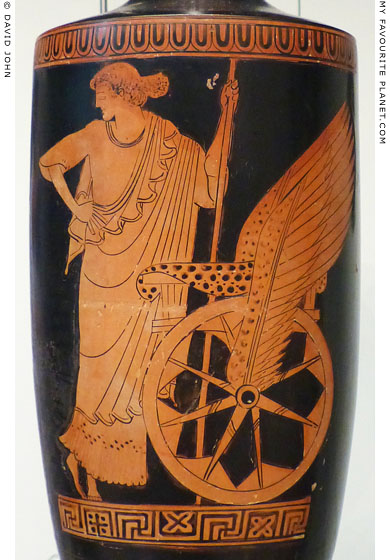
Detail of an Attic red-figure lekythos (oil jar) showing
Triptolemos standing by his winged chariot.
Attributed to the Eucharides Painter.
500-450 BC. Found in Gela, Sicily.
Ashmolean Museum, Oxford. Inv. No. AN1891.683. |
| |
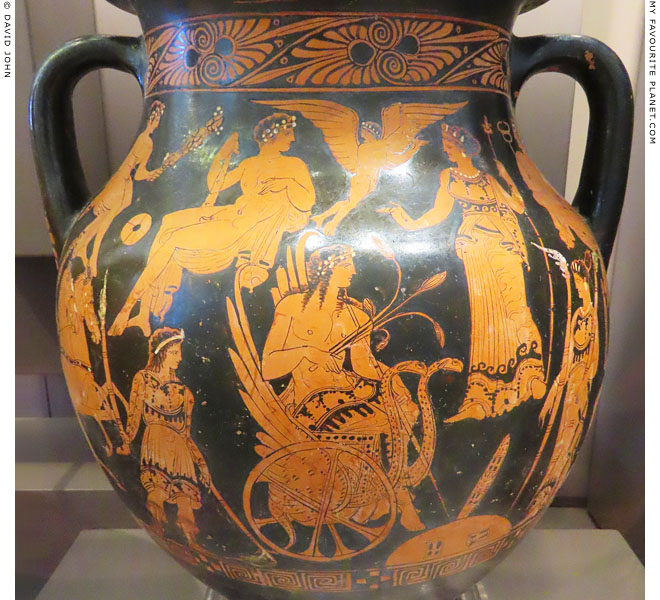
Detail of an Attic red-figure belly amphora (Type B) showing Triptolemos, holding a sheaf of corn,
sits in a winged chariot with snakes, facing right. Above him flies a small, winged Eros. In front of
him (right) stand Demeter and Persephone with torches. Hermes, youthful, beardles and naked,
sits to the right of them, holding his kerykeion (caduceus). Below him (not visible in photo),
sits a youth holding a bakchos (βάκχος, a mystic myrtle staff).
Behind Triptolemos (left) sits a youthful Herakles, naked and beardless, holding his trademark
club in his right hand. The figure below him with a lowered torch has been identified as Aphrodite.
To the far left are two youths, each holding a bakchos. One sits opposite Herakles, and the other,
below him, drives a biga (two-horse chariot). The three youths may be figures associated with the
Demeter myths, such as Iasion and Keryx. The large stone below Triptolemos's is perhaps an
omphalos or an object associated with the myth (the Mirthless Stone? See part 1).
Classical period, 425-375 BC. From Kos, Dodecanese.
Kos Archaeological Museum. Inv. No. 137.
See: Beazley Archive Database, Vase No. 10367 |
| |
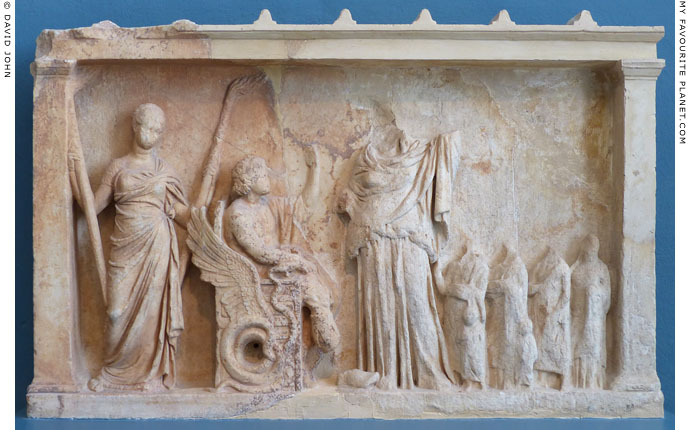
Votive relief depicting Triptolemos being sent on his mission.
From Eleusis. Early 4th century BC. Found in two pieces
by Demetrios Philios in 1885. Height 75 cm, width 123 cm.
Triptolemos sits on a throne, at the side of which is a coiled, winged serpent,
"a car with drakones (dragon-serpents) yoked" (Orphic Hymn 40 to Demeter).
Persephone (Kore) stands behind him with two torches, and Demeter stands
in front of him. To the right stand four adult worshippers and two children.
Eleusis Archaeological Museum. Inv. No. 5061. |
| |
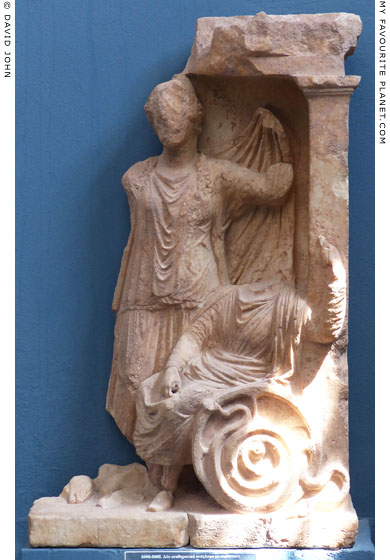
Fragment of a votive relief depicting
Triptolemos and Demeter.
From Eleusis. Early 4th century BC.
As in the relief above, Triptolemos is seated with his
left arm raised. In front of him is a wheel with a serpent
coiled around the hub. Demeter stands behind him,
wearing a peplos and a himation (cloak) an edge of
which she over her left shoulder with her left hand.
Demeter is also shown in this pose on the
Rhetoi Decree relief from Eleusis (see Part 1).
Eleusis Archaeological Museum. Inv. No. 5060-5062. |
|
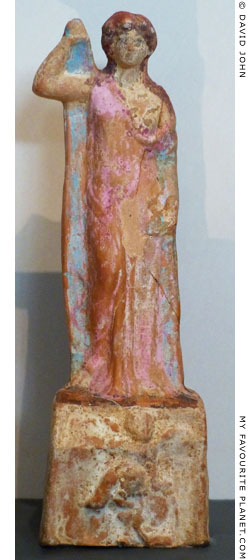
A multicoloured ceramic figurine
of a female figure lifing the edge
of her himation with her right hand.
Other goddesses, including Aphrodite
and Hera, are also shown in this pose.
This figure is likely to be of the
Aphrodite "in the gardens" type.
Her left shoulder and breast are
bare, and the pedestal is decorated
with relief erotes. The colours. have
been well preserved: the long brown
hair, pink chiton and blue himation.
On the back is the incised name of
the manufacturer Monomachos.
1st century AD. From Derveni
(ancient Lete), Macedonia.
Thessaloniki Archaeological Museum. |
|
| |
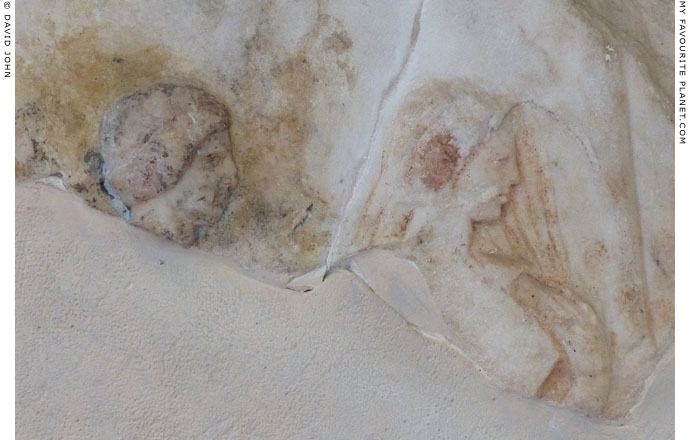
Fragment of a votive relief with traces of paint, depicting
two figures (Triptolemos and Demeter) facing right,
and a torch held by a third figure (Persephone).
Late 5th - early 4th century BC.
Eleusis Archaeological Museum. Inv. No. 5059. |
| |
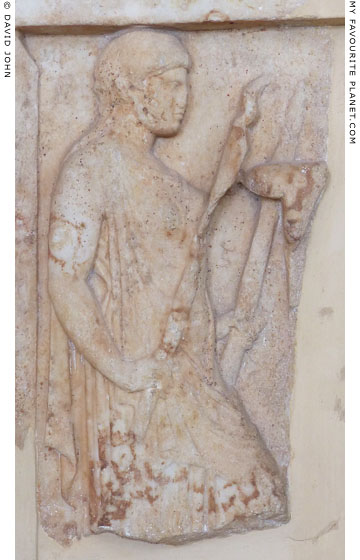
Fragment of a stele with a votive relief depicting
a female figure (Persephone) holding torches.
Late 5th century BC.
Another fragment shows the left arm of a figure holding
a sceptre (Triptolemos). The inscription on the top of the
stele names the dedicator as Plathis, son of Dionysios.
Eleusis Archaeological Museum. Inv. No. 5233. |
| |
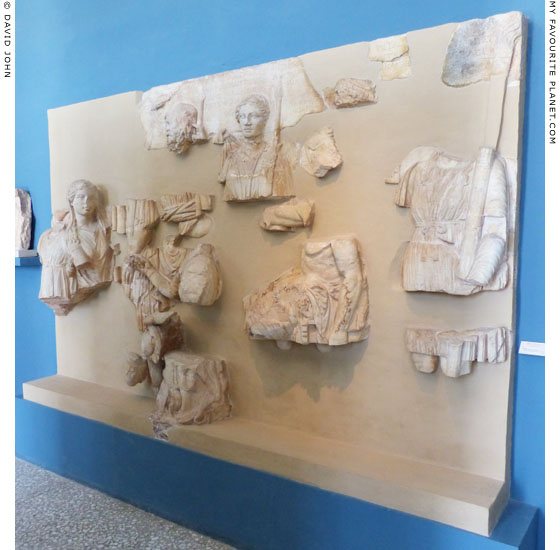
Fragmentary marble votive relief, by far the largest relief from Eleusis, depicting
Triptolemos being sent on his mission. Known as the "Lakrateides relief", it was
dedicated by the priest Lakrateides (Λακρατείδης Σωστράτου Ἰκαριεύς), and
members of his family, who are represented on the relief as votaries, to the
Eleusinian deities. The figures shown on the relief are labelled by inscribed
descriptions (see below). Although it has been called the "the Rosetta Stone
of Eleusis", because it originally depicted and identified almost all the essential
Eleusinian deities, it is too fragmentary to be compared fairly to the famous
trilingual Egyptian stele. On the far right, a fragmentary figure of a youth,
wearing a short, long-armed chiton (tunic) carrying a torch, is thought to be
either Iakchos (Ἴακχος: Latin, Iacchus) or Euboleus (see below).
The inscribed label for this figure has not been found.
From Eleusis. 100-90 BC. Most of the more than 60 fragments were found in
the "Ploutonion" (see above) during excavations led by Greek archaeologist
Demetrios Philios (see part 1). Height 180 cm, original width circa 3 metres.
Eleusis Archaeological Museum. Inv. No. 5079.
Inscription I.Eleusis 239 (also IG II(2) 4701 and IG II(2) 4871).
Unfortunately, the relief is exhibited in a very confined space, behind a large display
panel, so that it is impossible to stand directly in front of it and view the entire work. |
| |
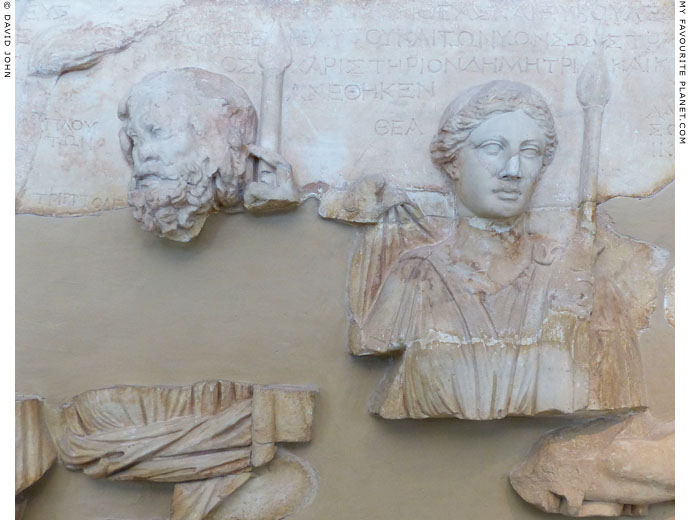
Detail of the Lakrateides relief in Eleusis. According to the inscriptions next to the heads
of the two standing figures, they are "Plouton" and "Thea" (Persephone) standing with
sceptres. Both deities appear twice on the relief. In his other appearance, seated to the
right of this depiction of Persephone, Pluto is labelled as "Theos". The pair are thus
described as the god and goddess of the Underworld. |
| |
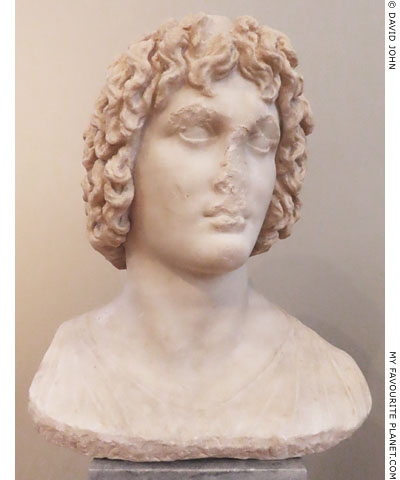
A marble bust thought to depict Eubouleus,
(Εὐβουλεύς, Good Counseller), a god
connected with the Eleusian Mysteries.
Around 330-320 BC. Found in 1883 in the
"Ploutonion" at Eleusis by the Greek
archaeologist Demetrios Philios (see part 1).
National Archaeological Museum,
Athens. Inv. No. 181. |
|
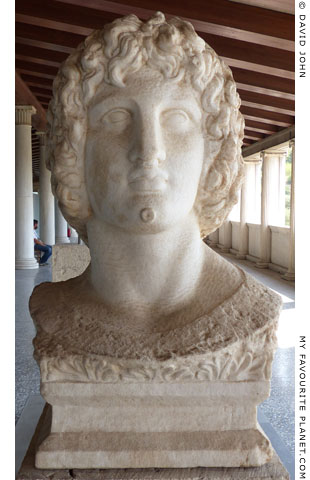
A marble bust of Eubouleus
or Alexander the Great.
Unfinished 2nd century AD copy of a work
of the 4th century BC. Discovered in 1959
by Dorothy Burr Thompson in the Athens
Agora. Thasian marble. Height 61 cm,
height of base 12 cm, width 39 cm.
Agora Museum, Athens. Inv. No. S 2089. |
|
| |
The identity of Euboleus is unknown, and was a matter of conjecture even by the time of Pausanias, who mentioned an Argive legend and an Orphic poem which named him as the brother of Triptolemos (see note in Part 1). Other ancient sources refer to him variously as the son of Demeter or Zeus, or as Pluto. George E. Mylonas suggested he may have been "the Chthonian (or underworld) Zeus, an aspect of the Father of Gods and Men that is somewhat rare". [14]
According to one version of the myths, Eubouleus was a swineherd who happened to be tending his pigs at the "chasm of Kore" (χάσματι τῆς Κόρης), the place where the earth opened up for Plouton's chariot during the abduction Persephone to the underworld, and he and his pigs were also swallowed into the earth. An early example of collateral damage. The story is mentioned in the scholion on Lucian's Dialogues of the Courtesans (see note in Part 1) as "the more fabulous explanation" for the casting of piglets into the chasms (χάσματα) or megara during the Thesmophoria.
A small number of sculpted heads of this type have been speculatively identified as Eubouleus. This is perhaps due to the fact that the first of the type (photo, above left) was found at Eleusis, in the "Ploutonion", also referred to as "the Sacred Precinct of the Mirthless Stone", although other examples have been found at various locations around Attica. The bust was presumed to depict a god connected with the Eleusinian Mysteries, but did not appear to match the iconography of depictions of Triptolemos. Iakchos (Ἴακχος; Latin, Iacchus) has also been suggested. It was associated by archaeologists Otto Benndorf and Adolf Furtwängler with a headless herm in the Vatican Museums, Rome inscribed Εὐβουλεύς Πραξιτέλους (Eubouleus of Praxiteles). It has also been attributed to Leochares and Euphranor, and compared with portraits of Alexander the Great, and particularly the "Inopos" statue from Delos. It has also been suggested that the bust could be an idealized portrait of Demetrios Poliorketes, king of Macedon (294-288 BC).
An inscribed base for a statue of Eubouleus (inscription IG II² 4615) was also found in the "Ploutonion", near to where the bust was found, and similarly dated to around 330-320 BC. However, the two are not thought to belong.
A similar marble head of the same type found in Athens was made in the 2nd century AD. National Archaeological Museum, Athens. Inv. No. 2650.
A Roman period herm bust, also identified as Euboleus, is in the Palazzo Nuovo of the Capitoline Museums, Rome. Inv. No. MC 505. Height 61.5 cm. Previously in the Albani Collection.
See: Ernest Arthur Gardner, A Handbook of Greek Sculptures Part 2, pages 487-489. Macmillan and Co., London, 1897. At the Internet Archive. |
|
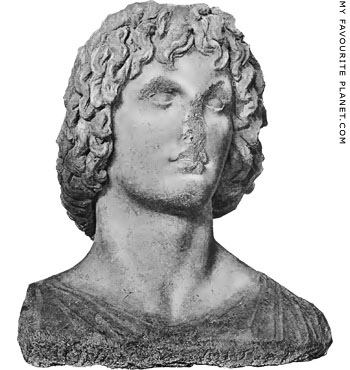
A 19th century image of the bust of
Eubouleus from Eleusis, now in the National
Archaeological Museum, Athens. Inv. No. 181
(see photo above left).
Source: Maxime Collignon, Geschichte der
Griechischen Plastik, Band 2, Tafel 6, page 323.
German translation by Fritz Baumgarten.
Karl J. Trübner, Strassbourg, 1898. |
|
| |
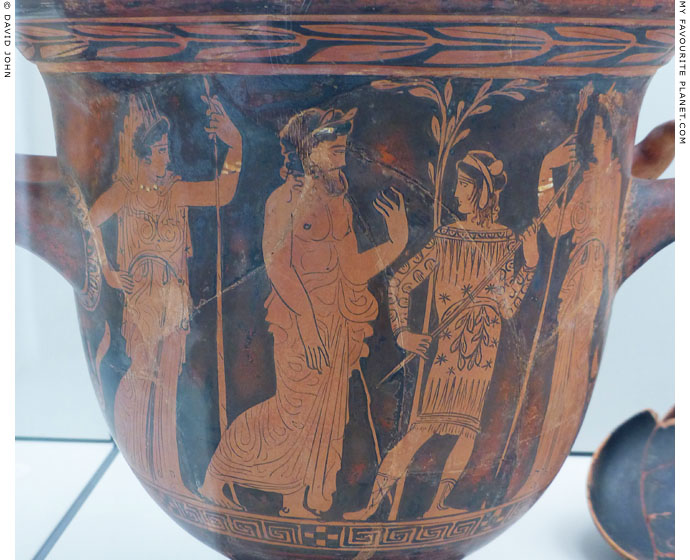
Detail of an Attic red-figure bell krater showing a bearded man
and Triptolemos (?) in the presence of Demeter and Persephone.
Attributed to the Odeon Painter, 425-400 BC.
From a grave at Selinous (Selinunte), Sicily.
Antonino Salinas Regional Archaeological Museum, Palermo, Sicily. |
 |
| |
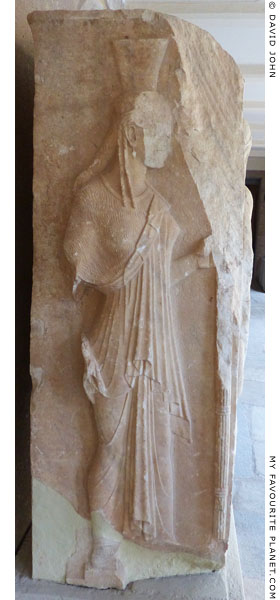 |
|
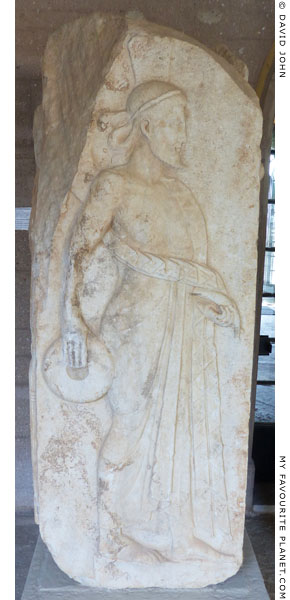 |
|
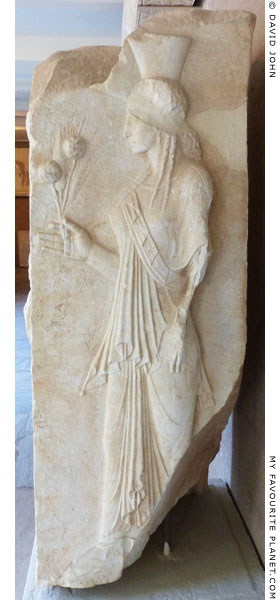 |
A marble base or pier with Archaistic reliefs on three sides, left to right:
Persephone carrying a torch; a male deity identified as Zeus Chthonios
(or Plouton?) holding a phiale (libation bowl) and a rhyton (drinking horn);
and Demeter holding poppies and ears of corn.
From the Forum of Ancient Corinth. Roman period, 1st century AD.
Corinth Archaeological Museum. Inv. No. S-74-27.
A similar base in the museum has reliefs of Athena, Hera and Dionysus. |
|
| |
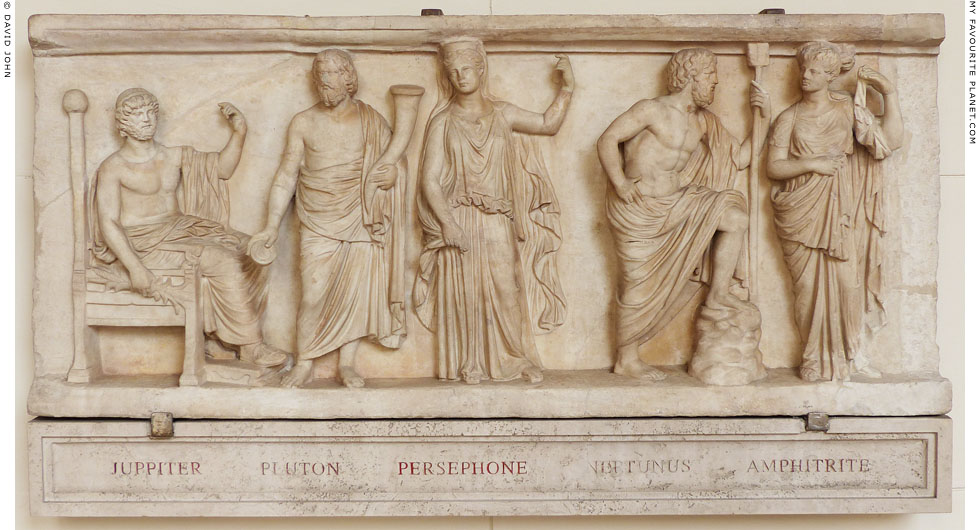
A marble relief with figures of deities (left to right): Zeus (Jupiter), Plouton, Persephone,
Poseidon (Neptunus) and Amphitrite. The deities, identifiable from their attributes, are
modelled on sculptures from various periods of Greek art, from Classical to Hellenistic.
Pentelic marble. Made during the Hadrianic period, first half of the 2nd century AD,
when iconographical eclecticism reached its peak. The inscription below is modern.
Palazzo Altemps, National Museum of Rome. Inv. No. 381002. del Drago Albani Collection.
|
Drawings and prints of this relief were made during the 17th century, and were included in a book published in Rome in 1693 by Pietro Santi Bartoli (1635-1700), containing prints by Bartoli and other artists of ancient artworks at that time in city.
See: Pietro Santi Bartoli, Admiranda Romanarum antiquitatum ac veteris sculpturae vestigia: anaglyphico opere elaborata ex marmoreis exemplaribus quae Romae adhuc extant in Capitolio, aedibus hortisque virorum principum ad antiquam elegantiam, plate 28. Rome, 1693. At the Internet Archive. |
|
| |
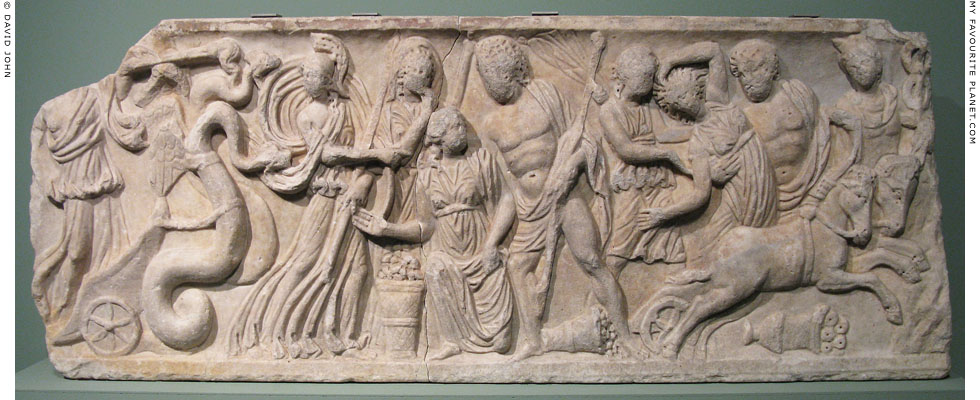
The front panel of a marble sarcophagus with a relief depicting three scenes from the
myth of the abduction of Proserpina (the Roman equivalent of Persephone) by Pluto.
3rd century AD. Height 83.5 cm, width 216 cm, depth 9 cm.
Antikensammlung, Berlin State Museums (SMB). Inv. No. Sk 847 a–c.
Formerly in the Palazzo Caraffa-Colobrano, Naples.
Purchased in Rome in 1864 by Wolfgang Helbig (1839-1915).
|
In the centre, Proserpina, accompanied by Venus (Aphrodite), kneels to gather flowers in a basket when she is surprised by Pluto. On the right, he takes her down to the Underworld in his chariot, chased (or assisted?) by Diana (Artemis). Two baskets of flowers are shown overturned on the ground. Hermes, with his caduceus, stands at the far right to show the way, and part of a rock face indicates the entrance to Hades.
On the left, Ceres (Demeter), holding a torch, searches for her missing daughter, riding in a chariot drawn by two large, winged serpents, led by helmeted Minerva (Athena) who points to the place where Proserpina disappeared. The serpent-drawn chariot is presumably the one in which Triptolemos was sent on his mission (see above).
A number of ancient reliefs depicting these scenes have survived, including one on a sarcophagus of white Carrara marble, made in Rome in the first quarter of the 3rd century AD, and now in the treasury of Aachen Cathedral, Germany. It is thought that it may have been used as the tomb of Emperor Charlemagne (742-814 AD), either immediately following his death or possibly after Frederick Barbarossa had exhumed his remains in 1165. Although there appears to be no documentary evidence for this, it is known that ancient sarcophagi with reliefs of pagan imagery were reused as tombs for prominent Christians. See, for example, a sarcophagus with a relief depicting the hunt of the Kalydonian Boar, used as the tomb of Archbishop Cesare Marullo, in Palermo Cathedral, Sicily. |
|
| |
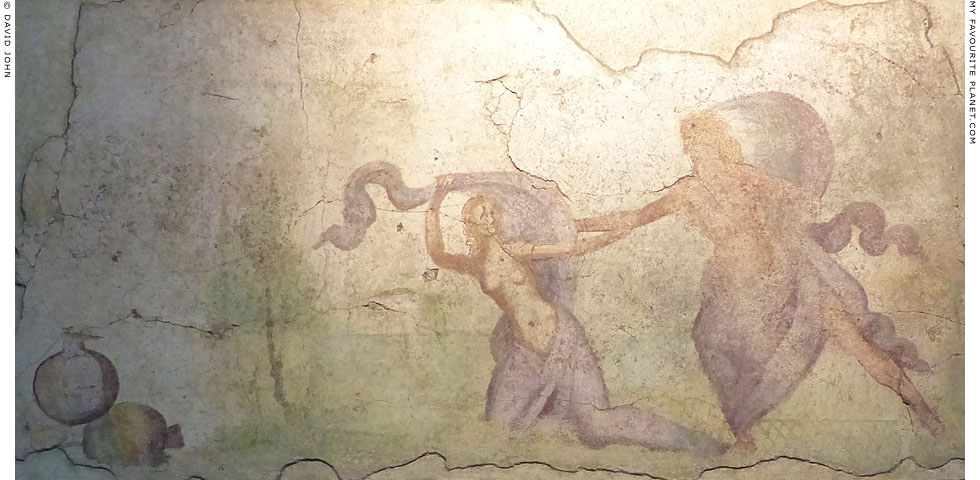
A Roman fresco depicting the abduction of Proserpina by Pluto in
an outdoor setting with trees. On the left are two pomegranates.
Late 2nd century AD. From the Porta Laurentina necropolis, Ostia.
Discovered in 1865-1866 in the "Columbarium of the Caecilii"
(perhaps tomb 34), during excavations by Pietro Ercole Visconti.
Height 60cm, width 132 cm.
Museo Gregoriano Profano, Vatican Museums, Rome. Inv. No. 59. |
| |
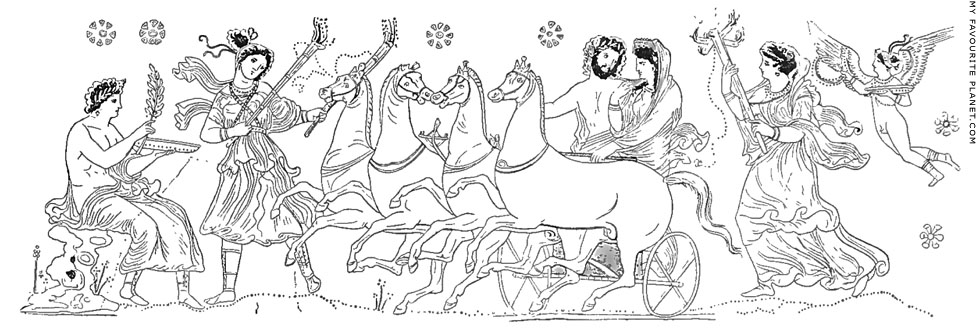
Drawing of a painting on a red-figure Apulian amphora showing
Plouton and Persephone in a quadriga (four-hourse chariot).
4th century BC.
Source: Reinhard Kekulé von Stradonitz (1839-1911), Echelos und Basile: attisches
Relief aus Rhodos in den Königlichen Museen, page 9. Georg Reimer, Berlin, 1905.
|
This scene probably depicts the annual return of Persephone from Hades, often referred to as the anodos (ἄνοδος, the way upwards), rather than her abduction by Plouton and her descent to the Underworld, the kathodos (κάθοδος, the way down). There is no sign of resistance on Persephone's part, and the pair in the chariot appear to look at each other tenderly. Demeter, holding a four-armed Eleusinian torch, runs to the chariot, eager to greet her daughter. She is followed by a flying Eros or Hymenaios (Ὑμεναιος), the god of marriage ceremonies, holding a wreath and a bowl. Left of the chariot Hekate runs with two long torches. On the far left, a wreathed young male sits on a rock holding out a bowl and a branch of laurel or myrtle. He is shown in a way similar to depictions of Apollo and Dionysus (see for example an Apulian vase on the Dionysus page), but may be an Eleusinian deity, perhaps Triptolemos.
At the time this drawing was made, in the mid 19th century, the amphora was in the Fittipaldi Collection in Anzi, southern Italy. Although it was discussed in a number of publications, I have so far found no recent mentions of it. The Fittipaldi Collection was later sold off and is now dispersed among several collections and museums.
As the source of the illustration, Kekulé cited: Monumenti dall' Instituto di Corrispondenza Archeologica, Volume VI, Plate XLII; Annali, Rome, 1860, pages 309 onwards (Stephani).
See also:
Richard Foerster (1843-1922), Der Raub und die Rückkehr der Persephone (Philologus supplement, Band IV), No. 8, pages 243-245. Albert Heitz, Stuttgart, 1874. At the Internet Archive.
Johannes Adolf Overbeck (1826-1895), Griechische Kunstmythologie II, Zweiter Band, dritter Theil, viertes Buch: Demeter and Kora (1878), No. 7, page 597. Illustration in Overbeck's Atlas, Tafel XVII, 27. Verlag von Wilhelm Engelmann, Leipzig, 1873-1978. At the Internet Archive.
Both Foerster and Overbeck discussed similar scenes on a number of ancient vases. Plouton and Persephone are depicted in a quadriga in a similar way, but accompanied by Hekate and Hermes, on an Apulian red-figure volute krater, 370-350 BC, attributed to the the Iliupersis Painter, now in the British Museum. Inv. No. 1885,0314.1 (Vase F 277, not on display).
See: www.britishmuseum.org/research/collection_online/... |
|
| |
Demeter and
Persephone
Part 2 |
Notes, references and links |
 |
|
1. The discovery of the Demeter of Knidos statue
The site of the ancient Carian city of Knidos (Κνίδος; Latin, Cnidus) is on the Datça peninsula at Yazıköy, in the Datça district, Muğla Province, Turkey, south of Bodrum. The sanctuary of Demeter was on an elevated area 74 metres long and 40 metres wide at the east of the city. Newton referred to the sanctuary as the Temenos of Demeter, Persephone, and Pluto Epimachos (Πλούτων Ἐπίμαχος, open to attack), after his discovery of an inscribed base of Parian marble dedicated to Demeter, Persephone, Pluto Epimachos and Hermes, by Sostratos, son of Lachartos (British Museum, Inv. No. 1859,1226.45, Inscription 811).
See: Sir Charles Thomas Newton (1816-1894) and Richard Popplewell Pullan (1825-1888), A History of Discoveries at Halicarnassus, Cnidus and Branchidae.
Volume II, Part 2, Chapter XV: Temenos of Demeter, Persephone, and Pluto Epimachos. Day and Son, London, 1863. At the Internet Archive.
Volume I, Plates. Day and Son, London, 1862. At University of Heidelberg Digital Library.
Plate LV, seated Demeter statue; Plate LVI, marble statue, perhaps a priestess of Demeter; Plate LVII, marble statuette of Persephone wearing a high polos; Plate LVIII, fig. 3, marble statuette of a pig (image below); Plate LX, Fig. 7, terracotta head of an old woman; Plate LXXXIX, No. 14, dedication to Demeter, Persephone, Pluto Epimachos and Hermes. |
|
|
| |
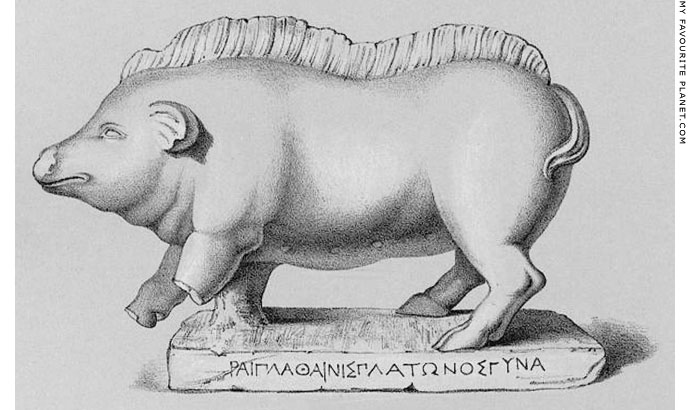
Marble votive figure of a pig on an inscribed base (now broken), dedicated to
Persephone by Plathainis, the wife of Plato. From the sanctuary of Demeter, Knidos.
Hellenistic, circa 350-300BC. Newton described the figure as a small boar, but according
to the British Museum description it is a pregnant sow; a row of teats can be seen in the
lithograph. Height 39.37 cm. Length of figure 58.4 cm. Present length of base 45.7 cm.
British Museum. Inv. No. 1859,1226.28 (Sculpture 1305). Inscription 808. Acquired in 1859.
Source: Sir Charles Thomas Newton and Richard Popplewell Pullan,
A History of Discoveries at Halicarnassus, Cnidus and Branchidae, Volume I, Plates,
Plate LVIII, fig. 3; inscription, Plate LXXXIX, No. 19. Day and Sons, London, 1862.
At University of Heidelberg Digital Library.
Arthur Hamilton Smith, A Catalogue of Sculpture in the Department of Greek and Roman Antiquities,
British Museum, Volume II, No. 1305, page 206. British Museum, London, 1900. At the Internet Archive.
C. T. Newton (editor), The collection of ancient Greek inscriptions in the British Museum,
Part IV, Section I, Gustav Hirschfeld, Knidos, Halikarnassos and Branchidae, No. DCCCVIII (805),
page 21. Two other dedications by Plathainis, DCCLXXXVIII (788) and DCCCIII (803).
Clarendon Press, Oxford, 1893. At the Internet Archive. |
|
2. The discovery of a bronze sculpture near Bodrum
On 9 August 1953 the statue became caught up in the net of a sponge fisherman (variously named as Achmet Erbil or Ahmet Erbin) from Bodrum, at a depth of 75 metres, off the coast of Arap Adasi, near the Knidian peninsula, south of Bodrum. He left it on the beach of the village of Bitez, just to the west of Bodrum.
It was brought to the attention of Geore Ewart Bean (1903-1977), a British professor of Classics at Istanbul University, who happened to be in Bodrum at the time on one of his many tours of archaeological sites in Turkey. Having examined the sculpture, he arranged to have it transported to the museum in Izmir. His account of the find appeared in The Illustrated London News on 7 November 1953, and his sister Margaret Bean gave a talk about it on BBC radio in 1954.
"Last August some Turkish sponge-fishers brought up in their nets the head of a Greek bronze statue, probably a statue of Demeter of the fourth century BC. It is agreed by all to be among the most important artistic finds of recent years. Miss Bean and her brother, an archaeologist, were the first people, besides the villagers of Bitez, to see the fishermen's catch."
Head of a goddess, a radio talk by Margaret Bean, BBC Home Service, 25 February 1954.
See:
George E. Bean, "A masterpiece from the sea", The Illustrated London News, 7 November 1953, pages 747-749.
Brunilde Sismonodo Ridgway, The Lady from the Sea: A Greek Bronze in Turkey. American Journal of Archaeology, Volume 71 (1967), pages 329-334 and plates 97-100. At Scholarship, Research, and Creative Work at Bryn Mawr College.
Brunilde Sismonodo Ridgway, The Bronze Lady From the Sea. Expedition magazine, Volume 10, Issue 1, pages 2-9. Penn Museum, September 1967.
Jeremy Green, Report on the Demeter Side Scan Sonar Search and the Aslan Burnu Site Survey, Turkey, 2004. Report Number 188, Department of Maritime Archaeology, Western Australian Maritime Museum, 2004.
"Underwater archaeology spreads in Turkey", Hurriyet Daily News, 4 April 1999.
3. Alessandro and Francesco Sanguinetti
The brothers Alessandro (1816-?) and Francesco (1800/1804-1870) Sanguinetti, from Carrara, Italy, were pupils of their father Gaetano Sanguinetti (1781-1842), and then of Christian Daniel Rauch (1777-1857) in Berlin. They made several copies of ancient sculptures to replace originals set up in Sanssouci by Frederick the Great and later moved to the Berlin State Museums.
See also a statue of Asklepios by the Sanguinetti brothers at Sanssouci.
Other replicas at Sanssouci include a copy of the Antinous/Agathos Daimon statue, made in 1852 by August Julius Streichenberg (1814-1878).
Rauch made the statue of Victoria for the Friedensäule monument in Berlin, and another of his pupils, Friedrich Drake designed the colossal Victoria statue for the Siegessäule, also in Berlin.
4. Becatti on the Ostia Dodekatheon
Giovanni Becatti (1912–1973), Un Dodekatheon Ostiense e l'arte di Prassitele. Annuario della Regia Scuola Archeologica di Atene e delle Missioni Italiane in Oriente, XXII, pages 1-53. Rome, 1942.
Giovanni Becatti, Nuovo frammento del dodekatheon prassitelico di Ostia. Bollettino d'Arte III (Luglio-Settembre - XXXVI), pages 193-200. Rome, 1951.
Both articles were republished in Giovanni Becatti, Kosmos, studi sul mondo classico (collected articles). L'Erma di Bretschneider, Rome, 1987. Un Dodekatheon Ostiense..., pages 3-62; Nuovo frammento..., pages 161-168.
5. Carpenter on the Ostia Dodekatheon
Rhys Carpenter, The Ostia Altar and the East Pediment of the Parthenon, pages 71-74 and plate 10, in: Hesperia Supplements, Volume 8, Commemorative Studies in Honor of Theodore Leslie Shear, pages 71-74 and plate 10 (page 446). The American School of Classical Studies at Athens (ASCSA), 1949. At jstor.org.
See also: Antonio Corso, The Art of Praxiteles: The mature years, pages 192-201. L'Erma di Bretschneider, Rome, 2007.
Corso discusses characteristics of the figures on the Ostia Dodekatheon, but does not significantly challenge Becatti's identification of the figures. He mentions that the altar may have originally been a cylindrical base for a bronze statue with a private dedication.
6. The order of the twelve gods
An Archaistic relief now in the Walters Art Museum depicts a procession of the twelve gods, in a row advancing to the right. The deities have been identified a follows (left to right):
1. Hestia (with sceptre and another object), 2. Hermes (with cap and caduceus), 3. Aphrodite (veiled),
4. Ares (with helmet and spear), 5. Demeter (with sceptre and wheat sheaf), 6. Hephaistos (with staff),
7. Hera (with sceptre), 8. Poseidon (with trident), 9. Athena (with helmet, spear and owl),
10. Zeus (with thunderbolt and staff), 11. Artemis (with bow and quiver), 12. Apollo (with kithara).
Made in Athens, 1st century BC - 1st century AD.
Walters Art Museum, Baltimore. Inv. No. 23.40.
7. Pindar, Pythian Ode 12
αἰτέω σε, φιλάγλαε, καλλίστα βροτεᾶν πολίων,
Φερσεφόνας ἕδος, ἅ τ᾽ ὄχθαις ἔπι μηλοβότου
ναίεις Ἀκράγαντος ἐΰδματον κολώναν, ὦ ἄνα
ἵλαος ἀθανάτων ἀνδρῶν τε σὺν εὐμενίᾳ
δέξαι στεφάνωμα τόδ᾽ ἐκ Πυθῶνος εὐδόξῳ Μίδᾳ
αὐτόν τέ νιν Ἑλλάδα νικάσαντα τέχνᾳ, τάν ποτε
Παλλὰς ἐφεῦρε θρασειᾶν Γοργόνων
οὔλιον θρῆνον διαπλέξαισ᾽ Ἀθάνα:
Pindar, Pythian Ode 12 (in Greek), lines 1-8. At Perseus Digital Library.
As ever, the sense of parts of the ode differ in various translations. The start of the poem is thought to be an invocation of the nymph Akragas, after whom the river and the city were named. The "mistress" (elsewhere translated as "queen" or "matron") would therefore refer to the nymph as the mistress of the city rather than to Persephone. Other translations also translate the phrase "abode" or "home" of Persephone, as "throne" or "seat". So far, I have found no commentary on the ode which discusses why Pindar here chose to mention Persephone in particular.
8. Demeter busts in the Baths of Diocletian
See: Baths of Diocletian, guide, pages 18-19. Ministero dei Beni e della Attività Culturali e del Turismo. Mondarori Electa S.p.A., Milano, 2016 (first edition 2011).
The bust illustrated on page 19, and described by the museum labelling as showing Demeter wearing a torque ending in snakes' heads around her neck was not on display during my recent visit (April 2017). The bust in the photo above appears to have been exhibited in its place. |
|
|
|
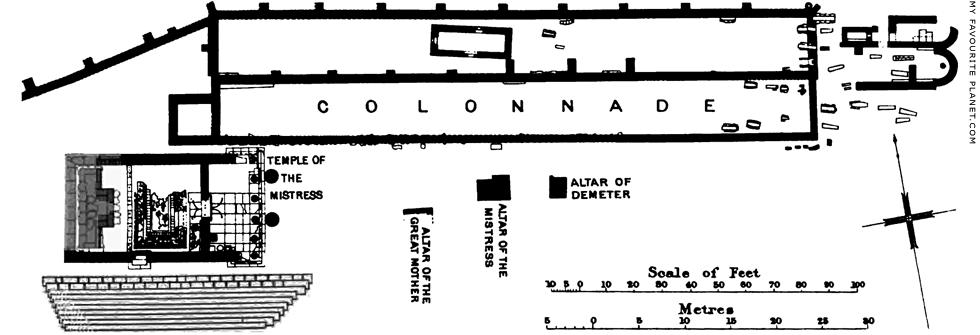
A plan of the sanctuary of Demeter and Despoina at Lykosoura.
Source: J. G. Frazer, Pausanias's Description of Greece, translated with a commentary,
Volume 5 (of 6), plate X, page 622. Macmillan and Co., London, 1898.
Based on the excavations directed by the Greek archaeologist B. Leonardos in 1895.
First published in: Πρακτικά της εν Αθήναις Αρχαιολογικής Εταιρείας, 1896, pages 93-126.
(Praktika, Proceedings of the Archaeological Society of Athens). Athens, 1897.
|
9. The reconstruction of the Lykosoura group
Guy Dickins (1881-1916) wrote the history of his reconstruction in a four part article, which also includes a contribution by Konstantinos Kourouniotis concerning the original construction of the statue group, as well as Dickins' description of Damophon's style and a summary of other works attributed to him.
Guy Dickins and K. Kourouniotis, Damophon of Messene II: The restoration of the group at Lykosura, The Annual of the British School at Athens, Volume 13 (1906/1907), pages 357-404. At jstor.org.
Kourouniotis's contribution, The mechanical construction of the group, including his comment on Pausanias' credulity, pages 384-389.
Kourouniotis comment about locals "playing on the credulity of tourists" conjures images of flocks of culture-tourists from around the Roman Empire, including Pausanias himself, visiting ancient sites in Greece, where their hosts spun yarns and sold them souvenirs such as copies of famous artworks, perhaps like the "Varvakeion statuette" and "Athena Lenormant" miniature replicas of Pheidias' Athena Parthenos (see Pergamon gallery 2, page 14).
Such a scenario would help explain why Megalopolis depicted the Lykosoura statue group on its coins: the sanctuary had presumably become a notable tourist attraction and local source of pride. Like many Roman empresses, Julia Domna was associated with several deities including Demeter/Ceres (see a statue of Julia Domna as Ceres in Part 1), and perhaps the coins were part of a campaign to associate her with the Lykosoura sanctuary. Ironically, if the Lykosourians had not defied the order to abandon their city and move to Megalopolis (assuming the tale told to Pausanias was true), the sanctuary may have ceased to exist.
Following the publication of the coin by Valerios Stais, Dickins defended his reconstruction and examined what evidence the coin offered concerning the statue group.
Guy Dickins, Damophon of Messene: III, The Annual of the British School at Athens, Volume 17 (1910/1911), pages 80-87. At jstor.org.
Dickins' academic career was interrupted by World War I. He served as an infantry captain on the Western Front and died on 17th July 1916 of wounds received four days earlier at Pozieres, during the Battle of the Somme. Before his death he had completed the first of a planned two-volume catalogue of the Acropolis Museum: Catalogue of the Acropolis Museum, Volume I: Archaic sculpture, Cambridge University Press, 1912. The second volume, completed by Stanley Casson and Dorothy Lamb Brooke Nicholson, was finally published in 1921: Volume II, Sculpture and architectural fragments. The manuscript of his unfinished Hellenistic sculpture was published in 1920 by Oxford University Press, with a preface by Percy Gardner.
See: winchestercollegeatwar.com/archive/guy-dickens/. At Winchester College at War.
Although most sources, including the Athens museum, state that the statues were made of Doliana marble, from Doliana (Δολιανά), near Tegea in eastern Arcadia, others claim that Pentelic marble was used. I have so far found no evidence for this claim. The group was not acrolithic (of wood and stone), as some recent authors have stated. The surviving fragments include parts of marble arms, legs, torsos and drapery. The sizes of the statue heads differ in various sources. I have used the heights quoted in the usually reliable University of Köln Archaeological Institute database: arachne.uni-koeln.de
For a short discussion of the reliefs on Despoina's veil, see:
Alan J. B. Wace (Alan John Bayard Wace, 1879-1957), The veil of Despoina, American Journal of Archaeology, Volume 38, No. 1 (Jan. - Mar. 1934), pages 107-111. At jstor.org. |
|
|
10. Discovery of Lykosoura and early excavations
For accounts of the discovery of Lykosoura and early excavations there, see:
Edward Dodwell (1767-1832), A classical and topographical tour through Greece during the years 1801, 1805 and 1806, Volume II (of 2), pages 394-395. Rodwell and Martin, London, 1819. At the Internet Archive.
William Martin Leake (1777-1860), Travels in the Morea, Volume II (of 3), page 312. John Murray, London, 1830. At the Internet Archive.
Leake visited the area shortly before Dodwell but published the account of his travels around the Peloponnese much later. He did not find the remains of Lykosoura, and acknowledged Dodwell's discovery.
Charles Waldstein (1856-1927), Lykosoura - Temple of Depoina = Persephone, The American Journal of Archaeology and of the History of the Fine Arts, Volume 6, No. 1/2 (March - June 1890), pages 209-211. At jstor.org.
Charles Nicolas Normand (1858-1934), Corpus des monuments grecs: Lycosoura. l'Ami des Monuments et des Arts, Paris, 1892. At the Internet Archive. Written shortly after the first excavations at Lykosoura. Includes illustrations and plans.
Panagiotis Kavvadias (Παναγής Καββαδίας, 1850-1928), Fouilles de Lycosoura. S. C. Vlastos, Athens, 1893. |
|
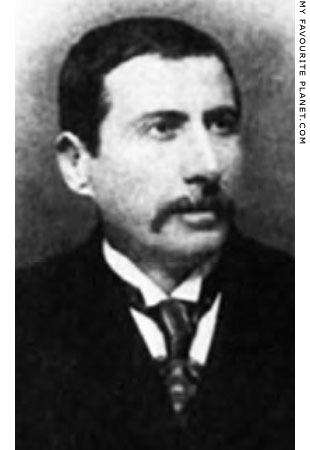
Panagiotis Kavvadias (Παναγής Καββαδίας,
1850-1928), Greek archaeologist |
|
|
11. Himilco, Syracuse, Carthage and Demeter
The temples of Demeter and Kore plundered by Himilco were outside the walls of the Syracusan suburb Achradine. The 5th century BC temple of Demeter dicovered at the Piazza della Vittoria in Syracuse may be one of those mentioned by Diodorus (Demeter and Persephone part 1).
Shortly after Himilco's plunder of the temples the Syracusans gained the upper hand and captured many of the Carthaginian ships, and the besieging army was decimated by the plague. Himilco bribed Dionysius I, the tyrant of Syracuse, to allow him to escape with his fellow Carthaginians, but left most of his army behind. He returned home in disgrace and later starved himself to death.
News of Himilco's defeat and the abandonment of the troops in Syracuse sparked off a revolt among Carthage's allied cities in north Africa. In fear for their lives, the Carthaginians prayed to their patron goddess Tanith for help, and when this brought no relief they concluded that they should assuage Demeter and Kore by offering them statues and practising their rites in the city, with the help of the resident Greeks:
"Himilco seized the suburb of Achradine, and he also plundered the temples of both Demeter and Kore, for which acts of impiety against the divinity he quickly suffered a fitting penalty. For his fortune quickly worsened from day to day, and whenever Dionysius made bold to skirmish with him, the Syracusans had the better of it. Also at night unaccountable tumults would arise in the camp and the soldiers would rush to arms, thinking that the enemy was attacking the palisade. To this was added a plague which was the cause of every kind of suffering."
"The Carthaginians, against whom the gods were clearly fighting, at first gathered in small groups and in great confusion and besought the deity to put an end to its wrath; thereupon the entire city was seized by superstitious fear and dread, as every man anticipated in imagination the enslavement of the city. Consequently they voted by every means to propitiate the gods who had been sinned against.
Since they had included neither Kore nor Demeter in their rites, they appointed their most renowned citizens to be priests of these goddesses, and consecrating statues of them with all solemnity, they conducted their rites, following the ritual used by the Greeks. They also chose out the most prominent Greeks who lived among them and assigned them to the service of the goddesses."
Diodorus Siculus, Historical Library, Book XIV, chapters 63 and 77, section 4. At Bill Thayer's LacusCurtius: Into the Roman World, University of Chicago.
The story concerning Himilco, Syracuse and the Demeter cult in Carthage are told in chapters 63-77, all on the same page.
12. Hero reliefs from the Mahdia shipwreck
Two similar reliefs were found 1907-1913 by Greek sponge divers working for the French archaeologist Alfred Merlin (1876-1965), at the wreck of a Hellenistic period Greek merchant ship off the coast of Mahdia, Tunisia (see Kastellorizo gallery page 203). The finds from the wreck, now in the Bardo National Museum, Tunis, are thought to be looted Greek artworks en route from Piraeus to Italy for the Roman general Lucius Cornelius Sulla after he had sacked Athens in 86 BC. One of the reliefs is very much like the ones above, with a male figure on a kline, wearing a polos and holding a rhyton, with a female sitting next to him and a group of worshippers on the left. On the second relief, the male figure holds a phiale (libation bowl), but the top of the head is missing. Although neither of the reliefs appear to have an inscription, they have both been described as "Asclepius and Hygieia receiving offerings". As far as I know, the healing god Asklepios was never depicted in this type of scene or shown wearing a polos.
13. "Hero relief from Corinth, restored"
Oscar Broneer, Hero Cults in the Corinthian Agora. Hesperia, Volume 11, No. 2 (April - June 1942), Pages 128-161 (drawing, Fig. 1 on page 131). The American School of Classical Studies at Athens (ASCSA). At jstor.org.
The reconstruction drawing of the relief was made by Dr. Antony E. Raubitschek. At the time the upper left fragment had apparently not yet been found.
"Several fragmentary examples have been found at Corinth, the best and largest of which has the lower half preserved (Fig. 1) ... The missing portions of the Corinth relief have been restored from a similar relief which is now in the Museum at Istanbul, but is said to have come from the Dodecanese Islands." (page 130)
"The reclining male, if we may judge from the single preserved head, is regarded as a divine figure; and the polos, commonly worn by Hades-Pluto, and later by Serapis, labels him as ruler in the realm of the dead. Likewise the woman, seated on the couch or on a separate throne at the foot of the couch, can be none other than the consort of the reclining deity." (page 133)
The only relief of this type I can recall being exhibited in the Istanbul Archaeological Museum shows the male figure without a polos (see photo below). |
|
|
| |
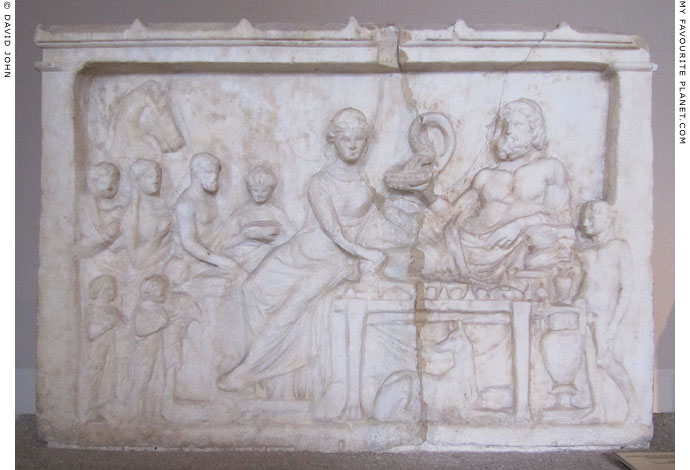
A marble relief, described by the museum as "Funerary stele with banquet (symposium) scene".
Late Classical period, 4th century BC. From Gallipolis (Gelibolu).
Istanbul Archaeological Museum. Inv. No. 407 T. Cat. Mendel 879. |
| |
14. Mylonas on Eubouleus
George E. Mylonas, Eleusis and the Eleusinian Mysteries (see note in Part 1), page 199. |
|
|
| |
| |
Photos on the Demeter and Persephone pages were
taken during visits to the following museums:
Germany
Berlin, Altes Museum
Berlin, Bode Museum
Berlin, Pergamon Museum
Dresden, Skulpturensammlung, Albertinum
Hamburg, Museum für Kunst und Gewerbe
Potsdam, Neues Palais, Sanssouci
Greece
Abdera Archaeological Museum
Amphipolis Archaeological Museum
Athens, Acropolis Museum
Athens, Agora Museum
Athens, Epigraphical Museum
Athens, National Archaeological Museum
Athens, Olympieion and Ilissos Shrines archaeological site
Corfu Archaeological Museum
Corfu, Museum of Mon Repos
Corinth Archaeological Museum
Delphi Archaeological Museum
Dion Archaeological Museum, Macedonia
Drama Archaeological Museum, Macedonia
Eleusis Archaeological Museum and site, Attica
Isthmia Archaeological Museum
Kavala Archaeological Museum, Macedonia
Marathon Archaeological Museum, Attica
Kos Archaeological Museum, Dodecanses
Olympia Archaeological Site
Pella Archaeological Museum, Macedonia
Pella, Thesmophorion archaeological site
Pyrgos Archaeological Museum
Rhodes Archaeological Museum
Rhodes, Palace of the Grand Master
Thessaloniki Archaeological Museum, Macedonia
Italy
Milan, Civic Archaeological Museum
Naples, National Archaeological Museum
Ostia Archaeological Museum and site
Paestum, National Archaeological Museum
Rome, Capitoline Museums, Palazzo dei Conservatori
Rome, National Etruscan Museum, Villa Giulia
Rome, National Museum of Rome, Baths of Diocletian
Rome, National Museum of Rome, Palazzo Altemps
Rome, National Museum of Rome, Palazzo Massimo
Rome, Villa Farnesina, Trastevere
Italy - Sicily
Castelvetrano, Museo Civico
Catania, Museo Civico, Castello Ursino
Gela Regional Archaeological Museum
Palermo, Antonino Salinas Regional Archaeological Museum
Selinunte Archaeological Park
Selinunte, Baglio Florio Museum (Antiquarium)
Syracuse, Paolo Orsi Regional Archaeological Museum
Syracuse, Piazza della Vittoria Archaeological Zone
Netherlands
Amsterdam, Allard Pierson Museum
Leiden, Rijksmuseum van Oudheden
Turkey
Bergama Archaeological Museum
Istanbul Archaeological Museum
Izmir Archaeological Museum
Izmir Museum of History and Art
United Kingdom
London, British Museum
Oxford, Ashmolean Museum
Many thanks to the staff of these museums. |
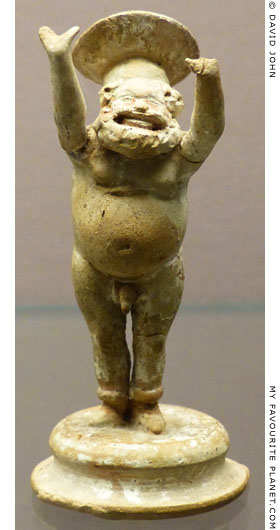
Terracotta comic figure made
at Knidos around 300 BC.
From the sanctuary of Demeter at
Knidos (see above), Yazıköy, Turkey.
The figurine depicts either an actor, or
a buffoon of the type believed to have
played a role in the Mysteries of Demeter.
British Museum.
Inv. No. GR 1859.12-26.830
(Terracotta C 473). |
|
| Photos and articles © David John, except where otherwise specified. |
 |
Visit the My Favourite Planet Group on Facebook.
Join the group, write a message or comment,
post photos and videos, start a discussion... |
|
|
| |
| Copyright © 2003-2025 My Favourite Planet | contributors | impressum | contents | sitemap |
| |











